






Staff
Valete
D-Day
Old Pangbournians remembered
OP Paralympic Champion
A warm welcome to


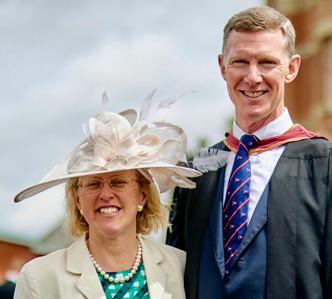

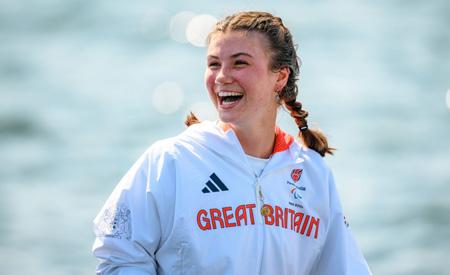
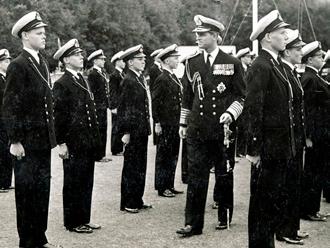
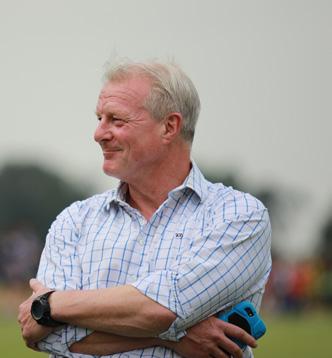
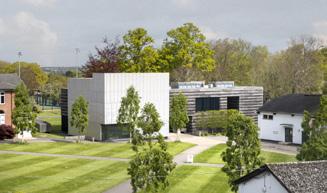

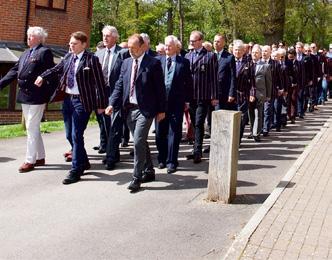







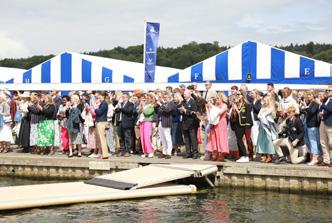

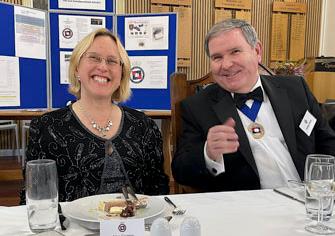
Welcome to the latest edition of the Pangbournian Magazine.
Founders Day took place on 6 July when we bid a final farewell to Thomas and Alexandra Garnier after an astonishing 19 years at Pangbourne College. As you will see in this edition we pay tribute to their combined influence upon the College over almost two decades. We also look forward to welcoming Mr Oli Knight who has taken over as Head from September.
As many of you will know, the OP weekend in April was not just marking 100 years since the first OP event that took place at the College in 1924 but the OP Society felt we should also take this opportunity to celebrate Thomas’s amazing tenure as Head.
Accordingly, Thomas and Alex were our Guests of Honour at the OP Dinner that weekend where Thomas delivered the main after dinner speech. He reflected upon his time at Pangbourne and the extraordinary degree of general social
changes that have occurred since he became Head and the consequential demands this has placed on all academic institutions. Pangbourne has been extremely fortunate to have had Thomas and Alex working collectively for the College during such times and their positive influence upon Pangbourne is apparent for all to see. On behalf of the OP Society, I thank them for this and their support to the OP Society and wish them both every success for their future after they step down in a few days’ time.
I am sure the details of both the dinner and the OP Weekend will be recited by others in greater detail within this edition of our magazine, however, I was honoured to lead a contingent of Old Pangbournians who formed up for the Sunday Parade to make a march past where Thomas took the salute with Brigadier Rory Copinger-Symes RM.
As many of you know, I am stepping down as Chairman of the OP Society at the next AGM in the October having completed the maximum term of office permissible in the Society’s Constitution and Rory will then be taking over from me. I know the Society will be left in good hands as I retire to the “back benches” of the OP Committee in October!
In this respect please forgive me if I take this opportunity to reflect on what the Society has done in recent years and I would also like to use this occasion to thank all the other members of the OP Committee as well as the OP volunteers who administer the Society’s growing Sports and Social Groups or who serve as OP University or Decade Reps. Their help and support is much appreciated. I am proud of what we have achieved together in the last four years and none of the activities undertaken by the OP Society in recent times would have been possible without their hard work.
Together we have revised the formal Memorandum of Understanding with the College and have seen new OP Sports and Social Groups become established or old ones being revived including OP Cricket, the creation of an OP Rowing Supporters Group, a Car & Motorcycle Group, establishing OP University Reps to assist current students in making university choices as well as supporting leavers joining those universities. A growing number of Decade Reps are organising informal reunions for peer groups and the established OP Sporting Groups for Yachting and Golf continue to flourish. Discussions are taking place about an OP Music group and I hope shooting
may soon become another OP activity too. Whilst regional OP events remain a challenge, there have been several undertaken over the last few years in London, and on both the East & South Coasts. Together with the College we have built a new website and with growing numbers of OPs engaging with the archive the Society has helped fund its digitisation. There has also been the provision of interactive newsletters and OP social media activity.
If any OP wants to help or has ideas for other things that OPs could do, please get in touch either with myself via alumnirelations@pangbourne.com
Again I must thank Thomas Garnier for his support in appointing Mrs Sue Carpenter as Alumni Relations Officer. She has been a tremendous asset to the OP Society and I know many OPs (myself included) appreciate her hard work to ensure Committee plans are carried out efficiently. Our Society continues to flourish but it does so only because OPs volunteer to serve on the OP Committee who remains focused on the core objectives recited in our Constitution which I can paraphrase as; maintaining the traditions of the College and the ideals of its Founders, keeping Old Pangbournians in all parts of the world in touch with each other and the College, and promoting united action
OP Society Dinner 2024


in any scheme for the benefit of Old Pangbournians and/or the College.
With a change of Government in an increasingly volatile global atmosphere, I am sure most of us recognise the challenges that all private schools will be facing and Pangbourne in particular will need a vibrant alumni organisation to support it through the stormy waters that lay ahead.
Many of you will recall that on taking office as Chairman, during the height of the pandemic that now seems like a distant memory, that I undertook a Survey of OPs primarily to see what the Society might do better. The College has requested that this exercise is repeated not just to update the data but to inquire amongst OPs about the scale and ability for OPs to help the College either financially or in kind.
As such, I would like to thank all OPs who have responded to this survey and reflected on whether they wish to offer financial support to the College now
or in some future legacy and if so for what purpose, or maybe to consider if they could support our College in kind through careers advice or similar.
As I write this I have recently returned from a Motorcycle Tour of D-Day for the 80th Anniversary of this historic event which will be recited in greater detail in this edition. I mention this now only as I was fulfilled by this trip and honoured to lay wreaths at the graves of two OPs who gave their lives in the early days of that pivotal event in world history.
Pangbourne has a proud history of service and duty and the sacrifices of such must never be forgotten. Likewise the ethos of the College and its Flag Values continue to produce well rounded young men and women today that I am sure will play a vital role in the future of this country and I know OPs recognise these values that are instilled by our former school. I am sure all OPs wish to see the College through the difficult times that lie ahead.
Finally, I would like to say it has been an honour to serve as Chairman of the OP Society and I am sure my successor will receive similar support and encouragement from OPs after I step down in October.
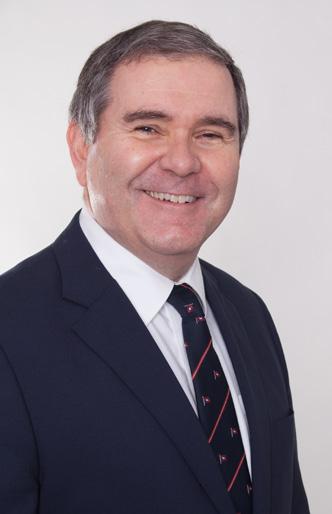
by Patrick Roberts, Chair of Governors
Thomas and Alexandra Garnier, along with their two young sons, arrived at Pangbourne for the start of Michaelmas Term 2005. They retire at the end of Summer Term 2024 having led the College successfully for nearly two generations of pupils. They joined us from Abingdon School where Thomas taught physics and was head of boarding. And, of course, prior to moving into teaching Thomas was an officer in the Royal Navy, following his family's footsteps.
Thomas set about headship with purpose from the outset. He devised the Flag Values in 2006 to articulate the spirit of Pangbourne and these have become ingrained into the ethos of Pangbourne. Their strength has endured and the Flag Values are as relevant today as they were eighteen years ago. Pangbourne pupils leave today, as in the past, with skills for life and a strong moral compass. It is extraordinary how many OPs go on to lead successful lives across a spectrum of opportunities and many attribute success to their educational grounding at Pangbourne. Thomas has led the College through turbulent times, including the financial crash of 2008, COVID 19 and the cost of living crisis of recent years. Two high points of his tenure were the visits of Her Majesty Queen Elizabeth II in 2007 for the 25th Anniversary of the Falklands War and again in 2017 for the College’s Centenary celebrations.

Both were organized with style and attention to detail. It is, however, Thomas’s total commitment to people and most specifically the pupils in his charge throughout his tenure, that stands above his other qualities. His caring and inclusive passion for people has been outstanding and the most recent ISI inspection in January 2024 reported that ‘Leaders provide pupils with high-quality education, training and recreational opportunities’. This is praise indeed from a body which is not known for superlatives. The College continues to thrive today with strong foundations as we step into more uncertain times with a desire to develop further to keep our unique place amongst independent schools.
Thomas has been supported by his family and most particularly Alex, who has been with him every step of the way for their journey at Pangbourne.
Alex was more, though, and in her own right she has contributed hugely to the College. A remarkable contribution is the establishment of the Pangbourne Piano Festival which is her brainchild. It is a wonderful event that goes far to demonstrate the breath of their joint vision. Underpinning their lives, Thomas and Alex are guided by their shared strong Christian beliefs which provide them both with strength and their moral compass.
The Governing Body and I personally thank Thomas and Alex from the depths of our hearts. We wish them all the very best for their next journey in the knowledge that they will keep in close touch with the College in the future.
Thank you.
Patrick Roberts June 2024

Thomas and Alexandra arrived in September 2005 with a very young family, at first living ‘over the shop’ in Devitt before they moved down the old drive to Derwent. From the outset, it was clear that they came as a very strong husband and wife team with a deep sense of Christian calling to serve the community here at Pangbourne.
Under Thomas’s leadership, the College has evolved and changed to the warm, friendly community we know today where individuals (both staff and pupils) can flourish and grow. Thomas was certainly ahead of his time when he introduced the Flag Values in 2006, a strategic initiative that helped define our College ethos and all that we wanted to achieve as a community. The Flag Values
have provided an important touchstone in everything that we do, especially in shaping the personal development of our pupils. It is interesting that many schools (not to mention the commercial sector) have followed Thomas’s example and defined their institutions in very similar ways.
A former Royal Naval Officer, Thomas has been innately in tune with our
by Caroline Bond, Assistant Head
ceremonial traditions, not only setting high standards, but appreciating the unique benefits that they bring to our pupils and the wider community. As a school, we have enjoyed some wonderful occasions under his tenure, notably two visits from the late Queen, to commemorate the twenty-fifth anniversary of the Falklands Chapel in 2007 and the centenary of the College

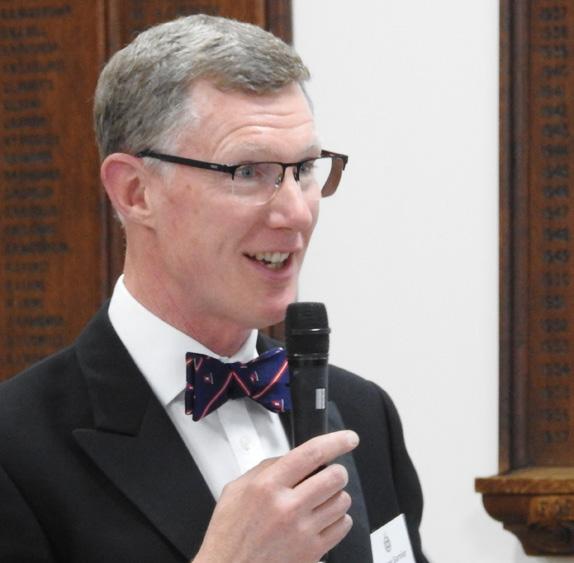


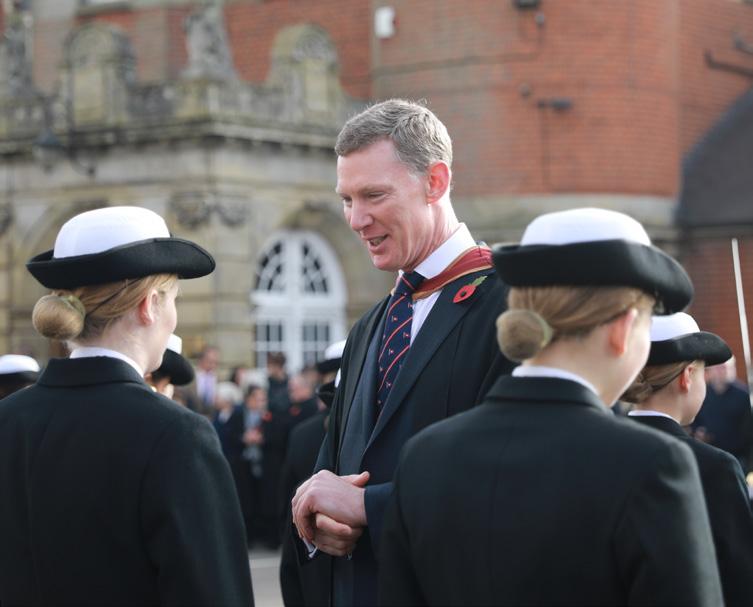
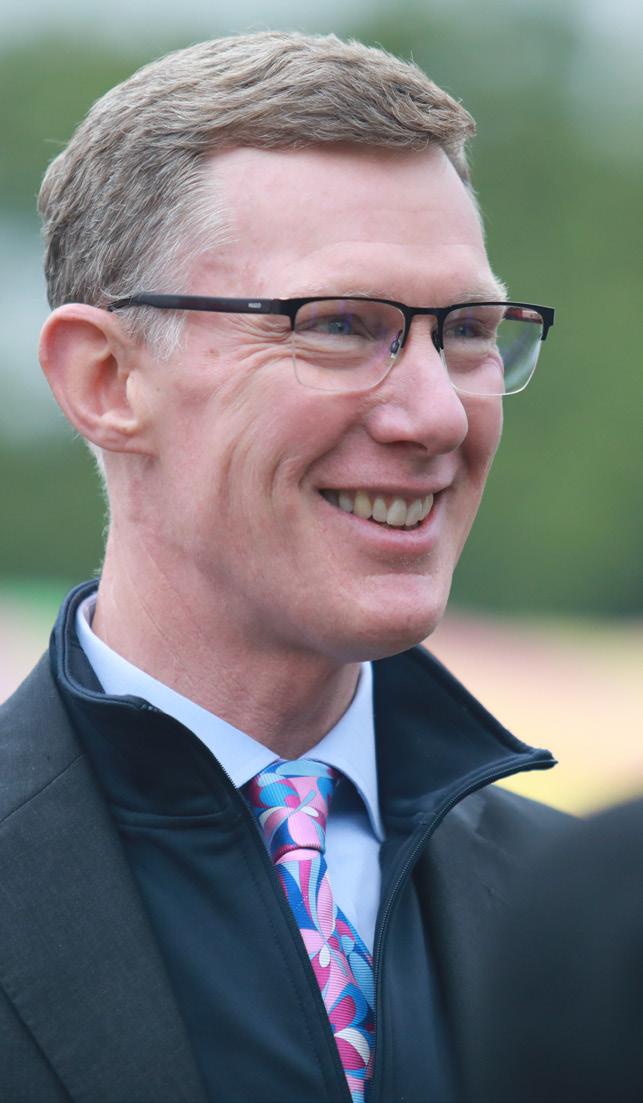
in 2017. On many College occasions, when not hosting, Alex has captured events with her exquisite photography which has told the multi-dimensional Pangbourne story in such a creative and beautiful way. The annual Piano Festival and the Weekly Bulletin have also been labours of love for Alex where her meticulous attention to detail has been very much in evidence.
On a personal level, Thomas has been an outstanding role model for the young people in our care, demonstrating the Flag Values in all that he does from his immaculate shiny shoes to the selflessness, kindness and respect he

shows everyone. An accomplished individual with a myriad of varied talents, Thomas has played a full part in the busy co-curricular life of the College, for example singing in the choir, running the 100 percent, coaching rowing on the river and holding a watercolour painting workshop on Wellbeing Day. In essence, he has personified ‘Team Pangbourne’ in so many different ways. Moreover, the calibre of the man is such that he has not only attracted high quality teaching and operational staff, but also marketed the school well and encouraged parents to send their children to Pangbourne.
The Common Room has appreciated Thomas's strong and steadfast - but caring and compassionate - leadership, not least during the pandemic, when Pangbourne taught online lessons from day one, undoubtedly setting us apart from our competitors. When staff were working hard, they also knew that he was at the helm, working tirelessly and selflessly on their behalf.
To conclude, Thomas and Alex have been very loyal servants of the College who have dedicated their lives to the community over the last nineteen years. They leave an outstanding legacy and we wish them every success in the next chapter of their lives.

On the 20th June, members of the board congregated in the Old Library for the official presentation of a specially commissioned portrait to mark the Head’s nineteen years at the helm of the College.
The portrait, which was a joint commission from the College and the OP Society, is the work of professional portrait artist, Mark Draisey, who is based in Oxfordshire.
Mark, who specialises in creating traditional portraits for the modern era, has previously been selected for the BP Award at the National Portrait Gallery as well as for the Royal Society
of Portrait Painters' exhibition on numerous occasions.
There is a tradition of marking the service of the Heads of the College in portrait form and this stunning portrait of Thomas Garnier will now join those of Sir Thomas and Sir Phillip Devitt as well as those of Anthony Hudson and Kenneth Grieg.
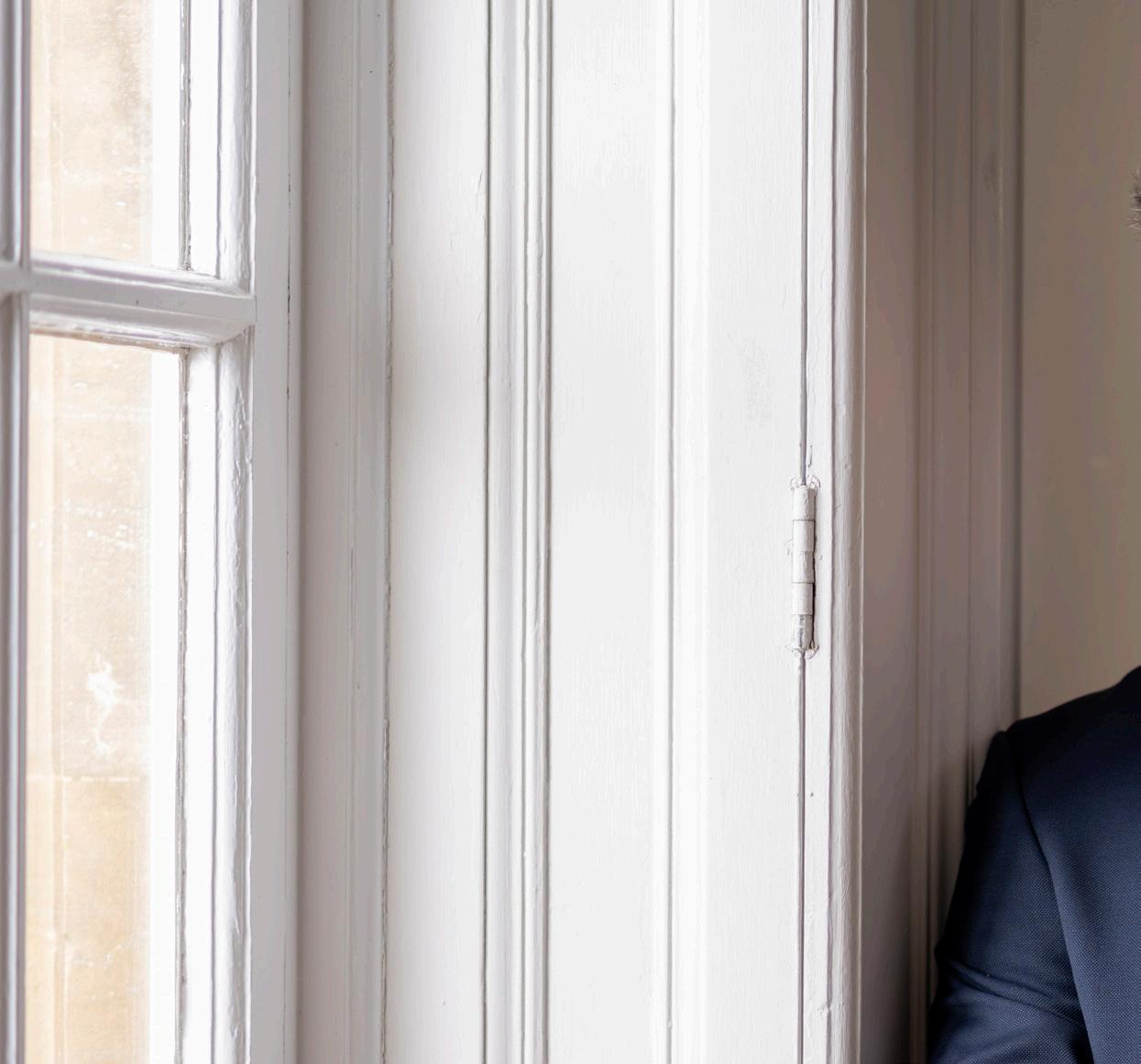
Before being appointed to Pangbourne, what was your background in education?
I have spent the past decade as a Head of inner-city London schools, serving disadvantaged communities who are marginalised and have historically been excluded from the national discourse.
I have taken three schools out of a low Ofsted category to be successful and functioning organisations with a strong track record of Oxbridge, medical school and Russell Group access, alongside degree apprenticeships.
Five of my Deputy Heads are now successful Headteachers. I have also written extensively on curriculum design, headteacher decision-making and heuristics.
What inspired you to work at Pangbourne?
Pangbourne’s focus on a holistic education, with the individual sitting within a supportive community, speaks to me both as a Head and as a parent. Pangbourne's focus on character, on sport, on adventure, on service; these are
all crucial aspects of an education, but are often missing or unachievable in the maintained sector. Pangbourne is my dream school.
How was 2023 for you?
Incredible. We took my last school from an Ofsted category of ‘Special Measures’ to ‘Good’, secured access to Russell Group universities at twice the national average for similar schools, and launched a sports scholarship programme with human performance teams from Formula 1. It was a transformative year for the school’s community.

Are you introducing anything new for 2024?
Other than myself as the new Head, I want to get underneath the surface and really understand how the vision and ethos work in reality at Pangbourne. I want to nurture the values-led education model that Pangbourne offers, as well as help pupils to be academically ambitious through a curriculum that stretches all pupils, regardless of ability.
Outside of work, what are you looking forward to this year?
I am looking forward to moving my family to Pangbourne and becoming fully immersed in the community and seeing my children thrive. On a personal level, I am excited for my regular trips to the high mountains to climb with friends and enjoy the spirit of alpinism –freedom, self-reliance, adventure.
Who has been your educational inspiration?
The person who has most shaped my educational beliefs would be Christine Counsell. She has argued for over two
decades on the role that knowledge plays in enabling young people to make sense of and participate fully in the world around them.
The world we are preparing our young people for is constantly evolving – how do you lay the best foundations to prepare pupils?
In a constantly evolving world, our pupils need to have developed the schemata necessary to cope with the deluge of information they are now presented with. These schemata are mental structures of ideas and words that influence the attention we can give to new information and free up working memory to embrace new content and think about what we are being presented with. This enables them to differentiate fact from opinion and not be dragged down by dogma and misinformation. What book would you implore all pupils to read and why?
Linked to the sense of change and flux present in the modern world and with the multiple futures we are presented with, I would implore all pupils to read ‘Sapiens: A Brief History of Humankind’ by Yuval Noah Harari. Whilst there are inevitable critiques of a work such as this, by the nature of its scope it reminds us all of our shared human story and the role we can play in imagining a different future for the planet
How would you like each pupil to reflect on their time at the College?
I would therefore like my pupils to reflect on their time at College as a period of joy through being immersed in the academic study of our world and understanding who they are and what drives them. Enabling them to leave and live a life full of choice and opportunity.

I’m Frankie Allen (15-20), former Head of Girls’ Boats and CCC of Illawarra.
Since 2022 I have been representing Great Britain rowing in the PR3 Mixed Coxed Four and the PR3 Women’s Pair categories.
For the last two years I have been training full-time at the British Rowing Training Centre in Caversham in preparation for the Paris 2024 Paralympics.
Here are my memories on the run up to the games, the races and the aftermath.
This is my third season in the GB Para Rowing Team.
Training takes place at The Redgrave Pinsent Rowing Lake in Caversham six days a week. We normally have two or three sessions on the water and in the gym. Then in the afternoon we go to Bisham Abbey for strength and conditioning sessions.
Caversham is an amazing complex, and we train with the Men’s and Women’s squads everyday. I remember coming to Caversham for the first time being totally overwhelmed by just being in the same building as all my rowing heroes!
Back to the run up to Paris.
Firstly, we had to qualify the boat for Paris, which we did by winning the World Championships in Belgrade in September 2023. It was incredible to be a part of the crew to do this, but it didn’t mean that I automatically got to row in Paris. I still had to fight for my seat. The training schedule was very tough on the run in, and we had a series of time trials and seat racing until the crews for all the boats were confirmed. I was in!
This was one of my favourite days before the actual games. We all went to Loughborough University where we were greeted by a team of ‘personal
shoppers’ who spent the day kitting us out with all the different kits we would have to wear during the games. We came back with a big suitcase full!
Crew reveal Trafalgar Square
This is where it really started to feel real. We had a photoshoot at 7am in Trafalgar Square, thankfully it was sunny.


“Hi Frankie, it’s Keir here”
Whilst the training was ramping up, so was the media interest and coverage. One afternoon I got a message asking if I’d like to take a call from the Prime Minister. I thought it was a wind up!
It was an honour to have been chosen as one of three paralympic athletes to speak to Sir Keir Starmer wishing all the athletes good luck at the games.
My phone rang, “Good afternoon, this is Number 10 Downing Street, are you ready for your call with the Prime Minister?” My heart jumped, and then he was speaking, “Hi Frankie, it’s Keir here…”
Before I knew it, we were heading to Paris to stay in the Athletes’ Village.
Everything you have read about it is true, it’s huge! Our beds were made of cardboard and the mattresses old fishing wire. The food hall was about half a kilometre long, and had every food you could think of, including Michelin starred dishes, which were always very popular! There were shops, bars (all 0% alcohol, of course), coffee shops, hairdressers and even a tattoo studio. With over 4,000 athletes staying there, the buzz was incredible. We all had bikes to travel around the village, but mainly I liked walking around and meeting competitors from all different nations and sports. We were given GB pins to swap with other athletes. Being athletes, this quickly became incredibly competitive to see who could get the most obscure and rarest designs!
Our race day pre-race preparation is extremely precise and well timed. We fuel at specific times to be at our best the moment of the race. It was all going
nicely to plan. We’d heard that Ben our PR1 athlete had won his heat with a Paralympic best time in the first race of the morning. This was looking like a fast track, and we were primed, fuelled and ready to go. Then everything stopped, there was a storm on the way, and everyone had to get off the water. Thunder, lightning and monsoon rain followed. The crowd had to take cover under the stands. Then as soon as it had come, it blew through, and we were ready to race again. We refocussed, refuelled and raced, winning our heat and breaking our own world’s best time by over three seconds. We were in the final.
I didn’t sleep much the night before the final. It’s just another race I kept telling myself. But somehow the enormity of the occasion kept creeping into my mind.
We had done well in our heat and had been faster than the USA (our main rivals) in their heat, by nearly 10 seconds. But you never know what will happen. There is a saying “teams turn up for

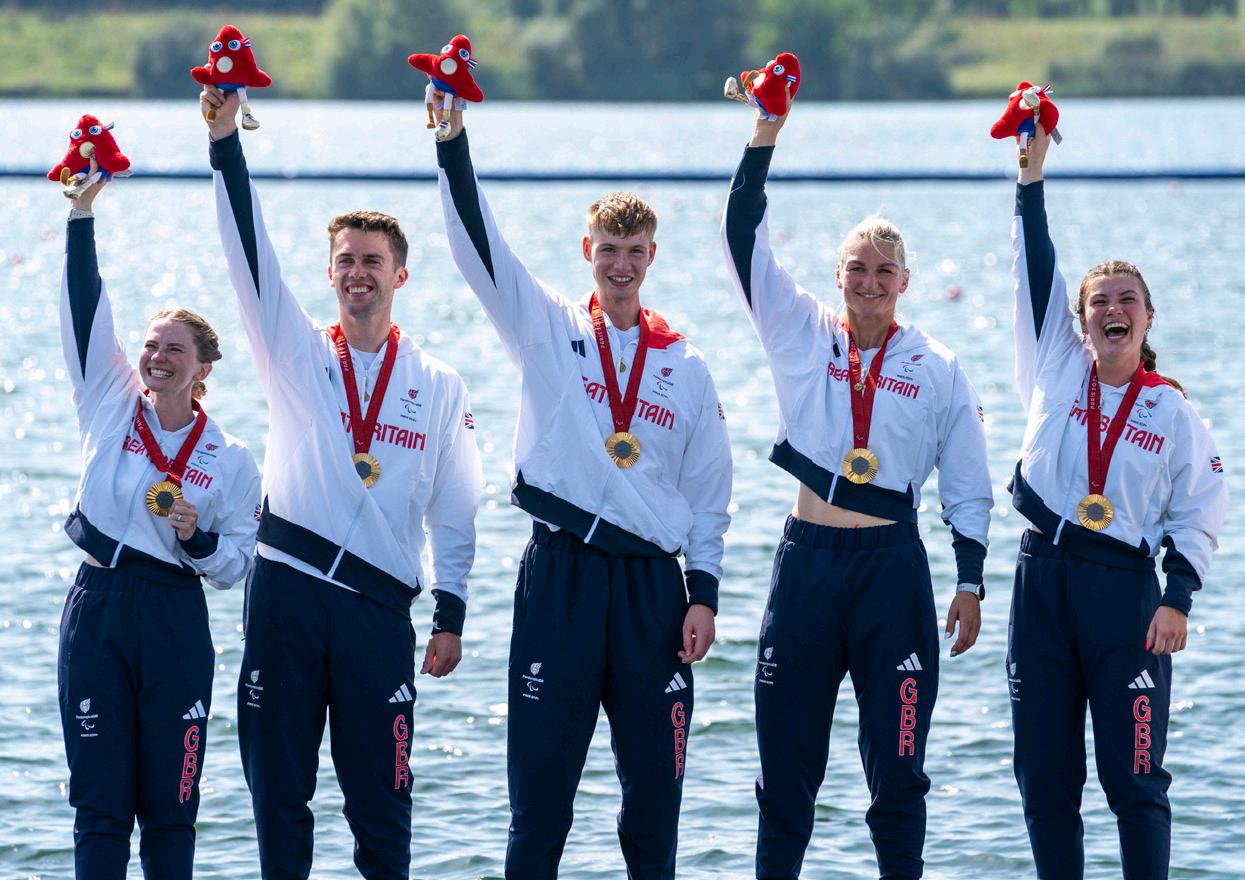
medals” and crews can always spring surprises, especially when the biggest prize is up for grabs.
We had a race plan and we needed to execute it and not be distracted by what anyone else was doing in the lanes beside us.
The race went to plan, we held off the USA and won by just under four seconds. I didn’t notice the crowd during the race until the last 500 metres, and when we crossed the finishing line, the wall of noise just hit me. We had a sellout crowd of over 10,000 and they were certainly making their presence known.
Straight after the race we were whisked off to do the media interviews and once they were completed, we had the medal ceremony on the side of the lake. I could hear “Frankie, Frankie” and managed to spot all my friends and family who had come to the lake to support me and the crew.
At this point I have to say a huge thank you to everyone who has supported me. To those who were able to come out to the lake. We had supporters from aged 8 to 88! A big shout out to my Old Pangbournian friends who made the trip! And to everyone back home who screamed at the TV or watched surreptitiously on their phones whilst in meetings, thank you it meant everything to me.
After the medal ceremony, we left the lake, and I spent the afternoon doing more media interviews. Then we went to GB House where I got to ring and sign the victory bell. This was an amazing and humbling experience to be asked to do the same thing that the paralympic greats had done before me.
Before I knew it, it was time for more media interviews and then a celebration reception at GB House. After the

reception we all descended on a small bar by the banks of the Seine to celebrate. I don’t think they were expecting over 100 athletes friends and families but they greeted us with open arms and open bottles! The Australian crews also joined us which was lovely.
Tired but still buzzing, the following day I managed to spend some time with my family and friends in Paris. We did the sights, and again (out of the village) I noticed just how busy and exciting Paris was with all the other sports taking place around the Eiffel Tower and the Seine.
Then it was time for a guest appearance on Channel 4’s The Last Leg where we had to swing host Adam Hills like a cox whilst he read out the next day’s events. I was so scared I’d drop him, but thankfully I didn’t!
The following days were a mix of media interviews and downtime with my fellow athletes. I managed to see some other sports which was amazing to experience.
We were invited to a celebration reception at the British Embassy, but I think the highlight was certainly tea with Royalty!
I was honoured to be chosen to have dinner with HRH The Duke of Edinburgh on the day that he and HRH
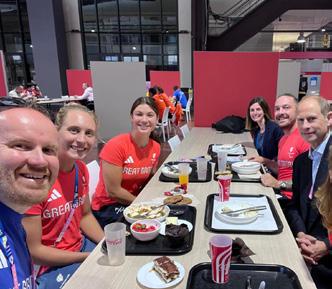
The Duchess of Edinburgh were visiting the games to support the GB athletes.
And then it was the Closing Ceremony. We entered the Stade de France to a massive roar from the 64,000 sell-out crowd.
Again, this was another incredible experience and we danced for hours as it turned into one epic party saying au revoir to everyone.
With very little sleep and still running on adrenaline, it was time for the Eurostar train back home. I managed to grab a little bit of sleep in between media interviews on the train. We then had a Welcome Home Reception in London where my parents came to pick me up. This was a very emotional time, saying goodbye to my crew mates and the friends I’d made from other sports.
We then had the Paralympic Homecoming Party in Birmingham which was fantastic. Then it was back to reality for all of us.


At the end of a Paralympic cycle, we are all allowed some time off to decompress, relax and catch up with the people we weren’t able to see in the run up to the games. I am now going to spend some time completing my degree in physiotherapy which I put on hold to concentrate on the games.
Then, before I know it, I will be back in the boat, training and setting my focus on 2025!


Mrs Samantha Greenwood, a distinguished and much loved figure at Pangbourne College, is bidding farewell this summer after 12 years of dedicated service and leadership.
by Richard Follett, Deputy Head Co-Curriculum
Sam's journey at the College began in 2012 when she joined as Head of Mathematics from Marlborough College. She quickly established herself as an excellent teacher, with absolute command of a classroom and outstanding subject knowledge. Regardless of the sets she taught, she demanded the best from her pupils and was tenacious in not letting them settle for less. These traits, combined with a great work ethic and administrative efficiency, contributed to her rapid progression through various leadership roles.
By 2015, Mrs Greenwood had taken on the role of Head of Key Stage 4, overseeing the academic and personal development of students in Years 10 and 11. Her empathetic approach and communication skills enabled her to connect with students on a personal level, addressing their concerns and guiding them through critical stages of their education. She worked closely with parents and teachers to ensure that each student received the support and encouragement they needed to succeed. One abiding aspect of her in the role was the fact that pupils would come to her for advice, not just to be given platitudes, but fully accepting that she would ‘say it how it is’, even if that meant they left her office with further work to be completed. They all accepted that her advice came from an overarching desire for them to succeed to the best of their abilities.

Mrs Greenwood’s career trajectory continued apace and she quickly moved into the upper echelons of the Senior Management Team, progressing to Deputy Head Academic, then Deputy Head of Character and Routines, a role concerned with values, standards, and discipline, and finally Senior Deputy Head in September 2022.
In the latter two of these roles, she insisted that standards of uniform, punctuality, and behaviour were maintained by staff and students alike. Her office, at times resembling a lost property department, became a testament to her commitment to upholding these standards. But it would be a mistake to think that she has enjoyed this aspect of her role. She has challenged infringements because she had the
responsibility to do so, and received admiration from the staff for the integrity and moral courage she has shown, and the resilience she has needed, day in, day out, in the pursuit of improved standards. For those of us who know her better, she has been a supportive, honest, industrious and selfless colleague ― and great fun to work with.
Her leadership in helping to shape the College's ethos and values in recent years has been profound. She was instrumental in developing programmes and initiatives that promoted character development, resilience, and a sense of responsibility among students; efforts which created a positive and nurturing environment where students could thrive both academically and personally.


Mrs Greenwood has also been actively involved in various extracurricular activities, enriching the lives of many along the way. A passionate supporter of the Duke of Edinburgh expeditions, she dedicated her time and energy both during term time and in the holidays to helping students prepare for and participate in these challenges and rewarding adventures. Every year she would head out to Llangorse with the whole of Year 9 for their week practising for their Bronze Expedition, before later in the term accompanying the oldest students with their Silver and Gold assessments. Her enthusiasm for outdoor education and her commitment to student development were evident in her involvement, which fostered teamwork, resilience, and a love for the outdoors among participants.
Mrs Greenwood's dedication to her own family has been an integral part of her life at the College. It is always a delicate juggling act as a teacher parent, often sacrificing precious moments supporting one's own children for the greater support of the whole school. When opportunities arose however, as a proud and devoted mother, she was often found on the sidelines cheering on her son Ben at rugby and cricket matches and her daughter Emily at hockey and netball games.
As Mrs Greenwood leaves Pangbourne, her absence will be keenly felt by the whole College community. Her leadership and compassion have set a high standard for all who follow in her footsteps. For those who know her best, she has been a sincere, encouraging and dedicated teacher and colleague, and above all, she completed almost everything she did with a smile on her face.

In the summer the first King Charles III Gold Medal was awarded to Archie McAlister, who was one of the two Chief Cadet Captains of College in 2022-23. Due to the change of monarch, the medal could not be cast in time for it to be presented on Founders Day 2023.
Archie is now in New Zealand so his parents received the gold medal on his behalf.
Archie, along with Jemma SwireThompson and Grace Hessian, took part in Queen Elizabeth II’s funeral procession in London in 2022.
To commemorate their involvement in this important state occasion, Iain Young and Alexandra Garnier created this unique artwork pictured above.



A large batch of archive material was recently sent for digitisation, including a number of rusting film canisters. We had no idea what was on these films or even if they would be in good enough condition to be digitised.
So, when the email arrived from the digitisation company stating that all the material, including the films, was now available to view, there was a certain amount of excitement tempered with trepidation. Were we in for an amazing discovery or deep disappointment? Well we are delighted to say that the former was the case!
We are now the proud possessors of four short film clips of cadets from the 1930s and 40s. While it's not possible at this stage to accurately date the films,
some research involving the archive's photographic collection suggests that two of the clips may be from Founders' Day 1941. Also in the archive treasure chest are a number of Admiralty Office instructional slides from the 1940s encompassing subjects such as Flag Recognition and Anchor Work.
The College first appeared on film in its founding year, 1917. Grainy film clips exist of Sir Thomas Lane Devitt and Captain Superintendent Montanaro at the opening of the Nautical College
Pangbourne in the presence of the Second Sea Lord, Vice Admiral Herbert Heath. The next time the College appears on film is in 1925, when Pathé News reported on the inspection of the Cadets by the Admiral of the Fleet, Earl Jellicoe, Commander of the British Grand Fleet at the Battle of Jutland in WWI.
Pathé News crews would continue to be a familiar site at Pangbourne over the years, covering a number of Founders' Days in the 1920s and 1930s,

however, two stand out reels date from the 1950s. In 1953 His Royal Highness Prince Philip was the Guest of Honour on Founders' Day, During the course of his visit he laid the keystone for the new building that would become the home of Macquarie, as well as presenting the prizes and watching a number of displays, all of which was captured by the cameras. Perhaps the most evocative piece of film was recorded in 1958 and is entitled ‘Navy Cadets’ (aka Public School Cadets). Narrated in the clipped tones of the presenter, and with suitably jaunty music in the background, the film is very much of its time and all the more fascinating for it. All of these clips can be found by visiting YouTube and searching for Pangbourne College. Today, with the advent of mobile phone cameras and digitisation, anyone can become their own film crew, which only serves to make these historic films more precious.



The world of education has changed a huge amount over the last 30 years and teachers like James Bamforth are certainly a dying breed. Indeed, he is unapologetically ‘old school’ in his ways, something that both his colleagues, his students and their parents will miss as he says his final farewell to Pangbourne.
James Bamforth - known as ‘WJB’ in College documents and simply ‘Bammo’ to most - has had a long, distinguished career in education. Since graduating from Cambridge University with a degree in Classics in 1988, he moved straight into a career of teaching, enthralling countless students with tales of Ancient Greece. After completing his PGCE, he worked at Radley College (1989-2001) before heading down the A34 to Pangbourne. His first year was spent as the Assistant Housemaster in St George before moving into Macquarie in September 2002 as Housemaster with his wife Charlotte.
In all these posts, James was far more than just a teacher - in fact, I am confident that he would refer to himself as a schoolmaster. As Housemaster of Macquarie he immediately made a positive impact. Contemporaries of mine who were in Macquarie at the time, enjoyed the relaxed but purposeful atmosphere he created. Always approachable and willing to chat, he was an ideal person for the role. Of course, James fitted a lot into his working weeks with teaching and caring for the boys only part of his workload. His passion for the water saw him coach rowing where he was an ever-willing, reliable and very experienced coach at the river. Rarely was he more able to
combine his Classics background with stories of classic races of his crews from previous years. His coaching methods were a mixture of the slightly less ancient and modern too. James' crews could often be found in the ergo room at the Boat Club, spending considerable time tied to an ergometer learning how to hang off the handle, while James clung for dear life to the other end of a boat tie while the boys were unable to actually row. The boys very much bought into his style and loved the way he could cajole every last calorie of effort out of them. Year after year, James would happily take the crew other coaches were less keen to take on, invest his confidence in them and they would respond in kind, believing in him as they would head towards the key races of the season with renewed hope and determination.
James was known across the College rowing world for his pre-race motivational speeches, which became affectionately known as "the speeches before Agincourt", although he may never have known this.
On many occasions in the summer, James would 'treat' his crews to various single sculling challenges, almost all of which would result in the scullers ending up in the river on the highly tenuous theory that it would help with sculling balance or speed. The previous College boatman
Phil could be heard cursing in his workshop throughout, fearing the worst for the equipment, never mind the boys in the river. James will be dearly missed by all at the Boat Club. The Christmas Day Hour of Power will live long!
After several successful years at the helm of Macquarie, teaching Classics and coaching on the river, James moved into his current role as Head of Sixth Form in 2011 - a position which has seen him positively influence the lives of over 800 Pangbournian Sixth Formers and a role he has held with distinction ever since. Throughout this time, he continued to teach his beloved Classics and hosted the annual trip to Greece - a highlight for many, along with the many ski trips he has run over the years!
One thing that I have always admired about James is his teaching style. Whilst it has moved on slightly from the good old days of ‘chalk and talk’, there is never anything too fancy about his lessons. Indeed, in a world of new age technology and advanced teaching strategies, this did not matter. His passion for the subject, incomparable knowledge and his care for each student in the classroom always produced the results and generated wave after wave of students who would return many years later in search of their inspirational Classics teacher.


Conducting business in his usual style and maintaining his own approach to education along the way, James is a teacher who is all about the journey and the experience. His values and determination to do what is right by his charges is visible each and every day and there is a clear ethos to his work. His time as Head of Sixth Form has, quite literally, shaped a generation of Pangbournians whom he hopes, and often quotes, are “acceptable at a dance, invaluable in a shipwreck!” More recently, increased competition from other schools and Sixth Form Colleges has allowed James to develop the Sixth Form years further, introducing a greater range of subjects, BTEC options, more information on apprenticeships, opportunities for teamwork and leadership, and a wide reaching, ever interesting General Studies programme. However, whilst these changes have taken place, nothing

has changed James steadfast in the belief that the Sixth Form is an experience for the students and education is about the relationships formed, something we must always remember.
Perhaps one of the greatest legacies from James’ reign as Head of Sixth Form at Pangbourne was the remarkable Taking Responsibility Course which, like the Year 9 trip to Llangorse, will be amongst the top memories of any Old Pangbournians of recent times. The course has steadily grown over the years into a week-long behemoth which we are faithfully told, took months in the planning. Those who see his ‘working document’ come to life, know that at the heart of it, sits James’ aspirational desire to influence the students and prepare them for their final year at the College and later life.
The course - which runs just after the summer Half Term holiday - is a real turning point for many students and James’ infectious, enthusiastic nature always sees every pupil take a huge amount from it as well as staff clamouring to be involved. Every year, new activities and stances were added to the course - perhaps an additional obstacle course would be good? Shall we introduce some Colour Profiling? What about some paddle boarding? More interview skills this year! We need a second churchyard to cut the grass! It is therefore a wonderfully varied and busy few days which sees the L6 running around the campus, the catering team trying to keep up and staff pulled from pillar to post. This year's final document was published with the title “New THIS Master Version TR TImetable 2024” (copied verbatim). However, those of us who have known James for many years knew that this was not a sign of a hastily put together
document, but rather a document put together by someone who is much more interested in the purpose of the week, rather than the detail. Rest assured, as is his way, the 2024 edition of the course was yet another resounding success, fulfilling its purpose, working like clockwork, putting smiles on the faces of everyone involved and generating yet another year group who are ready to take the lead next year.
As a side note to this course, it was interesting that James - a man known for a traditional approach to educationreally embraced the concept of Colour Profiling. This is a form of psychometric testing, used to identify an individual's traits and how they can be best used. Since being introduced to the concept, he has become a passionate advocate in using the tool to help the Sixth Form understand each other. His own report sat him firmly in the ‘yellow quadrant’, describing him as free-spirited, friendly, enjoys networking, inspirational, lively, sociable, spontaneous and imaginative. With such accurate results, it is no surprise that he believed in it so much.
During his last ‘Taking Responsibility’ dinner, James spoke of the hundreds of Sixth Formers he has guided through Pangbourne. The final years at school are often challenging and you need someone with a wealth of knowledge to lean on. The UCAS process is just one example but James knew exactly how to approach this and, with contact, in several universities and an ever-present willingness to pick up the phone to chat with an admissions team, he has often made the difference for individuals on results day. That said, often his work does not end when students leave, and it is common to see a former student
walking to his office to discuss a deferred placement, an updated UCAS reference or even the occasional resit.
There is an Ancient Greek proverb that states “a society flourishes when old men plant trees whose shade they know they shall never sit in.” Whilst James is certainly not an old man - his recent completion of the 125 mile Devizes to Westminster canoe race is a testament to that - the proverb certainly reflects the impact that he has had on those Sixth Forms he has seen through their final two years at College. He works hard, always looking for ways to improve the quality of the ‘Sixth Form Experience’ and is tireless at encouraging and cajoling students through to exams and towards important decisions on where to go, or what to do next. In his biography on the Pangbourne website, James Bamforth suggests that “the Pangbourne 'product' is special. In the main, Pangbournians can effectively collaborate; they 'walk with kings, nor lose the common touch'; they genuinely demonstrate kindness and integrity in their lives and are probably the most comfortable in their own skin.” Isn’t it funny that whilst this is what he wants for his students, it is exactly how many would describe James himself?
Returning to his beloved Classics, the famous Heraclitus once said “there is nothing permanent, except change.” With this sentiment, the philosopher reminds us that the universe is constantly changing and, to find peace, we need to accept this. This is true of our College and the Pangbourne community will return in September for another academic year. However, without Bammo, I’m sure it is going to feel slightly different.

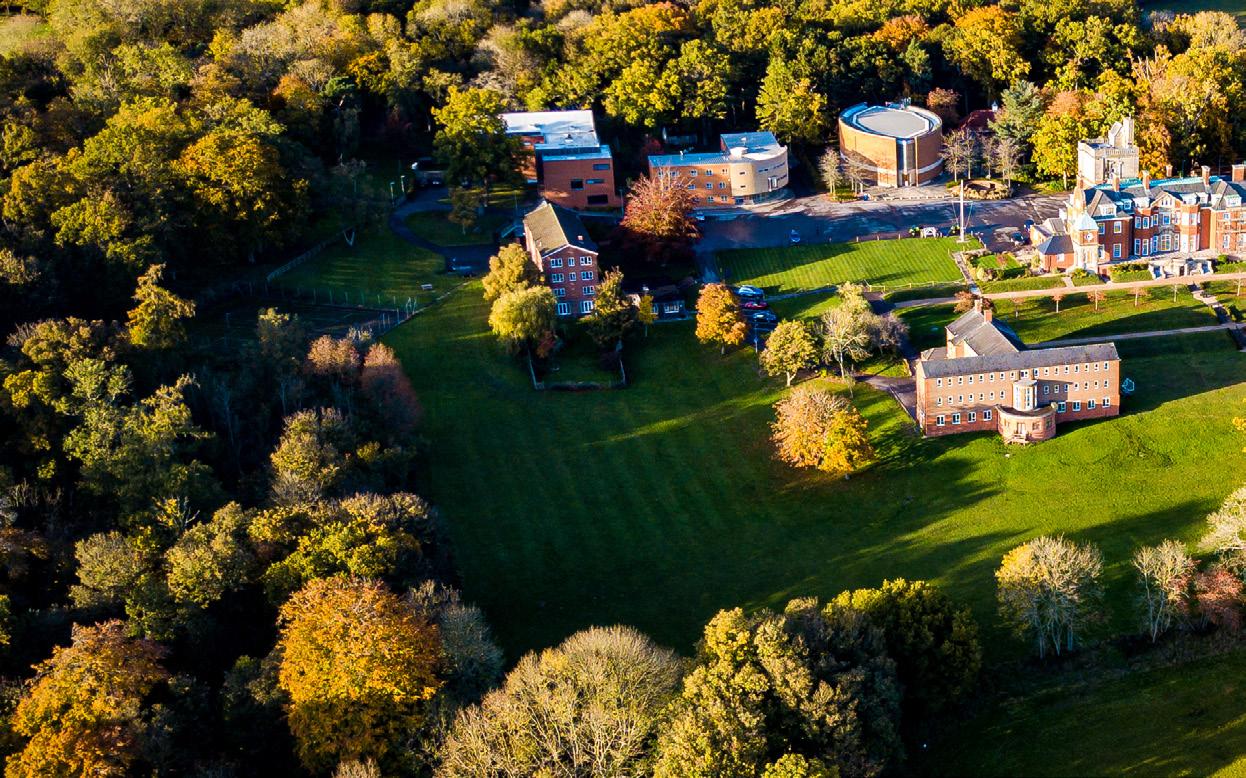
Pangbourne College’s story began in 1917, thanks to the vision and generosity of Sir Thomas Lane Devitt and his son, Sir Philip Devitt. Today their legacy lives on in a thriving College where pupils continue to benefit from the Devitt family’s philanthropy, alongside the support of countless others across generations since.
Whilst fees continue to fund the College’s running costs, these are sadly not sufficient to fund major new developments, or the opportunity to
offer significant levels of bursaries to those who would benefit from a Pangbournian education but cannot otherwise afford it. From its
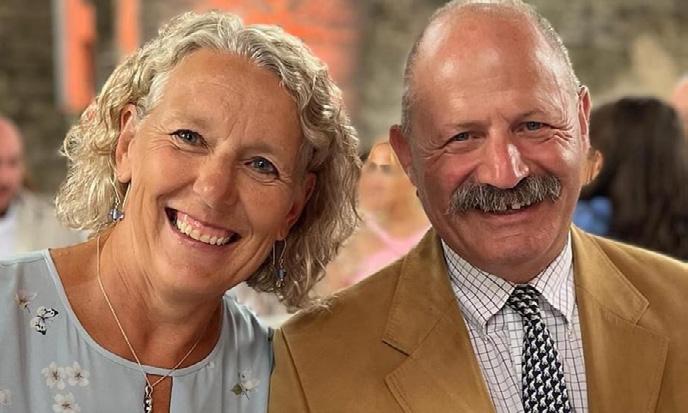
establishment in 1917, the College has relied upon philanthropy to make a truly transformative impact on the lives of its pupils. Here, Pangbournians share how and why they are helping to provide a stronger, brighter future for the College and its pupils.
Former parents, Nigel and Sally Rossiter: “We support the College on a monthly basis, with a specific focus on the Transforming Futures campaigns to provide bursarial support for those who wouldn't otherwise be able to benefit from the College education. Over time our contribution has accrued to a significant amount through multiple contributions. When put together, they make a meaningful difference to the future of the College and its pupils.”
Mark Dumas (63-68), President of the Old Pangbournian Society and the Devitt Legacy Society says: "I want to help generations of Pangbournians benefit as I did, so I am leaving a legacy for the College in my will. My aim is to


support the College for the long term and secure an even stronger Pangbourne in the future.”
To find out more about the different ways you can support the College, visit pangbourne.com/supportus or contact Lucinda Grafton, Head of Development, on 0118 976 6697 or lucinda.grafton@pangbourne.com
£1.66m committed by the College community to support capital projects and bursarial funding.
The 1917 Society, named after the year the College was founded, celebrates the continued generosity of our community. Members of the Society support pupils through providing a stream of gift income which helps the College plan for the future and benefits Pangbournians for generations to come.
Celebrating our history whilst looking ahead to our future, the 1917 Society members benefit from invitations to exclusive events, as well as regular communications. There are two levels of membership: Head’s Circle and Member. Members have donated £1,917 or more in total to the College, Head’s Circle Members donate £1,917 annually to the College.
In recognition of an accrued donation of £1,917, or an annual gift of £1,917, the College is honoured to welcome Pangbournians into the Society.

By George Picker, Assistant Director of Music
Thanks to the generous support of the College community, the Harding Communications Centre, which opened its doors in 2012, has become an integral part of music education for students of all ages and abilities at Pangbourne College.
The classrooms within the Harding Communications Centre have been carefully designed to enhance the learning experience of every music student, whether they are beginners or advanced musicians. Each room is acoustically optimised, ensuring that students are about to rehearse and perform in the best possible setting. This attention to detail helps create an environment where students can focus on developing their musical skills.
The flexible layout of the classrooms accommodates both individual and group learning, making it a space that caters to a wide range of educational needs. Whether it’s a one-on-one piano lesson or a full choir rehearsal, the Centre
is well-equipped to support the musical development of all students.
The recording studio is another exceptional feature of the building. This state-of-the-art facility enables pupils to record music, learn production techniques, such as editing and mixing, and understand the principles of audio technology.
One of the features of the Harding Communications Centre is its impressive fleet of Steinway pianos. Renowned for their exceptional craftsmanship and superior sound quality, Steinway pianos are the gold standard for musicians worldwide. The fact that the Pangbourne houses such a collection
of these world-class instruments is a testament to the school’s dedication to providing the best possible resources for its students. The pianos are used daily for a wide range of musical activities, including lessons, rehearsals, and practice sessions.
The Nancye Harding Recital Hall: A Platform for Performance
In addition to its exceptional classrooms and pianos, the Harding Communications Centre is home to the Nancye Harding Recital Hall. This space has become an invaluable resource for students, providing them with a space for rehearsal and more intimate concerts or recitals. The Hall’s excellent acoustics and design make it an ideal setting

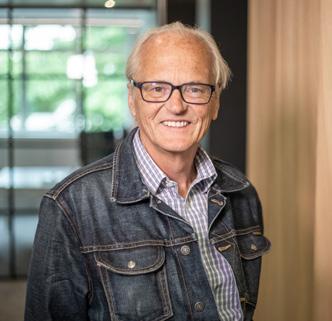
for a whole host of different occasions and events. For many students, the experience of performing in the Recital Hall is a pivotal part of their musical education here at Pangbourne. It is also a facility that is used by the College for parent and alumni events, benefitting the whole College community.
The Harding Communications Centre stands as a testament to the school’s commitment to providing exceptional music education. From its state-of-theart classrooms to its fleet of Steinway pianos and the versatile Nancye Harding Recital Hall, the Centre has become a cornerstone of the music program, nurturing the talents and creativity of students at all levels of attainment.
“I am very pleased to see the educational impact the Harding Building has had for over a decade, providing a facility worthy of the College’s high-quality music provision. I hope the facility will continue to house and inspire Pangbournian musicians, as well as the whole College community, for generations to come.” David Harding (72-78)





By Sue Carpenter
Over the decades the College's nautical history and traditions have inspired an impressive number of Old Pangbournians to choose a career at sea, but with a shared terminology and opportunity for global travel, a significant number of Pangbournians have also chosen a career in the skies.
This article celebrates all those OPs who swapped sea ports for airports and the boat deck for the flight deck. It's at this point that I should admit to a certain amount of bias on this subject, with an aviation background and both a spouse and OP son who are pilots, but it was an email correspondence with OP Rob Sargent (61-65) that really provided the inspiration for this article.
The modern age of aviation actually began 240 years ago with the first
untethered lighter than air flight by a human being on 21 November 1783, in a hot air balloon designed by the Montgolfier brothers. 120 years later and the Wright brothers made the first successful heavier than air flight at Kitty Hawk in North Carolina. During WWI, aircraft were being used for reconnaissance, artillery spotting and rudimentary bombing missions.
During the interwar years, huge progress was made in the field of aviation,
including the first transatlantic flight of Alcock and Brown in 1919, Charles Lindbergh's solo transatlantic flight in 1927 and Amelia Earhart's solo transatlantic flight in 1932.
With the advent of war in 1939, scores of OPs enlisted with either the RAF or the Fleet Air Arm. By the end of the war, OPs in the RAF had been awarded 2 DSO’s, 23 DFC’s, 9 AFC’s, 1 DFM and a Croix de Guerre. OP Pilot Dennis Mitchell (33-36) went on to receive a
A pilot who achieved global fame for his wartime exploits was Sir Douglas Bader who was Guest of Honour on Founders' Day 1972. Despite his fame, Bader was not the only double amputee fighter pilot of WW2. OP Colin Hodgkinson (33-37) joined the Royal Navy in 1938 as a Midshipman FAA. A year later during training he crashed into another aircraft at 500 feet. His instructor was killed in the accident and Colin’s legs had to be amputated. During his recovery he saw a press story about Douglas Bader and determinedly set out to return to the air despite never particularly enjoying flying and, by his own admission, being no more than an average, somewhat cautious pilot. Colin eventually joined Fighter Command
Falklands 25th Anniversary fly past knighthood as a highly decorated Air Commodore; he also became ADC to Her Majesty Queen Elizabeth and Captain of the Queen's flight.
in 1942, flying Spitfires with 131 Squadron. He flew almost 100 sorties with various squadrons. Like Bader, Colin was captured by the enemy after crash landing in France and woke up in a German military hospital to discover that his legs had been confiscated. Colin survived the war but unlike Douglas Bader, his story remains largely unknown.
After WW2 there was a boom in general aviation, both private and commercial. By the 1950’s the development of passenger jets grew with the arrival of the De Havilland Comet and the Boeing 707. The 1960’s saw the introduction of composite material airframes and quieter engines; it also saw another OP take on the world of aviation.
Rob Sargent arrived at Pangbourne in 1961. In 1964, shortly before leaving the College, Rob found himself at the RAF Aircrew and Officer Selection Centre
at Biggin Hill. His College uniform prompted the Selection Officer to ask “Why not join the Fleet Air Arm?” to which Rob replied, “I think the RAF do it properly!” In 1965 he was awarded an RAF Flying Scholarship with PPL. In 1966 Rob was presented with the Founders' Medal while serving as a Flight Cadet at RAF Cranwell. It was during training that he met fellow OP Peter Thomson (61-66) who was undertaking the same course. Rob, however, had not entirely abandoned the nautical roots he had established at Pangbourne and in 1967 he was awarded RAF rowing colours, beating both Dartmouth and Sandhurst.
Rob received his RAF Wings in August 1968 after 171 hours of jet flying. During his RAF career he would fly a myriad of aircraft including the Lightning, Hawker Hunter, Jet Provost, Phantom, Tornado and Hawk. It was during the summer of 1969, while


based at RAF Wattisham, that he flew in a two seat Lightning as part of a 16 aircraft Lightning formation along with the pre-production Concorde, which they overtook near Colchester en route to Buckingham Palace for the Queen's birthday fly past. During his time with the RAF, Rob encountered other OPs including Peter Bell (61-66) on the rugby pitch at RAF Linton on Ouse and Colin Howard (56-60) in the crew room at RAF Bawdy.
Rob retired from the RAF in 1993 as a Wing Commander but this wasn’t the end of his love affair with aviation. At this time he met fellow OP Mike Davis (60-64) whom he hadn't seen since 1964. Rob borrowed Mike's Cessna Citation to embellish his basic ATPL. He also met Sir Dennis Mitchell who kindly offered him an aviation job in Belgium, which
A shared language between sea and sky
• Cabin
• Galley
• Hold
• Pier/Jetty - boarding for aircraft or ship
• Ports - air or sea
• Captain and First Officer
• Crew
• Lockers
• Knots - speed not ropes!
he politely turned down. However, Rob was soon working in commercial aviation, flying from a number of UK airports to destinations in Europe on SAAB340 and BAe146 aircraft as well as instructing. He briefly returned to the RAF in 2000 as a full time reservist at RAF Cranwell, training students bound for the RAF heavy aircraft fleets.
In 2014 Rob joined Mike Davis's Midair Squadron to display the Hawker Hunter alongside the Canberra PR9 aircraft for a season of flying from the Cotswold airport at Kemble. In 2015 Rob was granted permission from the Headmaster to fly past during the inspection of the Founders' Day parade but sadly, the aircraft became unavailable. For Rob it would have marked 50 years since leaving the College. Now fully retired and a great-grandfather, Rob and his
wife now enjoy living in Stamford and especially the joy of not having to move house every 2 -3 years!
During Rob's commercial aviation career another OP Tony Hayes (5054) was busy ensuring that Rob and his passengers reached their destination safely. Tony left Pangbourne to join the Merchant Navy and later became a RNR Second Lieutenant in the Royal Navy aboard aircraft carriers HMS Centaur and Hermes, as well as, an Air Traffic Control and Operations Officer at Lossiemouth and Culdrose. Tony later went on to have a career in civil air traffic control (Airways Radar Controller) at London Centre and then Eurocontrol (Brussels) to manage the introduction of Aircraft Collision Avoidance Systems (ACAS) across all European states and later the former USSR areas, altering their whole ATC systems to match the ICAO (International Civil Aviation Organisation) standards. Undoubtedly the introduction of ACAS has saved many lives since it was introduced. Whether in the air or on the ground, in military aircraft or civilian aircraft, OPs have had - and continue to have - a positive presence in the world of aviation.
With special thanks to Rob Sargent and Tony Hayes. Source credit ‘Leaders by Robin Knight’.





I was a pilot on 439 (Tiger Squadron), flying the single seat CF-1.04 Starfighteror “The Widowmaker” - a nickname that clearly didn’t amuse my wife at all.
Early one morning as the sun rose over the Black Forest, I was fortunate enough to be detailed to fly a low-level navigation sortie in France. The calm, clear conditions were ideal for low flying. As many will know, planning was both quick and easy, for these dedicated pre-planned routes are already in booklet form; this was made possible because they had been approved in advance by the French authorities in Paris. Two other Starfighters were to follow me at five minute intervals. Once airborne and at 450 Kts, I headed west at 500 ft almost immediately entering French airspace.
My efforts to look out for other aircraft kept me aroused, as I fully expected one of the other squadron pilots to cut the corner and sneak up on me unseen, probably from below. For most of the trip, the countryside was stunningly beautiful and under a clear sky, life felt good! However, it was not to last, as there was some low cloud on the western side of the Vosges Mountains, which would adversely affect my return route, and my attempt to find a valley to ‘sneak’ through failed. Instead I had to pull up; fortunately there was no controlled airspace to worry me above my track. Full reheat, onto instruments, 300 pitch, check heading and think about calling Colmar for a radar service. The moment I settled into the 400+Kt climb there was a massive bang!
Incredible noise, foul stench, excruciating pain in my hand and shoulder. Bird remains and windscreen glass from the quarter-light had hit me so hard it cut my hands. Luckily it missed my face and eyes. By the time I had composed myself, I was in clear air above 4,000ft. The engine seemed to be behaving well - how lucky! I considered
my options. Colmar (a Mirage 2000 base) was just 20 miles away, and Bremgarten in Germany was a little further off - but it had a nuclear power plant close by. As a low-level overflight of nuclear facilities had to be avoided at all costs, I felt it unwise to go that way in a damaged aircraft. Therefore, I reduced speed to a comfortable 360 Kt and flew an orbit while trying to raise the first Starfighter following me on the radio. The wind noise hindered clear communication, but we managed to join up, and he checked me over while I conducted a low speed handling check. We then ‘chopped’ to the Colmar approach frequency and he made a Mayday relay call on my behalf. It was only then that I found out that Colmar was on exercise - in fact TACEVAL- they were practising for war; I then really wished I’d chosen to go to Bremgarten instead!
My colleague escorted me in for my landing and saw me touch down before heading for home. I cleared the runway, and taxied behind the follow me truck to parking. I was met by a group of armed guards in full nuclear, biological and chemical protective clothing, wearing helmets and gas masks; they promptly arrested me. The base had been put on Air Raid Warning RED as a consequence of my unexpected visit/intrusion and as a result they were treating me as a defector! Because of the language barrier, it took several unpleasant minutes before I could convince the gas mask wearing guard commander that I was a genuine, friendly NATO pilot who had had a real emergency and needed medical help. The smashed window, blood on my hands and glass in my boots sort of did the trick - eventually - and I was released!
After the ‘All Clear' was given from air attack, the medics kindly stitched me up and then, about an hour later, the RAF exchange Officer at Colmar appeared. After contacting my Squadron back at Baden, he took me for a very civilised lunch in a very empty Officers Mess.


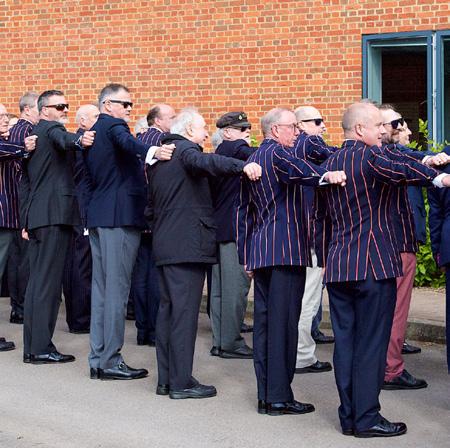
On Saturday 20 April 2024 over 100 OPs gathered for a weekend of celebration, catching up with friends and sharing memories.
The programme of events began on Saturday evening with a welcome drinks reception followed by dinner in the Mess Hall. This was the perfect opportunity for the Society to celebrate and recognise the Head, Thomas Garnier, and his wife Alexandra and their nineteen years of dedicated service to the College. After a short welcome from Rory CopingerSymes CBE (79-83) grace was said by Merrick Rayner (Vice President) before everyone took their seats for a delicious three-course dinner accompanied by an excellent selection of wines and port provided by OP Tom Bendall (94-97) of Wallingford Wines.
Phillip Plato, Chairman of the OP Society, proposed the Loyal Toast, and then addressed the room with a warm and heartfelt speech reflecting on his time as Chairman of the Society and the close working relationship and bonds that had been formed between the Head, the Society and its members. He highlighted the value that both he and the Society have placed on the support they have received from both Thomas and Alex during their tenure at the
College. Phillip also drew attention to the fact that the evening also marked the centenary of the first OP meeting that took place in 1924. The Head then responded to the Society, emphasising how the support and friendship that he and his family had received over the last 19 years had meant so much to him. On behalf of the OP Society, Thomas and Alex were presented with a Silver Armada Dish and the Head also received a Old Pangbournian belt.
After the formalities were over, guests continued to catch up over port and coffee. The weekend had begun in style and with the OP March Past taking place the next morning, a few wise souls began to head home.
Sunday dawned, bright and sunny, perfect conditions for a Division of over 50 OPs to take to the parade ground to salute the Head. The morning began with a short practice led by the OP Chairman and the College Staff Instructor, Paul Radford. It seems that the art of marching, once mastered, is never forgotten and it was only a matter
of minutes before the OPs moved off in good order to form up at the far end of the parade ground and await inspection. The Head and OP Rory Copinger-Symes (79-83) who was Guest of Honour, then began their inspection of the College Divisions. The OP Division was given close inspection by the Headmaster, which they passed with flying colours. With the inspection over, the moment had arrived for the OPs to show off their skills. Despite the passage of time, the standard of marching was extremely impressive and earned the OPs a round of congratulatory applause from the crowd.
After the parade and to round off what had been a very successful weekend, the College's Sixth Form Café hosted the John Flint Film & Theatre Reunion. OPs gathered to share their memories of the many ambitious productions that, under the direction of Dr Flint, brought together the very best of the College's acting and technical talent of the 1980s and 90s. During the afternoon, a number of clips were shown of the various productions, including King Lear, West Side Story and, from the College film unit, Pilot Error and Word of Honour. The event concluded with a screening of The Painters, a fantastic film unit production, mainly shot on location.




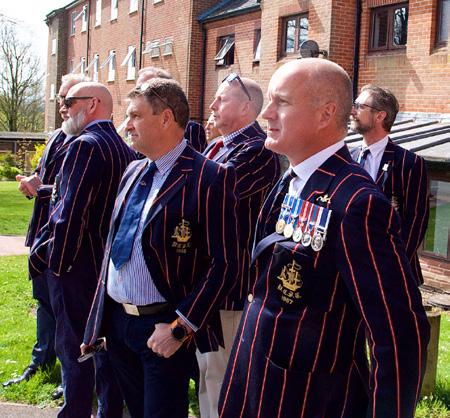
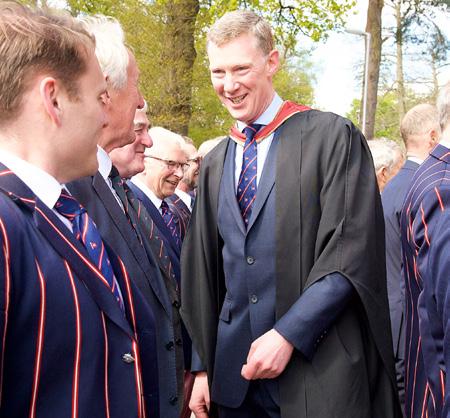





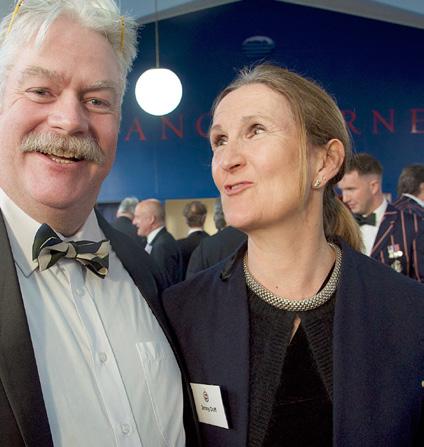














by Robin Knight (56-61)
“That remarkable wartime generation” which participated in D-Day included a full complement of Old Pangbournians. Given The Nautical College’s maritime roots, a majority were serving at sea in the Royal or Merchant Navies. What each of them did we will never know for sure. At the time, and for years after, recollections of June 6, 1944 remained largely untold or restricted as the march of peace resumed, often only surfacing decades later in obscure histories or niche war books about particular ships or individuals.
Now, 80 years after the event, a partial record can be constructed. At least 40 OPs have been identified from College records or external publications or museum archives as having participated in the invasion of France. At least that number again were involved in the subsequent Battle of Normandy. This contribution went across the board. One OP claimed to have fired the first

shell on D-Day. Several were killed in action, several more wounded on the invasion beaches. A young OP who had just left the NCP aged 17 was a crew member in one of the invading RN vessels. Another had the key role of ensuring continuity of supplies from Southampton. A third was a pilot in the RAF Squadron which spent months flying over the heavily-defended Calais region as part of a deception ploy.
Given the vast scale of D-Day – more than 4,600 Allied troops were killed, some 156,000 seaborne and airborne troops from Britain, Canada and the United States took part, some 7,000 vessels and 11,600 aircraft were involved – no account of what happened will ever be complete. Yet it is often through the stories of individuals and their actions that history comes alive to following generations.
One OP who epitomises this, and the sacrifices involved, is Edward Gerard Charlton (26-31) who was a Major and second-in-command of 9 Parachute Battalion, part of the 6th Airborne Division. This unit was dropped into Normandy on the night of June 5/6, before the D-Day landings began, to neutralise the Merville gun battery which, from a high vantage point, commanded miles of the Sword and Juno beaches where British and Canadian troops were to land. Unfortunately, the parachute descent in poor visibility was dispersed. But Charlton – who had barely learned to parachute – made it successfully.
Charlton's immediate task was to hold and defend a rally point. Yet instead of 600 men with heavy weapons or equipment arriving, only 150 with neither did so. Still, the attack on the battery proceeded. Half the men of 9 Para were killed before the lethal guns were silenced. The decimated battalion then pushed on. Charlton was sent to reconnoitre the nearby Château St Come and hold it until relieved by commandos. The château was taken but the Germans regrouped and infiltrated through woods by the building. Charlton gathered ten men and set out to try to rid the woods of the enemy. He was killed with two others in German machine gun crossfire. It was June 9 and he was 31. Eventually
Eddie Charlton was laid to rest in the CWGC Ranville war cemetery.
Bridging the dangerous gap between beaches and sea, landing craft played a vital role in the invasion. Thousands were involved. Most crews were very young, “aged 18-20 and ‘HOs’ (hostilities only),” according to one veteran who added, “We certainly found the hostilities we had joined for.” At least half a dozen young OPs fit into this category including the 19 yearold Rex Willis (38-42), later to captain Wales and the British Lions rugby teams, who commanded an LCT (Landing Craft Tank) conveying five Sherman tanks to the beaches. H.A. Hall (38-42) was another. Two older OPs carried out comparable operations. George Grandage (18-20), an RNR officer, had taken part in landings in North Africa, Sicily, Salerno and Anzio before D-Day, after which he was awarded a DSC for his role. Nigel Kingscote (19-21), another RNR officer with a Merchant Navy background, had a similar record. On D-Day he landed American troops at Omaha beach and received an OBE.
Most of these craft went on to support landings throughout the summer of 1944. Some were armoured, some not. 48 Royal Marine Commando, the second unit to reach Juno beach, was conveyed ashore by an unarmoured craft and suffered severe losses from the heavy swell, a vicious tidal stream and strong German resistance that had been almost untouched by the preliminary naval and air bombardment. Among those to pay the price was Major Derick De Stacpoole (32-37). Wounded in the landings, he was back in action two months later. At the end of October, he was killed during the hotly-contested Allied landing at Walcheren Island during the battle of the Scheldt. His commanding officer

described De Stacpoole as “a gallant, handsome Irish gentleman and a most admirable soldier.” He is buried at the CWGC cemetery at Bergen in the Netherlands.
OP captains of the many Royal Navy ships – destroyers, frigates, corvettes, minesweepers and light cruisers – which took part in the invasion included Jack Bitmead (33-36) in HMS Meynell, J.S. Brownrigg (29-32) in HMS Retalick, John Burfield (31-34) in HMS Faulknor, George Crowley (30-33) in HMS Walpole, Tom Fanshawe (32-35) in HMS Clover, George Forman (24-27) in HMS Garth, Tom Fowke (20-22) in HMS Wave, Ben Hamilton (26-28) in HMS Stockham, Roger Hill (23-27) in HMS Jervis, AN Rowell (22-25) in HMS Walker and James Wilford (19-21) in HMS Volunteer. Their roles varied hugely from escorting or carrying troops to the beaches, covering assault vessels, bombarding targets and protecting the flanks. Burfield had the added duty of
turning the destroyer Faulknor into a glorified ferry, conveying General Montgomery to France on the day after the invasion and taking other leading figures later to the beaches for day trips.
Two OPs may have been in Allied ships that fired the first shells of the pre-invasion naval bombardment. RN English (41-43) was a 19 year-old RNR Sub Lt. in the light cruiser HMS Ajax which claimed to be the first British ship to open fire off Gold beach on D-Day, destroying a 6-gun battery at Longuessur-Mer. Ajax went on to support Anglo-Canadian forces off Sword beach until June 22. Peter Manisty (29-31) was Mentioned in Despatches for his role in the light cruiser HMS Orion and actually thought he had fired the first shell from the invasion force on D-Day. Other OPs, such as David Cobb (35-37) and Tim Langridge (32-35), were serving in MTBs (Motor Torpedo Boats), repulsing efforts by German destroyers and E-boats to attack Allied ships on the
flanks and near the beaches. Another OP, Sam Hosegood (37-41), had the hairraising experience of being deployed in a ship which sailed from Tilbury at midnight loaded with ammunition for the Normandy beaches, was grounded on the way, was refloated and then had to discharge its cargo directly on to the sand at its destination. The youngest OP thought to have taken part was 17 year-old Roger Morris (42-44) who had left the Nautical College unannounced in early 1944, joined the RN as a rating and was serving in one of the ships in the invasion force.
In the air, several OPs are known to have been involved. Charles Newman (31-36) was an RAF Squadron Leader in 613 Squadron, charged with patrolling the Cherbourg Peninsula and “creating as much nuisance as possible to the Germans by bombing and strafing any movement seen or railways and roads,” as he wrote later in The Log, “The weather was vile.” John Young (35-39) in the Fleet Air Arm carried out a series of lowlevel sorties into Normandy. Patrick Foss (27-30) led Transport Command’s 38 Group which carried airborne troops to France in Dakota C47s. The month after D-Day Dennis Mitchell (33-36) in 226 Squadron was awarded the first of his two DFCs (along with his Navigator), for his role in covering the landings. The citation stated: “These officers were detailed to attack a target in Normandy recently. When approaching the target, their aircraft was heavily attacked by anti-aircraft fire but despite this a successful attack was made…mainly due to the fine leadership of Wing Commander Mitchell.”
George Chatterton (25-29), the Commanding Officer and inspiration of the 1st Battalion Glider Pilot Regiment (GPR) and CR Carylon (18-20)
both played key roles from England. Carylon was Principal Harbourmaster at Southampton. In this position he was responsible for continuity of supplies of every kind to the troops at the front, both on D-Day and throughout the seven-week Normandy campaign that followed. The redoubtable Chatterton, to his intense frustration, was made to remain in London to coordinate airfields and the activities of his men. Having made a costly battlefield debut during the faulty invasion of Sicily the year before, on this occasion the GPR took part in a well-planned and executed operation that went off like clockwork. Battalions, weapons and an armoured squadron with tanks were conveyed safely and accurately by the gliders to landing areas six miles behind the enemy frontline in the dark hours immediately before the amphibious invasion began on June 6.
Perhaps most poignantly, Charles Martin (30-34), a Major and Secondin-Command of the 1st Battalion Hampshire Regiment, was killed while landing on Gold beach right at the start of the invasion. Much is known about Martin thanks to the historian Christopher Jary. Martin had already endured the three-year siege of Malta and won a DSO for great gallantry during the Allied invasion of Sicily in 1943. The citation with that medal attests to Martin’s coolness under pressure, skill as a leader and “utter disregard for his personal safety.” Now his regiment – alongside the 1st Dorsetshire Regiment into which Martin had been commissioned in 1936 and served in until September 1943 – became the first British infantry to go ashore on Gold beach. It was both regiments’ third assault landing in just eleven months. Unsupported by tanks, the Hampshires “walked into minefields and a whirlwind
of shell, mortar and small arms fire,” in Jary’s words. They suffered heavily. The commanding officer was wounded early and ‘A’ Company ceased to exist. Martin was called forward to take over. “As he set off across the beach, he was killed by a sniper.” Martin’s final moments were seen by old colleagues in the Dorsetshires fighting nearby. “The death of this most gallant and capable officer was a very serious loss,” states Three Assault Landings, a regimental history. By the end of D-Day, Le Hemel and Arromanches had been captured but at high cost to the 1st Hampshires of 182 casualties (about one-quarter of its strength) including 64 killed in action. Martin is buried in the CWGC joint British-Polish-German cemetery at Ryes near Arromanches. A few days before he
embarked for France from the south of England he had written: “It’s incredibly lovely here today…it is very hard to realise that the world is in just about as bloody a mess as it can possibly be.”
Numerous other OPs, known and unknown, took part in D-Day. Judging their overall wartime contribution when writing in 1945, Sir Philip Devitt, the most influential person in the development of the Nautical College, penned a powerful message of belief and hope. As he put it: “They have bequeathed by their devotion to duty, a priceless heritage of example. It will, and I believe it has already, become an inspiration to those following now at the College – and also to those who join in the future.”


From the 13 to the 16 of June 2024, I embarked upon a deeply meaningful motorcycle tour through Normandy. This had been a long held personal ambition and the 80th anniversary motivated me to join an organised tour. Thanks to the exceptional knowledge and hasty research undertaken by Eugenie Brooks, who is an independent battlefield guide, this trip also took on greater personal significance for me and I felt I should recall this journey for the OP community as it became a chance to honour all those OPs who were involved in the D-Day landings in 1944.
by Phillip J. Plato (73-77)
This journey marked the 80th anniversary of D-Day and the commencement of Operation Overlord, a pivotal event in world history and the largest ever amphibian invasion. It also enabled me to pay tribute to two specific Old Pangbournians (OPs), Major Anthony Charles Wellesley Martin DSO and Major Lionel George Charlton, who gave their lives in the service of our country. As Chairman of the OP Society, I was proud to be able to lay tributes at both their graves and to visit the British Memorial to see their names displayed there.
Throughout the trip, the weather was unkind, with many cool, wet and windy sessions punctuated by brief sunny, humid periods which made riding arduous but which, as our guide commented,was rather similar to the weather conditions that the allied troops endured 80 years ago.
Day 1: Thursday 13 June –D-Day plus 80 years, 7 DaysArrival and initial stops
After an early morning ferry crossing from Poole to Cherbourg, our group rode in convoy, stopping first at the US 82nd Airborne Memorial beside the Merderet river and La Fiere Bridge. This modest bridge had huge tactical significance and can be likened to the strategic equivalent of Pegasus Bridge for the American Forces trying to break out of Utah Beach and advance into Normandy across territory the Nazis had flooded extensively. The fighting that took place at La Fiere Bridge on D-Day is often described as the fiercest battle of WW2 with possibly the highest fatality rate per square metre of any battleground in stark contrast to its peaceful rural setting today.
As our tour was taking place during the week following the 80th anniversary events, the US Memorial (and most other memorials we visited throughout this trip) were heavily adorned with floral tributes and wreaths. Several memorial plaques were also displayed with recently affixed photographs of servicemen placed there in recent days by relatives making their own pilgrimage. It was the first of many poignant moments on this trip.
With threatening skies, our group rode on, stopping briefly at Dead Man’s Corner outside of Carentan, where the film director Steven Spielberg has funded a museum that incorporates a
simulator ride in a Dakota aircraft taking parachutists into the Normandy drop zones. I was uncomfortable about such an “attraction” but having experienced it, it neither trivialises nor sensationalises, but genuinely gives visitors a flavour of how terrifying such a trip must have been. I should have expected nothing less of Mr Spielberg!
By the time we left Dead Man’s Corner, it was pouring with rain. We rode on before arriving at our hotel in the quaint town of Bayeux, united by a shared purpose and a deep respect for the history we had witnessed. Bayeux, with its rich historical tapestry, and central location in Normandy, served as the perfect base for our daily ride outs.
Although there were 11 individuals on 9 motorcycles from various parts of the UK, none of whom I had ever met before, I was astonished to learn that one couple had personal connections with two living OPs (Robin Patterson & Lawrence Howard) and that two others on the tour were also broadly familiar with Pangbourne College too. Our guide, Eugenie, picked up on this and, unbeknown to me on that first night, went off to research several OPs who were involved in the Battle of Normandy.
The next morning, we recommenced the tour, engines roaring with a sense of duty, and for my part totally unaware of the results of Eugenie’s efforts.
Day 2: Friday 14 June - D-Day plus 80 years, 8 Days – Pegasus Bridge, Gold, Juno & Sword Beach and Major (Acting Lt Colonel) Edward Charlton (26-31) OP
The first significant stop of our journey was Pegasus Bridge to the south of Sword Beach and of vital significance since it would enable British troops to break out into Normandy. The bridge has been replaced and the original bridge is now located in the grounds of a nearby museum. Our motorcycle group parked on the south side of the canal bridge to learn about the history of this place.
80 years ago at 00:16 hours on 6th June, parachutists and gliders from the Airborne Division, consisting of D Company of the Oxfordshire & Buckinghamshire Light Infantry, began to land east of the River Orne and the Caen Canal.
The small force of 181 men was joined by a detachment of Royal Engineers who landed at Ranville-Benouville in


six 28-men Horsa gliders. With perfect navigation and piloting skill, the gliders landed on time and on target within a few yards of each other and within a few feet of the canal bridge itself. Pegasus Bridge was captured after a fierce ten minute firefight, the action was all over by 00:26, a full six hours before the beach landings.
The first relief in force was from 6 Commando, led by the commander of the 1st Special Service Brigade, Lord Lovat, who arrived to the sound of the Scottish bagpipes, played by the 21 yearold so-called ‘Mad Piper’, Private Bill Millin.
In this early action of D-Day, the first house on French soil was liberated. This house still stands directly beside Pegasus Bridge and is now Café Gondrée where our group had parked for morning coffee, served by Madame Gondrée herself, who at the time of D-Day was just 4 years old and living in the house
with her family. Her café is adorned with memorabilia. She is a remarkable lady, immaculately turned out and demonstrably thankful to the British forces for liberating her home and town.
We moved on for the first of our interactions with the exploits of an OP. We left Pegasus Bridge and rode further west and inland to the powerful Merville Battery that formed part of Hitler’s massive Atlantic Wall of sea defences. In 1944 this Merville Battery provided a phenomenal artillery position overlooking Sword Beach and as such it was of vital importance that this facility was destroyed early in the invasion. One OP gave his life in heroic circumstances undertaking this quest.
Major (Acting Lt. Colonel) Edward Charlton (26-31), was the son of Admiral Sir Edward Charlton K.C.B, K.C.M.G and of Lady Charlton of Fareham Hampshire. Edward Charlton was originally with the King's Own
Yorkshire Light Infantry but had moved to 9 Parachute Battalion, part of the 6th Airborne Division, and had dropped into Normandy on the night before D-Day as part of a feint to outflank and capture the Merville battery covering Sword beach. The enemy strength at the battery had been underestimated and out of 750 British troops that were planned to make that attack, only 150 were actually dropped in the vicinity of the battery but with most of their ammunition and weapons also misplaced over a wide area of Normandy in the confusion of war.
Major Charlton had only recently received a battlefield promotion and headed the diversionary attack in a fierce exchange during which he was fatally wounded. Our guide, Eugenie, was able to show me within a few hundred yards where Major Charlton fell whilst leading this feint whilst the remaining forces managed to take the rear of the battery by crossing a heavily mined area
despite little mine detection equipment. While the battery was captured by the British it was later recaptured by the Germans, but by then the heavy guns within the battery had been rendered unusable by Major Charlton’s colleagues, thereby saving many hundreds of troops landing on Sword Beach from further heavy bombardment. Major Charlton was among many Allied casualties in the fierce fighting that took place that day.
Edward Charlton died from his wounds on D-Day plus 3 on the 9th June 1944, aged 31. He is buried in Ranville War Cemetery which was the first cemetery created in haste by the British initially following D-Day upon a farmer's field beside the adjoining Ranville churchyard. Our motorcycle group moved on to visit this cemetery which is now a beautiful and peaceful place, lovingly cared for by the War Graves Commission and the French alike. I was deeply moved to find Major Charlton's final resting place and I was able to lay a Remembrance cross wrapped in a silk poppy at his grave on behalf of the OP Society and all Old Pangbournians.
After an extended stop for lunch due to torrential rain, and as conditions improved, our group moved on towards Juno beach. After a brief stop to walk down onto the beach, where mainly Canadian but some British Troops landed, we then rode on to the British Normandy Memorial near Crépon.
This astonishing memorial site overlooks Gold Beach and was the main scene of British commemorations that had taken place the previous week, with wreaths laid by HM King Charles III, President Macron and the Prime Minister still prominently displayed. The names of all British personnel who died in Normandy between 6 June and the end of August 1944 are listed in date order
of their death on the columns within the Memorial. I was able to find the name of Major Charlton sadly very close to the start of the D-Day memorial listing.
The meadow between the British Normandy Memorial and Gold Beach was crowded with 1,475 black silhouettes representing the number of servicemen (including two female nurses) who died serving under British command on D-Day itself. This poignant display known as “Standing With Giants” is a temporary tribute which I understand will go on tour around the UK after August 2024.
We all returned to Bayeaux in a reflective mood.
Day 3 - Saturday 15 JuneD-Day plus 80 years, 9 Days – Mulberry Harbour, Reyes Cemetery & Major (Acting) Charles Martin DSO (30-34) & the US Memorials
The day again began with drizzly, blustery conditions as we travelled back towards Gold Beach and the town to the west of the beachhead known as Arromanches, the site of the artificial harbour created by the allied forces within days of the initial landings. Many of the “temporary” harbour structures are still visible in the sea to this day. In a period of 10 months immediately after D-Day, this miracle of ingenuity enabled over 2.5 million men, 500,000 vehicles, and 4 million tons of supplies to be landed to support the Allied invasion.
After exploring Arromanches, our group had agreed we would all perform a small group Act of Remembrance and on guidance from Eugenie, we rode towards the remote rural setting of the British Cemetery at Ryes, a few kilometres south of the town.


Unbeknown to me, Eugenie had located the grave of another OP whose final resting place was at Ryes. At this beautiful small remote cemetery outside the tiny village of the same name, we paid our respects to the courage of Major A.C.W. Martin DSO (30-34).
Major Martin was a member of the Dorsetshire Regiment. On D-Day his Regiment were the first British infantry to get ashore and were making their third assault landing in 11 months. On June 6th, "unsupported by tanks, they walked into minefields and a whirlwind of shell, mortar and small arms fire" in the words of historian Christopher Jary. A few days before he embarked for France, Martin had written: "it's incredibly lovely here today. It is very hard to realise that the world is in just about as bloody a mess as it can possibly be." Shortly after landing on Gold Beach, “A” Company had ceased to exist and the Regiment’s CO was severely wounded. Martin was called forward to take command. As he set off across the beach on D-Day, he was killed by a sniper on 6 June 1944. He was 27 years old.
The sun came out as our group gathered around Martin's grave and I laid a wreath for another OP who exemplified the values of courage and leadership instilled at Pangbourne, and who played a crucial role in the success of the operations in Normandy. Visiting his grave was a poignant reminder of the personal sacrifices made by so many. Everyone in our small motorcycle group was moved by his story with several wanting to know more about our College. The weight of history felt tangible as we stood amidst those who had given their all.
We then rode on to the Longues Battery overlooking the cliff tops near Longues-

sur-Mer, another huge gun emplacement that featured in the film “The Longest Day” and which represented a major threat to the two D-Day sectors of Omaha Beach and Gold Beach.
In a downpour of biblical proportions our group rode into St Laurent-surMer and Omaha Beach. Parking our motorcycles in something more resembling a swimming pool than a car park, our bedraggled group sought refuge in a beachside restaurant until the rain subsided.
The weather cleared and we later ventured onto Omaha Beach to hear Eugenie tell us about the assault by the hitherto untested American 29th Infantry Division, along with nine companies of U.S. Army Rangers redirected from Pointe du Hoc, who assaulted the western half of the beach with the battlehardened 1st Infantry Division taking the eastern half. The scale and expanse of the beach at Omaha made it all too clear how this area was a particularly treacherous point of landing and why so many US troops perished trying to get
ashore through the murderous German crossfire. The contrast between the serene beach today and its violent past was stark.
As we stood on the sand in our damp motorcycle clothing, we suddenly heard a chorus of voices from behind us singing “The Star-Spangled Banner” We climbed up the beach steps back to the promenade to see several hundred Americans who had by now gathered around the Memorial facing the beach and who had spontaneously broken into their national anthem. Many wore veterans' caps from Korea or Vietnam, others were clearly from younger generations remembering family or friends. One couple appeared to be very old and possibly D-Day veterans. Most were in tears as they sang. Omaha Beach is clearly hallowed ground for Americans and it was hard not to be moved.
We concluded the day by visiting the US Normandy Cemetery near Collevillesur-Mer, which is magnificent in both its scale and appearance, before finally riding on to visit Pointe du Hoc where
US Rangers scaled 90 ft cliffs to capture this heavily fortified position, again with guns that could shell both Omaha and Utah Beaches.
Day 4: Sunday 16 JuneD-Day plus 80 years, 10 Days – Utah Beach, St Mère Église and the journey home
Our final day required us to load our bikes up with all our baggage and with the ferry from Cherbourg not sailing until late afternoon, Eugenie offered to show us a few final stops on our ride back to the port.
It was raining heavily as we pulled into the German cemetery near La Cambe a few kilometres SW of Omaha Beach, a sombre and minimalistic mass grave for several thousands of German troops.
Following this stop, we rode onwards turning off the main roads and riding through narrow country lanes SW of Utah Beach, stopping briefly at the US Memorial to “Easy Co” at Brécourt Manor. Here “Easy Co” of the 2nd Battalion, 506th Parachute Infantry Regiment of the 101st Airborne Division, conducted the famous Brecourt Manor Assault depicted in the HBO Mini-series “Band of Brothers” where 23 men of E Company led by Major Richard Winters disabled 60 Germans manning a battery of four heavy German guns on 6 June 1944. These guns threatened Allied forces coming along Causeway 2 off Utah Beach. Despite being heavily outnumbered, the assault resulted in the loss of just 4 US troops compared to 20 Germans killed and 12 captured, including the seizure of a vital map identifying other German fortifications. The Brécourt Manor Assault is still taught at West Point Military Academy as a textbook example of how to undertake such a mission.
We continued on to the famous village of St Mère-Église where in the early hours of D-Day, mixed units of the U.S. 82nd Airborne and U.S. 101st Airborne Divisions occupied the town in Mission Boston, making it one of the first towns liberated in the invasion. A well-known incident depicted in the film, “The Longest Day'', involved paratrooper John Steele of the 505th Parachute Infantry Regiment (PIR), whose parachute got caught on the tower of the town church. He hung there for two hours, pretending to be dead until the Germans took him prisoner. A mannequin dressed as a paratrooper hangs from the church tower today, recreating that incident. There is an excellent museum to the 101st Airborne Division in the town and after looking around and having lunch and with warm sunshine finally coming out, we all climbed aboard our motorcycles for our final ride to Cherbourg and the ferry home.
This tour had been more than a commemorative event; it was a journey of learning, reflection, and profound respect for the past. Personally, I found it one of the most fulfilling experiences of my life to find the final resting place of two OPs who fell in the initial days of Operation Overlord and it was a profound honour to place tributes on their graves in my capacity as Chairman of the OP Society.
This motorcycle tour through Normandy was not just a tribute to the OPs who served in World War II but a reaffirmation of our commitment to remembering and honouring those who came before us. One profound image which I think summarised my thoughts as I rode through a remote French village back to Cherbourg, was of a farmhouse
displaying the flags of all the allies but with a huge banner hanging from the upper windows simply saying “Merci”. Indeed, we all owe our thanks to Major Martin, Major Charlton and the many thousands of service men & women involved in this campaign 80 years ago for the freedoms we enjoy today.
The Old Pangbournian Society remains dedicated to preserving the memories of all our fallen heroes and particularly the loss of OPs and ensuring that their sacrifices are never forgotten.

The College Year 8 pupils attended Williams F1 in Grove, Oxfordshire, as part of a STEM day run by the Design and Technology department.
The focus of the day was engineering, and pupils had the opportunity to undertake a robotics challenge using Lego Mindstorms, take part in races against their classmates using a driving simulator, and tour the Williams F1 museum, where they were able to see all of the F1 cars that Williams have developed over the years.
Throughout the day pupils learnt about how the subjects that they study at College relate directly to careers within the automotive industry.
What a fantastic day for the pupils, who left inspired by what they had experienced. We thank Williams F1 for such a wonderful opportunity.


The Drama department continues to return outstanding results with another successful round of Trinity Drama exams. Trinity Drama pupils undertook their solo and paired Acting exams with a mix of classical pieces and contemporary monologues. Some of the assessed work was devised or mimed. A huge amount of preparation and rehearsal goes into these dramatic programs and the performance and presentation skills learnt are invaluable.
The external examiner and professional theatre director, stated that he thought we had ‘lovely, confident and very eloquent pupils’ and he was particularly impressed with the level of conversational skills at Pangbourne. Among our 18 students who undertook the exam, 100% achieved at least a very high Merit with 78/100 or above and 14 pupils achieved outstanding Distinctions. A special mention to Ralf Tompkins and William Peters, who both achieved
95/100 for their Grade 3 Acting in Pairs exam, and Sophie Jacobs, who achieved 95/100 and Lois Hughes, who achieved 94/100 for their Grade 3 Acting Solo exams.
Very well done to you all for your consistent hard work and efforts leading up to the exam. We are so proud of you!
Pangbourne College is delighted to welcome Max Clementson, openside flanker for Chinnor Rugby Club, as its Director of Rugby and Louise Tremlett as Director of Hockey from September 2024.
Max has had a formidable rugby career to date, having played for England 7s at seven World Series tournaments in 2022, competed for Team England at the Commonwealth Games 2022 and being part of the squad for England 7s at the 2022 Sevens Rugby World Cup. He is currently signed at Chinnor for the upcoming 2024-2025 season.
Max explains, “I’m delighted to be taking on the role of Director of Rugby at
Pangbourne College and building on the foundations already established. I want to bring Pangbourne College back to being a competitive rugby school at the top of its game.”
Furthering its commitment to performance sports, Pangbourne College has also appointed Louise Tremlett as Director of Hockey. She will combine this with her role as Assistant Director of Sport. One of the College’s aims is to continue to provide an outstanding girls’ hockey programme, and this is one of the remits of this role.
Before joining Pangbourne, Louise coached U14 girls and boys teams to National Finals and led U18 boys

and U16 girls teams to regional indoor championships. She is currently part of the England Hockey Coaching Development Team, delivering sessions to U14 and U16 players.
Louise explains, “I have been working with the College for almost a year and am thrilled to have been given this opportunity. Girls’ hockey at Pangbourne has gone from strength to strength and I want to continue on that trajectory.”
Mr Oliver Knight, Head says, “The appointment of these positions shows Pangbourne College’s ongoing commitment to two of its performance sports. We are passionate about raising the standards of these sports.”

1st team colours are awarded to pupils who have made a sustained and significant impact on the 1st team in their sport. They have been an excellent role model and shown an outstanding attitude across their time.
Cricket
• Ben Sexton
• Danny Tottman
• Jack Stebbings
• George Milbank
• Boyd Price Tennis
• Sophie Hale
• Mia Moore
• Faith Merry
• Emilie Jourdain
• Grace I'Anson
• Theo Stephenson
• Fergus Baxter
• James Pullen
• George McCormick
• George Pride
Rowing
• James Powell
• John Harper
• Will Rowton-Lee
• Kit Hayes-Newington
• Max Maleham
• Henry Manley
• Kitty Thomas
• Poppy Shepherd
• Rubi Maleham
• Eve Allen Riding
• Isla Apiafi
These pupils have made an outstanding contribution to school sport, normally over a two-year period for the 1st team, and they will have been great role models for the school, both on and off the sports field.
Cricket
• Ben Greenwood
• Toby King
• Archie Donald
• Dylan Teague
• Josh Bodimeade Tennis
• Alice Dutton
• Olly Rogers
Rowing
• Noah Lowe
• Ollie Edwards
• Charlotte Bishop
• Clover Merry Riding
• Thomasin Munro

As part of our commitment to developing and delivering a top-tier programme for our sports scholars and members of our performance sports teams, Pangbourne College is delighted to announce its new partnership with Ascend Performance.
The Ascend team comprises strength & conditioning coaches, physios and sports therapists with a background in professional sports. They will provide an elite level of service of athletic development to our pupil athletes and individuals of all levels. This will
form a part of the ‘Sports Performance Programme’ at the College, which is already recognised as one the leading programmes in the area.
Matt Dickens MSc ASCC, Performance & Rehab Director at Ascend Performance has worked with Olympic champions, international rugby players, world-class motorsport racers & alpine skiers. He is an accredited coach with the UK Strength and Conditioning Association, holds an MSc in Strength & Conditioning and brings a science-based approach to human performance.
Rob Nitman BSc ASCC, Programme & Coaching Director, is an accredited Strength & Conditioning Coach (UKSCA). He has held high-profile roles in professional Rugby Union and Higher Education since 2014.
Matt and Rob expressed their enthusiasm: “We are excited to work with the impressive sporting talent at Pangbourne College.
Sam Hewick, Pangbourne College’s Director of Sport, added, “It’s an exciting time for sport at Pangbourne College. Integrating the expertise of Ascend Performance elevates our programme and positions Pangbourne College at the forefront for the opportunity of sporting excellence. The College is home to over 100 teams across ten sports, with 85% of its students regularly participating in competitive team sports—15% above the independent school average. This new partnership with Ascend Performance underscores an ongoing commitment to excellence in performance sports and follows the recent appointment of a Director Rugby and a Director of Hockey.

On Friday 1 March, Pangbourne’s rowing team travelled to the Olympic Park in London to compete and showcase their talent at the prestigious National Junior Indoor Rowing Championships. Despite the challenges presented by a harsh winter that led to the cancellation of many races, our resilient athletes made their mark in the Copperbox Arena, a venue renowned for its role in the 2012 London Olympic Games.
Amidst a vibrant atmosphere filled with thousands of spectators, our Year 7, 8, 9 and 10 rowers demonstrated remarkable skill and determination in their first-ever race experience.
The highlight of the event was undoubtedly the outstanding performance of our rowers, with several notable achievements. Special mention must go to the Year 9 Girls' Team Relay
Gold Medal Winners (94 Entries) Skylar, Anna, Mille and Amy.
As the day concluded, it was evident that our rowers had not only excelled in their performances, but also embraced the spirit of camaraderie and competition, making it a memorable and rewarding experience for all involved. Congratulations to all of our talented athletes.

College Boat Club Girls under 19s conquer International Spring Regatta
During the Easter break, senior members of the College Boat Club travelled to Ghent in Belgium for their annual Easter training camp and Ghent International Spring Regatta. Surrounded by the picturesque scenery of historic canals, they immersed themselves in rigorous training sessions, collectively rowing over 150 km through the week. This intensive preparation not only honed their skills but also fostered camaraderie and resilience among the crews and was an invaluable preparation for the summer racing season.
Mr Richard Follett, Deputy Head of Co-Curriculum, who travelled to Belgium with the students, stated: “With crews from across Europe and a number of the strongest British schools and clubs competing, it was a very tough first regatta of the season for the crews, already fatigued from their training camp. However, they performed creditably, producing some very good results. Out of the 9 events entered, the crews achieved top 10 finishes in 7 of them, showing there is much potential for the summer ahead.”
Particularly noteworthy was the outstanding performance of the Girls' U19 Coxless Four comprising Clover, Charlotte, Eve, and Rubi. This quartet not only secured the Gold Medal in their category but also showcased their versatility by securing another Gold in the Senior Women's event.
Later in the same day, the same crew switched to the U19 Coxless Quad and, despite tired legs, produced an excellent row to win their heat in style and pick up the Silver Medal.
The Pangbourne Equestrian Team enjoyed a good level of success at the prestigious Royal Windsor Horse Show on Saturday 4 May 2024.
Our team of Thomasin (Team Captain, Upper Sixth, Illawarra), Amy (Lower Sixth, St George), and Isla (St George, Year 11) rode with much composure and discipline in a competition that is like no other. Competing against servicemen and servicewomen in a fiercely competitive international competition, our team took a respectable 10th place in the Bahrain Services Showjumping event.
The afternoon parade was a continuation of the teams hard work and determination. The horses responded calmly and beautifully to all three of our
riders - a great display of horsemanship in an environment which saw other horses misbehave with huge levels of tension and nervousness. In this event, our riders saluted HRH Prince Edward, Duke of Edinburgh.
With the huge disappointment of our National Schools’ Equestrian Association Showjumping team having their competition cancelled the day before they were due to compete, it was a great credit to have the support of fellow team members, further proof that the equestrian team ethos and spirit is strong and second to none. The NSEA team will compete in the Intermediate Showjumping Championships that have now moved to the National Championships at Addington in October.


We recently hosted our third successful Wellbeing Day, a vibrant event with the aim of nurturing the mental health and resilience of our pupils and students. Taking place on the final Thursday of the Lent Term, this day of introspection and community engagement left a lasting impact on all who participated.
The day commenced with insightful talks from exceptional professional speakers including:
"Self-help rules to keep you healthy" by Chris Singleton, founder of Transparency Theatre Company
"Online Safety - being an upstander" by Charlie Benson, Childnet
"Managing the stresses of life" & "Setting up for Exam Success" by Alicia Drummond, CEO of Teen Tips
"Gaming and Gambling - What’s the worst that can happen?" & "Gaming and Gambling - Friend or Foe?" by Patrick Foster, CEO GAM-Ed
Through their empowering discussions, we gained valuable insights into positive strategies for maintaining mental wellbeing, emphasising the importance of self-care and resilience.
One of the highlights of the day was a charity netball match organised by Alice, an Upper Sixth student, in support of
Nabugabo, Pangbourne's partnership school in Uganda. The match not only showcased the spirit of camaraderie within the Pangbourne community but also raised funds to support three pupils for a year at Nabugabo. Alice's dedication and fundraising prowess, alongside Poppy Shepherd's initiatives as Nabugabo CCs, exemplify the College's commitment to service and global citizenship.
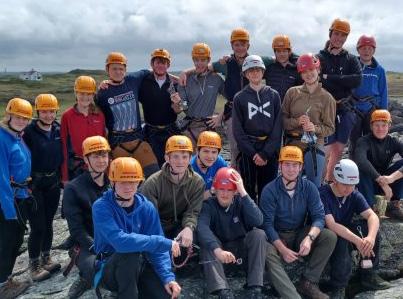
From the 8 to the 13 of July, cadets from the College and Denefield School embarked on an adventurous training expedition in North Wales. The Capel Curig Training Camp was the perfect setting for the many challenging activities designed to develop their teamwork and leadership skills.
The adventure began with an evening of paintballing in Snowdonia, a welcome activity after a long coach journey. The second day began with an exhilarating gorge walk up a stream and waterfall in the Conwy Valley. Despite wet weather, cadets eagerly rock climbed, jumped into plunge pools, swam and navigated slippery terrain, demonstrating great enthusiasm and effort.
On day three, cadets faced the challenge of abseiling from a cliff edge near an old lead mine in Trefriw. This thrilling day ended on the high of watching England's victory in the Euros.
Day four involved raft building, ropework, and orienteering around the picturesque lake of Llyn Geirionydd. Some staff even took a refreshing swim while supervising the cadets as they tested their rafts.
The fifth day was particularly memorable, featuring coasteering along the cliffs of Porth Dafarch on Holy Island, Anglesey, and a big abseil at Caffi’r Parc. Cadets shared their enthusiasm, with one saying, “I would never have done this unless I came on this trip.”
Due to rainfall, the final full day saw a change of plans, with cadets heading to Penrhos Bay in Anglesey for an action-packed day of rock climbing and abseiling. We extend our heartfelt thanks to North Wales Active for their exceptional leadership. And we are incredibly grateful to the Ulysses Trust for sponsoring the trip, making it accessible to more cadets. Additionally, we appreciate the dedication of all attending staff, especially SSI Paul Radford, whose hard work was crucial in planning this inspirational expedition.
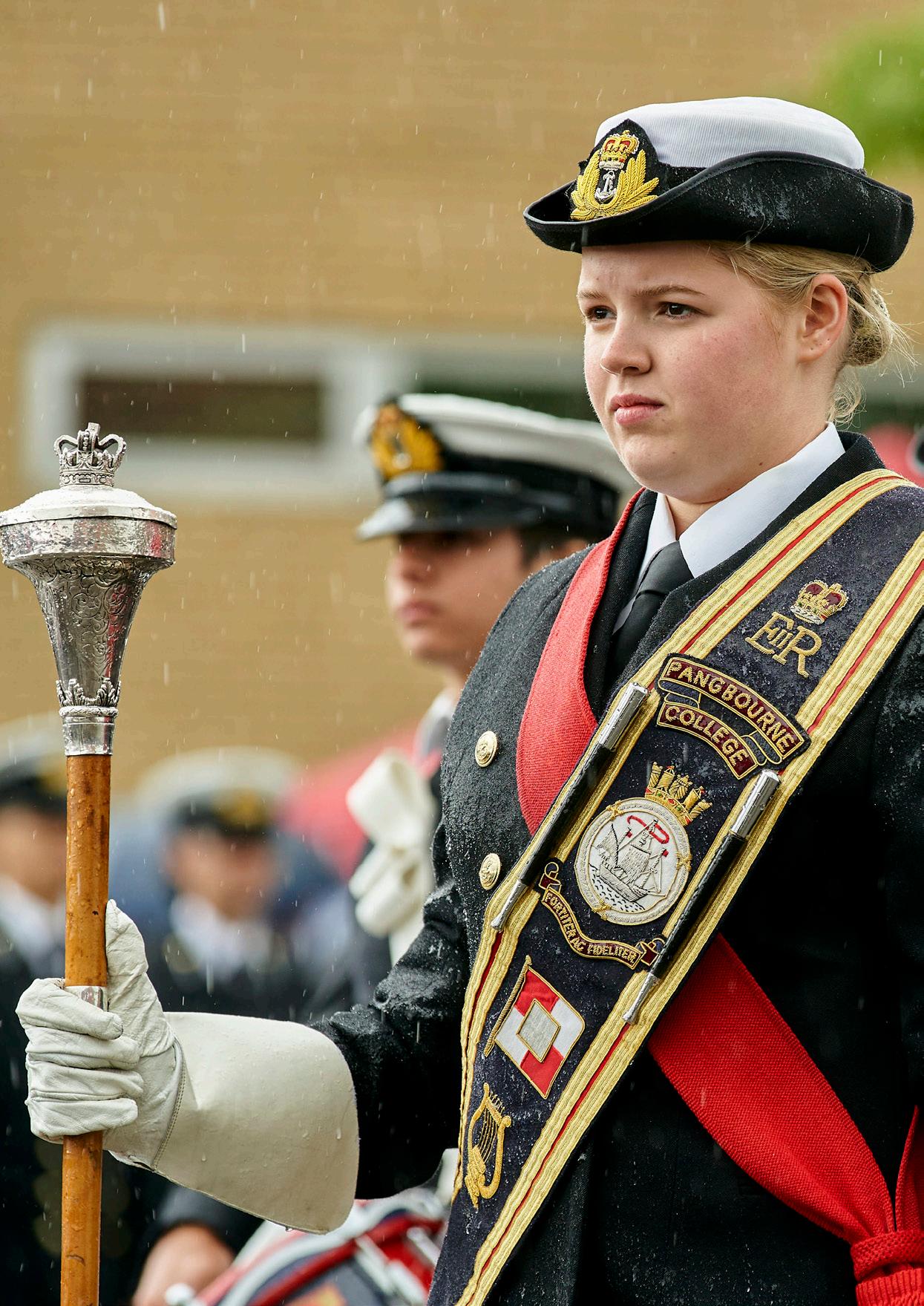

Founders' Day 2024 took place in what can best be described as monsoon conditions. However, this didn't dampen spirits and everyone was determined to give Alexandra and Thomas Garnier a true Pangbournian send off after nineteen years at the helm of the College and to bid farewell to the Upper Sixth, as well as a number of much loved staff members.
After hastily rearranging the schedule to make the most of the breaks in the weather, the day began with prize giving in the marquee. Mr Andrew Bond, ViceChair of Governors, began proceedings by introducing the Guest of Honour, Mr Mark Hutchinson, before paying tribute to Thomas and Alex for the outstanding contribution they have made to the College over nearly two decades. Mr Garnier then delivered his speech with the help of the two Chiefs of College, Jemimah Nusi and Will Rownton-Lee. During his speech he paid tribute to those staff who are leaving the College,

including Mrs Sam Greenwood and Mr James Bamforth. The prizes were then distributed and the King's Gold Medal awarded to Jemimah and Will. At the end of the formalities Andrew Bond invited Alex to join Thomas on the stage where they received a standing ovation. As the assembled guests thanked them, the emotion of the moment was palpable.
As the time came to leave the marquee, a well-timed pause in the rain offered the perfect opportunity to take to the
Parade Ground where the College put its best foot forward and delivered a perfect Pangbourne Parade. Finally, the Guard took up their positions for Beat Retreat just as the heavens opened.
Despite the deluge making the task even harder, the Guard performed fantastically and as the Upper Sixth gathered under the flagpole one last time, the rain stopped as sodden lids were tossed in the air.
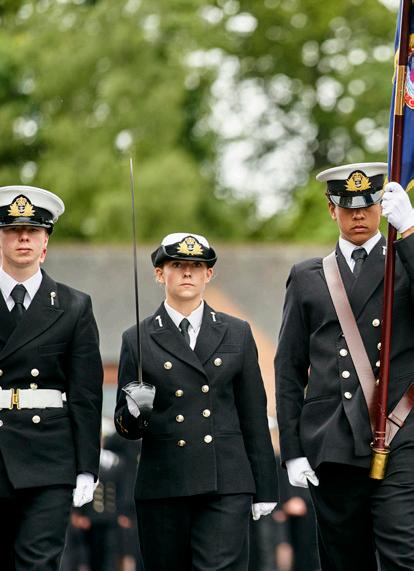

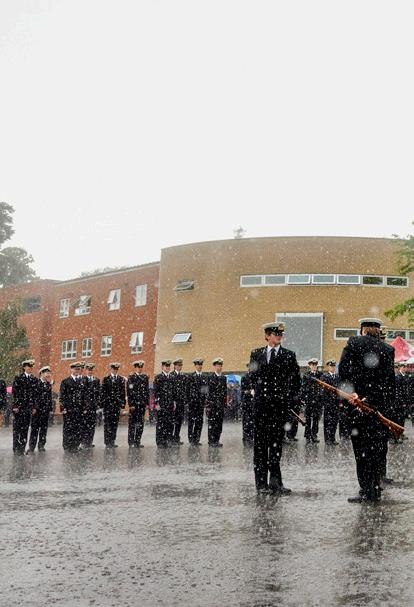


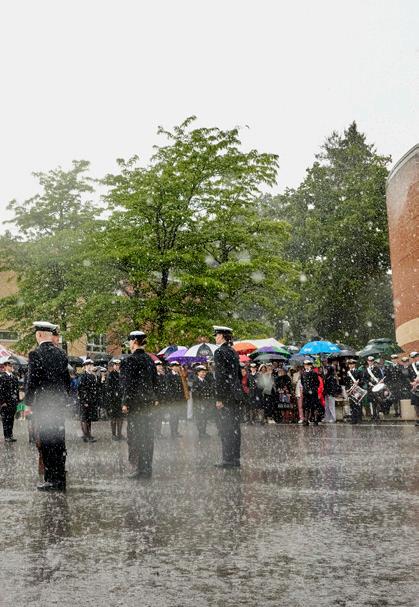





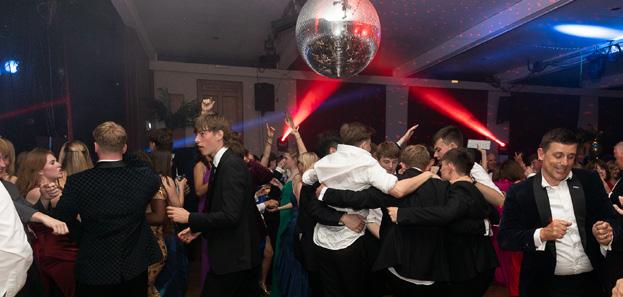














Expressive Arts Prizes:
Drama, The Prompt Book: Joe De Halpert
Marcus Graham Art Prize: Hattie Kingsland
Music Performance Prize: Immie Kingsland
Open Prizes:
Ambrose White Memorial Prize: Grace Jeffers
Paravicini Shield: Ben Greenwood
Chris Mullins Prize: Ralf Tompkins
Keith Evans Prize: William Peters
Nigel Hollebone Centenary Prize: Faith Merry
Austin Anderson Prize: Thomasin Munro
Thornely Language Cup: Eva Griffin
Jude Memorial Prize: Joe De Halpert
Old Pangbournian Prize: Ollie Edwards
His Majesty The King’s Gold Medal: Jemimah Nusi and Will Rowton-Lee
Head’s Prizes
Charlotte Bishop
Henry Byrom
Alice Dutton
Tobias King
Annabelle Usher
Head’s Tankards
Josh Bodimeade - Harbinger
Ben Waters - Hesperus
Clover Merry - Illawarra
Ben McGregor-Wood - Macquarie
Josh Bywater - Port Jackson
Ellen Williams - St. George
Performance Prizes
Year 7: Bello Abdulmumini and Samuel Duffy
Year 8: Tom Croucher and Ruby Dharwar
Year 9: Vita Patel and Maisie Stephenson
Year 10: Alexei Mihalciuc and Eva Skidmore
Year 11: Rory De Halpert and Theo Stephenson
Lower Sixth: Imogen Ambrose and Frederick Stokes
Upper Sixth: Elizabeth Denley, Joshua Jackson and Benjamin Pritchard
Year 7: Molly Devlin and Freddie Hayward
Year 8: Anna Acworth and Zachary Robins
Year 9: David Burnand and Stella Evans
Year 10: Molly Fergusson and Phoebe Shelley
Year 11: Erika Bevis and Jayden Mirchandani
Lower Sixth: Eve Allen and Nino Mamisashvili
Upper Sixth: Charles Bishop and Alice Dutton
Sports Cup
Girls - St George Boys - Hesperus
Head’s Cup Illawarra
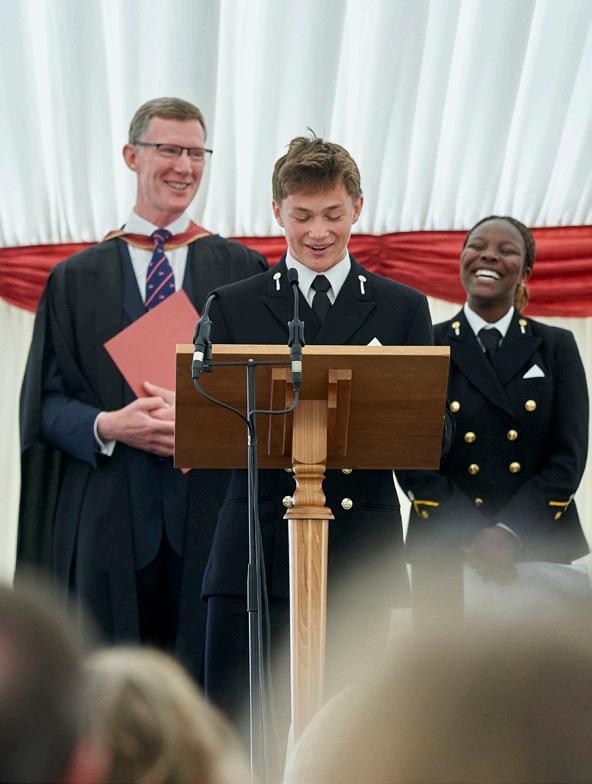

As part of the Lower Sixth Taking Responsibility Week in May, the pupils were given the opportunity to be interviewed by a number of Old Pangbourbians as well as current and past parents.
A workshop earlier in the week, delivered by Polly Ingestre (MRFG Consulting), provided the Lower Sixth with advice on how to craft a CV along with key interview tips, meaning that our pupils were well-equipped for their interviews. The feedback from all those involved on the day was positive and as always our pupils did themselves proud. For many of them it provided the opportunity to discuss their many achievements, whether on the sports field, in music or from other extracurricular activities. Along with this, a number of the Lower Sixth also attended the Careers Fair at Bradfield College, which started conversations about volunteering and sports opportunities abroad during a gap year as well looking at degree apprenticeships and university courses.
As pupils progress into the Upper Sixth, the College has invested in Unifrog, a platform used by over 3500 schools, which acts as a one-stop shop for the UCAS process, as well as providing links to information on apprenticeships and virtual work experiences, both for our pupils and their parents. The aim is, as part of our developing Careers and Future Pathways programme, that
the platform will be rolled out across the whole College over the next couple of years. As we look forward to a new academic year, it is an exciting time to see how we can develop our programme of providing our pupils with the support and skills to enable them to make the
by Indy Kaur, Head of Sixth Form
transition post-Pangbourne. We are looking at ways to develop our links further with our OPs, for example, in terms of their offering work experience opportunities, but also to potentially take part in future planned careers-related fairs and events.

Thank you to 61 members of the community, including Old Pangbournians, current and past parents, for providing valuable careers support this year.


The Pangbournian Portal was launched in 2021 as the platform to enable a richer and more diverse Pangbournian social and professional network, delivering a programme of events and offering careers support and mentoring opportunities across the community.
Pangbournians are proud to join the College for life and the Portal now boasts over 11,000 members from across the world who enjoy a regular stream of news and events. The dynamic online platform is enjoyed by Old Pangbournians, their parents and former staff, providing access to the latest College and alumni news, photo galleries and alumni events. The more Pangbournians that join the platform, the more valuable and dynamic it becomes.
Connect with the College, past and present
As well as providing access to College and alumni news, the portal also provides access to all published obituaries and the College Archive, with information collected since the College was established in 1917. This means Pangbournians can read old College
Logs to find information, be it about fellow pupils, sports teams and staff, past and present.
Make the most of your connections
Through the Pangbournian portal, Pangbournians volunteer as career experts, offering mentoring, providing work experience, interviewing and offering to review CVs; providing long term valuable support to those following in their career footsteps.
Get involved
Whether Pangbournians choose to connect online or face to face, the Portal provides a wealth of opportunities to connect, build networks, rekindle friendships or meet fellow Pangbournians in a new city, university or career path.
The Pangbournian Portal in numbers:
• Launched July 2021
• 11,397 contactable members
• 1,231 members with online profiles
• 39,000 news article views this year
• 20% of online users have joined a Club or Society within the community
• 1,900 unique visitors to the site, on average per month

This year has been another highly successful one for the Pangbourne Parents Association (PPA).
The year began in October with the PPA Ball. This year's theme was 007, bringing glamour and a touch of sophistication to Drake Hall. The evening began with a welcome cocktail before everyone sat down to a Bond-themed menu. During the event guests took part in a game of 'Heads & Tails' as well as bidding for some amazing lots in a charity auction and taking part in the raffle. The PPA would like to thank everyone who came along to support them, and helped to raise over £11,000 for the charities and projects that the PPA supports. Special thanks also go to all those who donated prizes and the dedicated team of parent volunteers who helped during the setup of the Ball.
The Michaelmas Term is alway a very busy one for the PPA and, hot on the heels of the Ball, came the Christmas Market in Drake Hall. Visitors were treated to over 50 high-quality stalls selling a range of unique gifts, including the fantastic range of PPA merchandise
such as Pangbournian Spirit Gin & Rum, Christmas cards and, a new edition this year, notebooks and cards featuring the College's stunning bluebell woods in all their glory. Other offerings included the opportunity to win a wheelbarrow of wine, take part in the tombola and guess the name of the bear. The PPA also ran its own Christmas café which was immensely popular during the day, selling a range of hot food as well as tea, coffee and cake.
In the Lent Term, a quiz night was held in the Mess Hall where the proceeds were split between the causes that the PPA support and the Nabugabo Community Learning Centre in Uganda, which the College has been in partnership with for over a decade. The PPA have also supported other College initiatives such as the Classic Car Show, where sales of Pangbournian Spirit were brisk, as well as attending the College Open Morning where they help welcome prospective parents to the College.
All of these events allow the PPA not only to bring the Pangbourne community together, but also to give back, not only to our own community but also, young people who have faced and are facing major challenges living in our local communities. This year, the PPA has distributed over £10,000 in grants to various departments across the College, including £1,600 to the music department for recording equipment, £4,500 to the English Department to purchase books for their Reading Canon, £5,400 to the Drama Department for new lighting and £2250 to the CCF to purchase nine paddleboards.
The PPA also offers support to their nominated charity ‘Bridge for Young People’ based in Newbury, Berkshire, which provides a home and support to young people (aged 16-25) who are leaving care or who are homeless. They currently have three houses in West Berkshire: Cornerstone, Rebecca House and Hope House. Residents have
typically experienced varying challenges during their childhood and the charity is able to provide them with a stable home, emotional support and practical help during this crucial time as they move into independence. This year the PPA donated £2,500 to help continue this vital work.
At the end of a very hectic but fun year, the Committee finally had to say a fond farewell to their Chair, Jayne Wells, and Committee member Lucy Shepherd. Lucy has been a member of the Committee for seven years and is one of its longest serving members. She has
worked tirelessly to support PPA events and for the past three years has run the Christmas Market café which contributes hugely to the fundraising totals; we wish Lucy and her family well.
Jayne has successfully steered the PPA for the past four years and under her leadership it has gone from strength to strength. The Committee will miss her support, sense of humour and her 100% commitment to them and all she sets out to achieve, and we wish her well for the future beyond Pangbourne. Mrs Pippa Aslet has kindly taken on the role of Chair.
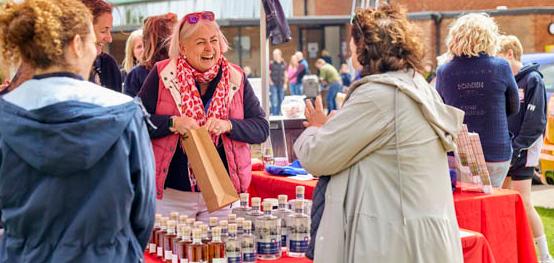


Over 50 parents volunteered with PPA events this year
£2,500 donated to support young people in the local community £11,000 given to the College in grants
Upcoming events: Sat 9 Nov Christmas Market 10am to 2.30pm

A year ago, an Old Port Jacksonian walked into the Division while I was on duty and began to reminisce on his days at Pangbourne, and more specifically his times in Port Jackson. After he left, I had mixed emotions from our encounter. He mentioned how the Division had not really changed and how apart from a few updates on the technology front, the building and the furniture remained the same.
However, one thing that did resonate was the ethos of the Division and how he had been a part of a family not only during his time, but also postPangbourne. This is something that is very much prevalent and promoted still to this day. Fast forward twelve months and Port Jackson is thriving after a very successful year. It is a division of 62 boys of which 32 board, with a vast range of cultures from Africa, Asia and across Europe. No matter the background of the individual, the idea of home and that ‘family’ feel continues to thrive. The substantial refurbishment across the division is now the only factor that has significantly changed, and for the better. Making sure that the Division is ‘home from home’ like every boarding house should, each cabin gives you a hug as you enter, with the warmth of the paint on the feature wall and the new furniture adding quality and comfort.
The old mahogany ceiling panels in the Gunroom have been replaced with a much lighter alternative, drawing more light into the social hub of Port Jackson, making evenings and musters a much more enjoyable gathering. The Galley is now unrecognisable with furniture and fittings that most households would be proud to call their own and is now the kitchen that hosts an eclectic mix of cuisines cooked by the boys. Then finally, the motion sensor showers and underfloor heating help towards bringing the Division in line with the 21st century.
In the calendar year 23/24 Port Jackson started with a win in Divisional Drama with our original take on E.T. This was followed quickly by 2nd place in the Divisional music competition, and 2nd (by one point) in Divisional Come Dine With Me. At the end of the year we were recognised with 2nd spot in the
by Steve Thompson, Housemaster
Sports Cup, top of the boys' divisions in the Headmaster’s Cup, and 1st in the Parade Cup. All while maintaining humility, friendships and above all, enjoyment. This success is underpinned by the leaving Upper Sixth who have pushed on to develop and nurture the divisional motto ‘Ubi Concordia, Ibi Victoria’, ‘where there is unity, there is victory’. As we continue to grow, in the current climate there is no room for complacency and resting on one’s laurels. Port Jackson looks to further develop and build on its success by improving the efficiency of the wolf packs (the inhouse competitive groups), and further recognise excellence and progress, whether in the classroom, on the stage or on the sports pitches.
I do hope one day that that same gentleman can come back and see the modern twist the refurbishment has had on what is a well-established and much-loved division.


by Frances Wright, Director of Operations
Commencing in 2023, the initial scope for the refurbishment of PJ started with the ablutions and quickly evolved into a larger project, as it had not been refurbished for a number of years.
• Stage 1: First all the cabins were redecorated, new lights put in and new furniture, to make them more homely. The day rooms were decorated and walls were removed to create larger spaces. The HoM Office had a new window added as well as being decorated.
• Stage 2: The Galley became the next focus and a new kitchen with additional seating was added so that
all the boys could sit in the kitchen for meetings with Steve Thomson and the team. The Matron’s room was next and a new laundry room was created with new machines and a dryer area.
• Stage 3: The final area to refurbish was the Gun Room, which was completed in Summer Term 2024.
With the exception of some of the decorating, all the work in the house was completed by the College’s in-house team of four. They refurbished 33 cabins, three day rooms, one bathroom, one shower room, two shower blocks, two toilet blocks, two offices,The Galley, the laundry room and The Gun Room.

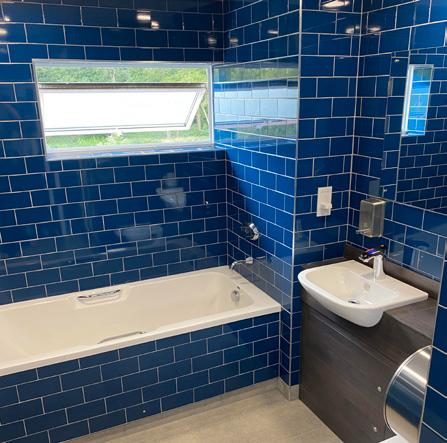

by Alexandra Garnier
Pangbourne College celebrated its 12th Anniversary Piano Festival on Saturday 2 March. Almost 100 young musicians (aged 7 to 18) from 38 schools in the South of England attended it. Among the musicians were five from the College: Eve Allen (Lower Sixth, St George), Isaac Henry (Year 10, Harbinger), James Jeffers (Lower Sixth, Hesperus), Jayden Mirchandani (Year 11, Hesperus), and Leo Robinson (Year 10, Macquarie).
In 2012, when the new Music School was built, the annual Festival was created by Mrs Alexandra Garnier. Its purpose was to provide as many young people as possible with an opportunity to perform on the school’s new worldclass Steinway grand pianos (these were replaced 10 years later with a further set of new Steinways).
For the majority, to play on such instruments is very special and for many,
a completely new experience. The quality of the sound of each instrument is amazing and the sheer size of them (compared with an upright) gives plenty of scope to enrich any performance.
What is perhaps unique to the Pangbourne College Piano Festival is the workshop element of each competitive class. After each performance, students receive immediate feedback from an adjudicator.

after year is because the atmosphere is a positive and nurturing one. This is largely due to the character and expertise of the adjudicators, as well as the warm welcome given by the Pangbourne College Music Department.
Mrs Pamela Chilvers GRSM LRAM DipMTh has adjudicated at the Pangbourne College Piano Festival since 2013 and Mrs Samantha Ward BMus MMus MMP adjudicated in 2022 and returned again this year.
Mrs Chilvers lives locally in Caversham and has examined for the Associated Board of the Royal School of Music (ABRSM) for almost 20 years. She now teaches advanced pianists, many of whom are Diploma holders and teachers themselves. She composes and, this year, one of the advanced class performers played her popular piece, Kites
Mrs Samantha Ward lives in London. She is the founder of Piano Week, an
annual international festival and summer school created in 2013 for pianists of all ages and abilities. Having performed very successfully all over the world, she now has a young family and works with her husband in their boutique piano studio, ‘Eighty-eight of London’.
One of the highlights of the Pangbourne College Piano Festival is that each competitive class is an ‘open’ one. Thus, pianists and teachers have the freedom to choose what piece is performed. This creates a wonderful selection of music for everyone to enjoy and, occasionally, to hear pieces they have never heard before.
Alongside the performing experience, for the second year running, the College provided delicious refreshments and special pre-ordered lunch boxes in the school’s new café. This venue has greatly enhanced the ‘family day out’ experience for all involved in the day.
The adjudicator can provide insight into how a student may improve their playing, including demonstrating what they mean, as well as details about the repertoire performed. Not only is this helpful to the young musician, but it is also of benefit to family members and teachers in the audience. In some ways, it is the perfect ‘family INSET’.
One of the reasons why many families and teachers have come back year

MEMORIAL CHAPEL
Model C Steinway grand piano
Adjudicator: Mrs Pamela Chilvers
Solo Novice, Grades 1 to 2 (10, 12 and under), Classes 10:
Winner: Evie Major, Cranleigh Prep School (Marie Ward)
Runner-up: Chloe Barlett, Cranleigh Prep School (Marie Ward)
12 and under:
Winner: Kweji Sameke, Elstree School (Kate Preston)
Runner-up: Emilia Holloway, Denefield School (Jane Andrews)
Solo Novice, Grades 1 to 2 (8 and under, 9), Classes 8 and under:
Winner: Fraser Scott, Whitchurch Primary School (Kate Preston)
Runner-up: Alexander Judd, St Andrew’s, Berkshire 9:
Winner: Megan Roberts, Elstree School (Catharine Deller)
Runner-up: Rex Bennett, Elstree School (Catharine Deller)
Solo Intermediate, 9 and under (Grades 3 to 4), Class:
Winner: Henry Allison, Elstree School (Kate Preston)
Runner-up: Arya Pathak, The Manor Prep School (Adele Smythe)
VENUE: FALKLAND ISLANDS MEMORIAL CHAPEL
Adjudicator: Mrs Samantha Ward
Solo Intermediate, 15 and under (Grades 5 to 6), Class:
Winner: Roselie Du Bruyn, Wellesley Prep School
Runner-up (Joint): Isaac Henry, Pangbourne College (Tom Marek) & Madalena Martins, Emanuel School (Wendy Lampa)
Solo Intermediate, 13 and under (Grades 3 to 4):
Winner: Isaac Bew, Icknield Community College (Susie Ingram)
Runner-up: Ellie Wortley, Didcot Girls’ School (Kate Preston)
VENUE: NANCYE HARDING RECITAL HALL
Model D Steinway grand piano
Adjudicator: Mrs Samantha Ward
Solo Intermediate, 11 and under (Grades 3 to 4), Class:
Winner: Laura Lane, Cranleigh Prep School (Marie Ward)
Runner-up: Phoebe Hanbury (Catharine Deller)
Solo Advanced, 18 and under (Grades 7 to 8):
Winner: Allison Lam, St Mary’s, Calne (Mark Sandon-Williams)
Runner-up (Joint): Aurelia Brown, Luckley House School (Janice Ellwood) & Evie Chick, Didcot Girls’ School (Kate Preston)
Joint Duet Junior and Senior Class:
Winner of Duet Junior: Callia Kremmydas, Bishopsgate School (Mich Mazzocco) and Yannia Kremmydas (Reading Blue Coat School (Mich Mazzocco)
Winner of Duet Senior (Joint): Jayden Mirchandani, Pangbourne College (Susie Ingram) & Eloïse Toolan, Tiffin Girls’ School (Mich Mazzocco)
VENUE: NANCYE HARDING RECITAL HALL
Adjudicator: Mrs Pamela Chilvers
Solo Intermediate, 12 and under (Grades 5 to 6), Class: Joint Winner: Aidan Harper, Luckley House School (Janice Ellwood) & Emmanuel Syddall, The Oratory School (Gary Howarth)
Solo Advanced, 13 and under (Grades 7 to 8), Class:
Winner: Rosie Wang, Lambrook School
Runner-up (Joint): Hannah Morgan, St Mary’s, Calne (Mark Sandon-Williams) & Arjun Pathak, Abingdon Prep School (Adele Smythe)


With enormous sadness the College learned of the passing of the much loved Fred Tao (1968 – 2023). He was Head of Geography at Pangbourne College from 2010 -2018 and died from a sudden illness whilst coaching rowing at St Edward’s School, Oxford on the 10th of October. He was 56 and leaves behind his wife Claire and children, Zac, Ollie and Harriet.
If you had walked down Acton high street in the late 1970s there is a strong chance you would have met Fred and his eleven year-old owner, Sau Cheun Tao. Fred was a large boisterous Alsatian dog and he was owned by Sau Cheun who lived in a house with his siblings, all eight of them! It seems their parents had momentarily abandoned them, and Sau Cheun was left to be raised by his brothers and sisters and Fred the dog. Life was centred in the “old” China Town of Acton and for a boy born in Hammersmith, his roots were most definitely Hong Kong/Chinese, his first language was Cantonese. The bar was set high for both manners and industry and Sau Cheun impressed at school and went on to Kingston Grammar. His mother was from southern China and father from Hong Kong. They had emigrated to London in the 1960s more
out of a wish to escape Mao than a desire to embrace Harold Wilson and because of this, Sau Cheun had not informed home when at school he had anglicised his name to fit in. It came as a surprise to all when his teacher rang home asking for the parents of Fred Tao and no one knew who it was… except for maybe the dog. Chaotic, confusing, funny, humble, bright, caring; it was all in Fred from a young age. I loved the fact that almost everything with Fred had to be deciphered and worked through. Punch lines to jokes coming after 24 hrs or sometimes never at all. He was infuriating in the most loveable way.
At Kingston, having completed his transformation into Fred, in his words he was now “pukka,” he found a love for rowing on the River Thames (first as a cox and then with an oar) and Geography. These two passions would

see him through the rest of his life. He took degrees from North London University and then London School of Economics before taking up a role in underwriting at Lloyds of London. He stole his underwriter's bench on leaving and for many years it sat in GG1 reserved for those observing lessons.
During his time at Kingston Grammar, Fred had found Christianity (a faith that he held firm to the end) and whilst working at Lloyds he volunteered as an associate at St Helen's Church, Bishopsgate. Here he found a love of service and teaching, so much so that

it saw him leave the City and train as a teacher at the University of Cambridge. Fred taught Geography at City of London Boys, Dulwich Prep, Henrietta Barnet, Pangbourne and Teddies.
It was as a Head of Department at Pangbourne that many of you will have met Fred. And you will remember when you first met Fred. Crushingly firm, if bony, handshake and in the Queen’s English: “Hello, I’m Fred Tao”, with a huge smile. I watched him do it probably hundreds of times over the years… I think it’s because people were expecting Sau Cheun and they got Fred that he was
so disarming. Instantly putting people at ease, he could read the room and hold it if he wanted. Well dressed in fine suits and with fountain pen in pocket, he held himself to high standards out of respect for the role and students before him. He never had a need to show off or tell about himself. He was self-deprecating and humble to a fault.
Fred maintained a vast network of genuine friends. He liked to listen as much as talk. Proper conversations. These weren't just one minute natters, but stop and speak for quarter of an hour in the quad check ins. He invested time
in people because he cared. In the weeks following his passing, I heard from teachers obviously, but also cleaners, caterers, gardeners, boatmen - plural, heads of geography – plural , CCF officers, members of the bursary and works people telling of how Fred took time to know them. Really know them. He talked about the day, life at school and life out of school. Fred gave that most precious of gifts to people... time, and we loved him for it.
Fred made us smile. He was naughty! Cooking bacon sandwiches on a gas stove for his tutees during afternoon

tutor in GG1, serving Ferrero Rocher and Champagne in the Geography department meeting that the History PGCE student was observing. Then there was the time Fred had his Pangbourne College Boat Club twitter account taken off him. Twice actually. First for trolling Radley College for parking in a disabled bay at National Schools Rowing. Then running a 'Where's Wally' quiz for Geoffrey Stanford in his camouflage army blazer. Just pictures of shrubs and trees. Many of us enjoyed regular letters... he was a prolific letter writer and used the Teddies letter franking machine liberally... Official business only …Amy Ellerington once received an envelope filled only with herbal tea.... of course… sharing love and laughter for Fred was official business.
He looked after us all. Under his desk was a year’s supply of Jaffa Cakes and Freddos... “You can never have enough Freddos!” he would laugh... He would wait outside exam halls with ice lollies to celebrate the end of papers with his Upper Sixth and when commuting from London he would buy bagels on Brick Lane and leave them on my desk.... before 7am each morning. When he lived in Pangbourne he would regularly

breakfast. He cooked a full English with no other utensils than chopsticks. On Monday nights in Sings boarding house at Teddies, he spent the evenings cooking and talking with the boys. He was eccentric, generous and ready to celebrate anything and everything. He loved life.
Fred saw everyone as an individual. In the time he took with us he made us feel like the only person in the world. I watched him stop and talk with new sixth formers and Dunbar pupils alike. They didn't study Geography or weren't taught by him but that didn't matter, they were deserving of his care so he gave it. We talk a lot about pastoral care as teachers… that is what it looks like.
Finally, Geography and rowing. He was a brilliant geographer and anthropologist. Running trips with spurious links to the specification, he did them mostly because they were fun and interesting... amphibious duck tours of London, mudlarking on the tideway, a fantastic three-day coastal trip for the Sixth form which involved trips to a pub, a cider press and an all you can eat Chinese where he was embarrassingly asked to speak English having tried to order in Mandarin to the staff. Other
than the quirky, or maybe partly because of it, he was an inspirational teacher, not only encouraging many to read Geography, but even converting some into the teaching profession. He didn’t just support his charges, he believed in them, challenged them and taught them that it is okay to stay firm to your beliefs and not feel the need to follow every new trend and fad. For Fred, being a teacher was about building rapport, about passion for one’s subject, and about academic integrity.
He worked enormously hard. Arriving before 7am. he often was the last to leave. Not working for himself but for the students out of love and service. They laughed through his lessons and worked their socks off for him. He was well-respected. His career at Teddies repeated its form at Pangbourne. Head of Geography, J14 rowing coach and he added CCF. He personified the officers’ motto of “Serve to Lead” and it is no surprise his son Zac is now a Captain in the Royal Marine Commandos… there was no one prouder than Fred on the parade square that day.
Teddies loved him. On his passing, there were so many flowers left in tribute to the man in his classroom that you couldn’t step into the room. The
whiteboards had more than a hundred messages on and the OSE office received several hundred emails referencing what Fred did for the authors. They turned up in their hundreds for the man who cared for everyone and about whom everyone cared.
Finally, Fred was happiest on the river. He loved rowing. Not the medals and glory... those came later to his charges, he saw his role as sharing the simple pleasure of mucking about in boats to those at the beginning of their careers. The joy he found at Kingston was shared in the rain and cold and at sunny regattas with J14s. I couldn’t believe it when he asked Alastair Chirnside, the Warden at Teddies for a week off each year to go to Henley Regatta and it was granted! Of course, he went not because he liked blazers and pomp but to volunteer to run it and help put it on. That was him pushing the crew names on the Progress Board in Stewards. Service and care again. He was passionate about sharing the benefits of time on the river and the joy it brings with young people.
Fred spent his final day doing what he loved. A morning making learning fun in his classroom and then inspiring people on the river, he was helping out, caring and laughing when he left us on the water at Port Meadow.
I finish with Fred’s own words. Shortly before he died, he wrote a letter to my six month old son, another excuse to use the Teddies franking machine... and he signed it off with this…and perhaps these are words for us all: “The world is a marvellous place. Life will be fun, and occasionally trying, but it will never be anything other than an adventure. See you in due course, affectionately yours, Fred”.
Tom Poynter, Head of Geography

“The world is a marvellous place. Life will be fun, and occasionally trying, but it will never be anything other than an adventure. See you in due course, affectionately yours, Fred”.
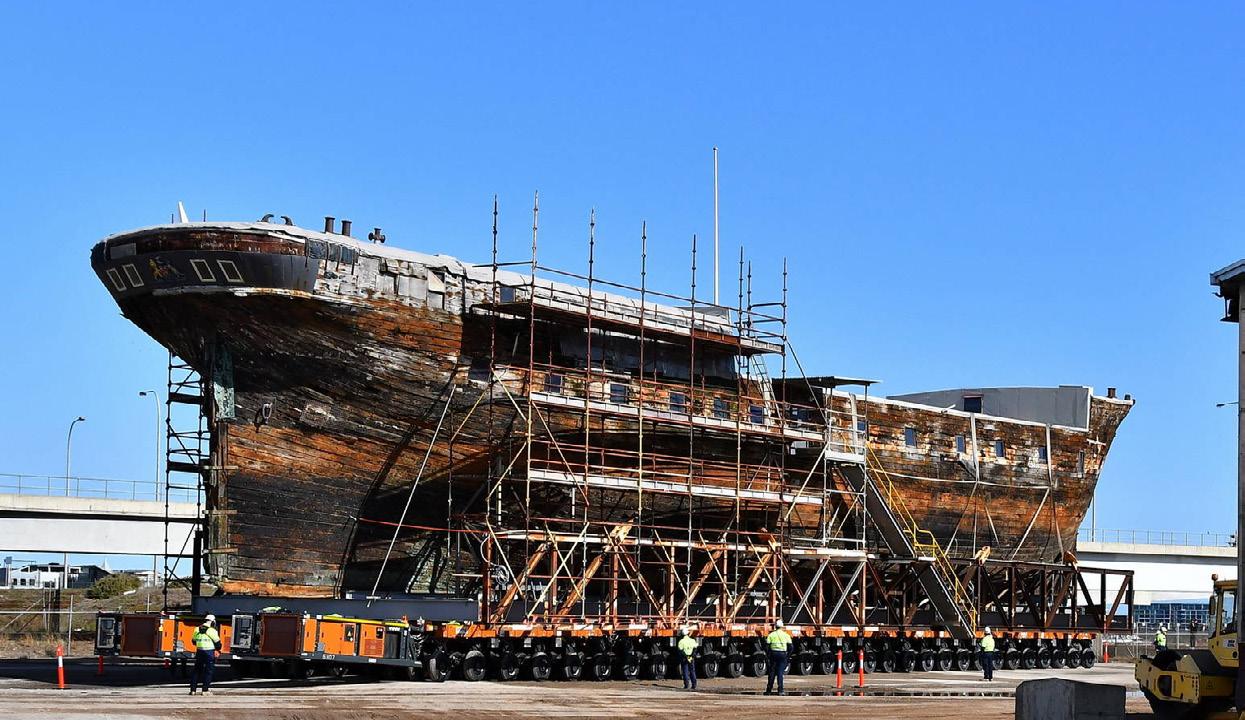
Almost 160 years since the City of Adelaide left London on 6 August 1864 and was towed up to the Port of Adelaide on 15 November 1864, the oldest surviving clipper ship in the world reached her final resting place on 16 June 2024 – a specially constructed dry dock in the same port. It had been a very long journey home from the depths of the river Clyde.
On that initial voyage the City of Adelaide carried a mixture of passengers and tons of cargo to a colony then only 30 years old. Favourable weather typified most of this journey except for a hurricane off the Cape Verde islands “in which she behaved admirably” according to her captain, David Bruce – the man who had done so much to finance and build the new vessel.
A marker had been set down that was to be kept with few alarms for the next 23 years. In that time City of Adelaide built up an enviable record of reliability and safety, only once getting into serious difficulties when stranded on a sand bar close to Adelaide in 1874. In total, the ship carried more than 1,000 passengers to Adelaide. Today, around a quarter of a million people living in South Australia can trace their ancestry to a relative who
emigrated to the colony from the U.K. on the City of Adelaide.
Often unlucky with the weather, in 1867 she made the London-Adelaide passage of 12,700 miles in 65 days, a record then. Against that, the long voyage to London around South America (about 19,000 miles) once took her 140 days in contrary winds and included the rare experience of being becalmed at Cape Horn – to such an extent that rowing boats were able to take pleasure trips for children around the ship.
A “composite” vessel with an iron frame and an oak, elm and teak hull sheathed with copper, City of Adelaide weighed in at 860 tons (gross), had four decks and three masts and was built in Sunderland by the William Pile shipyard. Launched on 7th May 1864 (five years before Cutty
Sark, the only other surviving clipper ship), she is almost 177 feet long, has a breadth of 33 feet and a depth of 19 feet. The use of iron and wood saved weight in construction and also allowed the vessel to carry greater deadweight on the same tonnage.
It is this structure that is the key to the City of Adelaide’s longevity. Says Peter Christopher, director of Clipper Ship City of Adelaide Ltd which now owns the vessel: “The ship is in remarkably sound condition, with most of its iron frames intact and its hull timbers still solid. The few hull planks that had sprung have been pulled back into place.”
At first, the vessel had a single topsail with three rows of reef points and a self-reefing mechanism which proved manageable and was the beginning of modern labour-saving technologies on a ship. Normally, she would carry up to 24 passengers. Exceptionally, more than 300 would board. On the poop deck, she boasted bathrooms and 14 cabins with plenty of head room. A long dining table filled the centre of the saloon with a pantry at the fore end and a grand
piano at the other. Below, the hold could be fitted out to carry steerage-class emigrants or, more usually, cargo such as iron and steel products (outward) and wool and wine (homeward). An experienced surgeon was always on board.
Officially, the ship sailed under the Devitt & Moore house flag although D&M were the managing agents and only owned a quarter share of the vessel – a typical arrangement in Victorian times. Thomas Devitt and Joseph Moore were two young ambitious shipping clerks who combined their skills to become successful shipowners, eventually owning 29 square-rigged sailing ships and two steamships during 55 years in the business. Almost all their ships traded on the London-Australia run.
By the mid-1880s the age of sail was giving way to the era of steamships. City of Adelaide was laid up in 1887 and her long decline began. Over the next century she morphed into a coal and timber carrier, an isolation hospital ship, a training ship for the Royal Navy (when she was renamed HMS Carrick), an accommodation ship for the RN in World War 2 and finally, in 1948, an RNVR floating club moored mostly at Custom House Quay in Glasgow.
Here, the City of Adelaide was to remain until 1989. She was then damaged by flooding and two years later sank at her moorings. Restoration work began under the auspices of the Scottish Maritime Museum shortly after, but funding dried up and by 2000 the final destruction of the ship was on the agenda. At this point conservation enthusiasts in Sunderland and South Australia stepped in to vie for control. In 2010 the Scottish government ruled in favour of the Australian group and three years later HMS Carrick was renamed City of Adelaide by the Duke of Edinburgh.
Then the issue was getting the hulk to Adelaide. Eventually funds for the
transit were raised including a generous grant by the Australian government, a 100-tonne steel cradle fabricated, a cargo ship called MV Palanpur chartered and the final voyage of City of Adelaide to Australia began on 26th November 2013. Stopping to refuel in Cape Town (last visited by the ship in 1890 while employed in the timber trade), Port Adelaide was reached in early February 2014.
There the historic vessel has rested for the past decade, sitting on a barge in Port Adelaide’s inner harbour until 16th June 2024. In the meantime, negotiations over a permanent custom-built berth near to Dock 2 began as part of a plan to develop a “seaport village” to house other historic ships and develop a tourist hub for the region. Seventy volunteers from the state started to refurbish the ship, bit by bit.
During the last ten years much necessary and important preservation work has been undertaken by the volunteers who have been led throughout by Peter Christopher, an eminent volunteer maritime archaeologist, photographer and author. Several iron frames were repaired and painted within the saloon, a replica Coat of Arms fitted on the stern, the entire saloon deck replaced and two replica cabins constructed and installed. Land was provided by the South Australian government. Tours were begun and, until Covid and lockdowns struck in 2020, something in the order of 20,000 people were visiting the ship each year.
Finally, on 16th June 2024 after two years’ detailed engineering and logistical calculations, the ship was lifted gently from the barge onto self-propelled modular transporters and for four hours moved slowly 500 metres to a massive purpose-dug pit with a concrete base. Here the hulk now resides on specially-constructed foundations. “It all went without a hitch thanks to good planning,” states Christoper.
Going forward, several major projects are in the pipeline – all undertaken by volunteers. Significant external work that was impossible while the vessel was lodged on the barge is planned, including the construction and installation of two replica masts. A new figurehead paid for by a well-wisher will be attached – with a kangaroo on one side of the bowsprit, a lion on the other and a shield pointing forward. A third cabin will be built at the very stern of the ship. Externally, a major push is underway to raise funds for a lift outside the ship to facilitate disabled access. And around City of Adelaide it is hoped that the concept of a seaport village with a dozen other historical vessels and research facilities will begin to take shape, initially using shipping containers. No one can say for certain what this effort sustained over 25 years has cost South Australia or Christopher and his team – “millions of (Australian) dollars and countless hours of volunteer time,” according to one claim. Yet the expense is not decried. “City of Adelaide is a priceless part of South Australia’s history and a unique link to the growth of the Australian nation,” says Christopher. “Saving her is saving an important example of naval architecture in the 19th century and also a milestone in maritime history.”


Remembrance Sunday is always a very special and moving occasion at Pangbourne College when the whole community, past and present, as well as friends of the College, remember those who have paid the ultimate sacrifice for their country. Each year the College remembers, in particular, the heavy loss of life during World War II when 177 Old Pangbournians and one Governor were killed, as well as the 255 servicemen and three civilians who died in the Falklands War of 1982 and whose memory is not forgotten in the Falkland Islands Memorial Chapel.
This year Rear Admiral Nick Washer, Director of Operations, Defence Digital, took the Remembrance Sunday salute and Chief Cadet Captain of College, Will Rowton-Lee (Upper Sixth, Hesperus) led the Parade. The preacher at the Remembrance Service before the Parade was The Right Reverend Dr Tim Wambunya, who himself served for seven years in the Royal Navy before training for ordination.
The Remembrance Service was led by the Chaplain, the Reverend Neil Jeffers. During the playing of Nimrod, wreaths
were laid by Mr Thomas Garnier (the Head), Patrick Roberts (Chair of Governors), Phillip Plato (Chair of the Old Pangbournian Society), Kelley Waters (Pangbourne Parents’ Association), Wing Commander Nick Monahan (RAF Benson), and Stuart Hulley (April Fools’ Club). The Colour Party included Lower Sixth students Dominic King (Hesperus), Moin Chowdhury (Macquarie), and James Pullen (Hesperus).
The Chamber Choir, conducted by Mr George Picker (Assistant Director of
Music), sang a cappella Durufle’s Ubi Caritas. The College Choir, conducted by Mr Chris McDade (Director of Music), sang Douglas Guest’s They shall grow not old. Four of the Upper Sixth, Josh Bywater (Port Jackson), John Harper (Port Jackson), Jemimah Nusi (St George), and Finlay Stewart (Hesperus), whose parents are serving in the Armed Forces, read out the names of each of the Old Pangbournians and the Governor who died in World War II.
On the Parade Ground, the Chaplain completed the Act of Remembrance,
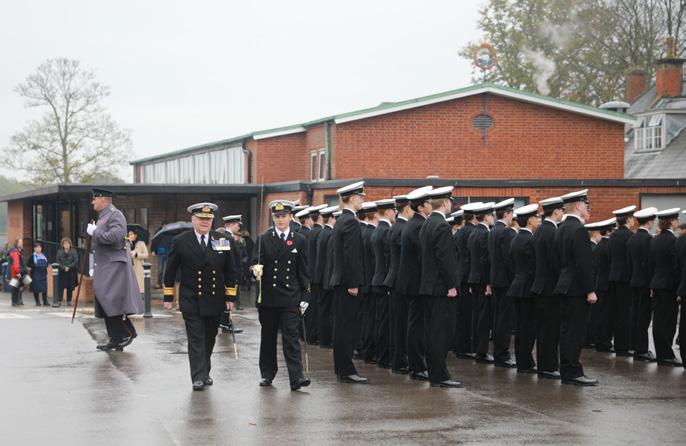

with Eve Allen (Lower Sixth, St George) playing the Last Post from the top of Devitt Tower and SSI Mr Paul Radford sharing the poignant verse of Laurence Binyon’s poem ‘For The Fallen’, ‘They shall grow not old as we that are left grow old, age shall not weary them, nor the years condemn. At the going down of the sun and in the morning, we will remember them’.
During the inspection of the College by Rear Admiral Washer, the Marching Band, conducted by Bandmaster Mr Andrew Thornhill (himself a former Bandmaster and Director of Training, Royal Marines School of Music), played Rinaldo and Theo Stephenson (Year 11, Harbinger) played Highland Cathedral on the bagpipes. Between Scipio (the slow march) and Hearts of Oak (quick march), RAF Benson provided a flypast. The Marching Band then accompanied the College with This is My Country (another quick march) before marching off to Heroes

On Remembrance Sunday afternoon, Drum Major Imogen Kingsland (Upper Sixth, Illawarra) and our Marching Band led the Remembrance Parade through the village of Pangbourne. They performed Oh When The Saints on the fifes and drums, Hearts of Oak, and This is My Country. Around the War
Memorial in the churchyard of St James the Less, local uniform organisations laid wreaths, including James Blandy, Old Pangbournian, for the Royal British Legion. Eve Allen played the Last Post in the Remembrance Service which followed.
In the churchyard of St James the Less is buried Sir Philip Devitt, the younger of our College’s founders who lived at Pangbourne College during World War II and who experienced first-hand the cost to the College of the lives lost during that major world conflict.

OP Andrew Adams (79-84) visited the College in November to share his knowledge and expertise with the CCF Royal Navy Section.
On Thursday 16 November Andrew Adams (79-84) visited the College to share some of his extensive knowledge and practical working experience with our CCF Royal Naval cadets. On this occasion, he gave them an introduction to ‘Cordage - Bends and Hitches’ (aka knots).
Andrew also gave them an insight into the benefits of an education at the College in the late 1970s and early 1980s when Seamanship was a timetabled subject. You could achieve an O Level (former qualification to GCSEs) in Navigation, and there was life experience aboard MFV Sheemaun. The latter was a beautiful 1930s classic gentleman’s motor yacht and an ideal boat in which to learn about the sea because of its generous accommodation, two engines, and gaff ketch rig.
From 1987 to 2022 Andrew served in the Royal Navy Reserves. He was appointed skipper of Her Majesty Queen Elizabeth II’s Rowbarge, Gloriana, from 2014 to 2022. With Ben Maxwell OP as First Mate, in July 2017 Andrew was the Skipper of Gloriana for the College’s Centenary rowpast at Henley Royal Regatta.
Andrew described how on the day of Her Late Majesty’s funeral in September
2022, the Rowbarge was at Runnymede clad in black with oars tossed in salute as the cortege passed by and made its final journey to Windsor Castle.
Andrew also explained to the cadets that an important part of his career has been boat haulage. This has included looking after classic umpire launches, such as those used at Henley Royal Regatta, as well as being on the team of skippers of these special boats.



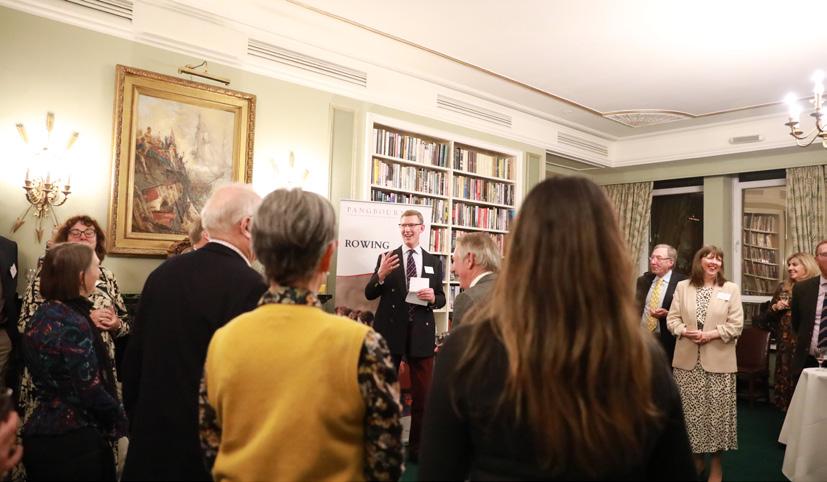

On 29 February 2024, a committed group of Old Pangbournians, parents (past and present) and staff, braved the rain to meet at the Army and Navy Club in London to celebrate Thomas Garnier’s Headship.
To kick off the evening, Mark Dumas, President of the OP Society, toasted the Garniers, thanking them both for their enormous contribution to the College. Thomas Garnier then took the floor, thanking Mark and the attending guests before looking back on his time at the helm and sharing the positive future he sees ahead for Pangbourne.
After the speeches, the community connected over happy memories at the College, and over drinks and canapés, The Library buzzed. A passing previous
CCCC, James Greaves, spotted the College signage and popped in to pay his respects. During the evening, guests were invited to share their memories and best wishes in a dedicated keepsake book which was presented to Thomas and Alexandra on Founders Day by the Chair of the OP Society, Phillip Plato. As the doors closed for the evening and the College team made their way back to Pangbourne, a group of OPs could be seen heading off to continue the celebrations. Definitely a night to be remembered!

June 2024 saw the 7th annual classic car show organised by Head of Boarding, Tom Cheney. Back in 2016 he started the show with two purposes in mind. Firstly, to showcase the evolution of motoring to the pupils taking part in the Car Restoration activity he runs at the College and secondly, to raise money for local charities that support children.
Since the show's concept it has grown in popularity year on year due to its friendly, relaxed atmosphere and the unusual nature of all the cars being parked in make and age order in the display.
The show over the past seven years has always supported Footsteps Foundation, a charity supporting children with neurological conditions and over the past three years has also supported the Pangbourne College Community Fund.
This year was the biggest show to date with over 370 vehicles on display with
the addition of Sporting Bears, who brought 30 vehicles, giving people dream rides in the Berkshire countryside, which once again proved to be very popular with members of the public that attended. The sheer variety of cars on show was simply amazing and there were some very rare and not often seen classics, with the oldest car on show being a lovely 1904 Oldsmobile. If the more modern of cars was what you were after, there was also the latest Lamborghini Revuelto; there was a car for everyone!
The show was supported this year by Kingdom Coffee, Aston Martin Reading
and Lamborghini Pangbourne who have been with the show since concept. Also this year we were thrilled to be joined by Howden Insurance, Elliott James Consulting and The Fine Car Company, who held a small auction at the show. The support of the sponsors is really important, allowing us to raise the maximum amount of money for our two charities.
Tom Cheney, event organiser, said, ‘I am so proud of our small event and how it has grown to become such a lovely event enjoyed by so many. We have raised over £10,000 for our much needed charities



this year, which is simply a spectacular amount and I am so grateful. I must pay thanks to all of the volunteers who help marshall on the day. As you can imagine, having 370 cars to park between 08:00 and 10:00 takes some doing! Also to our wonderful sponsors, their support of the event enabled it to happen. Finally to all of the amazing people who brought their cars to show on the day, these fantastic machines really do make the display a special place to walk around and admire.’
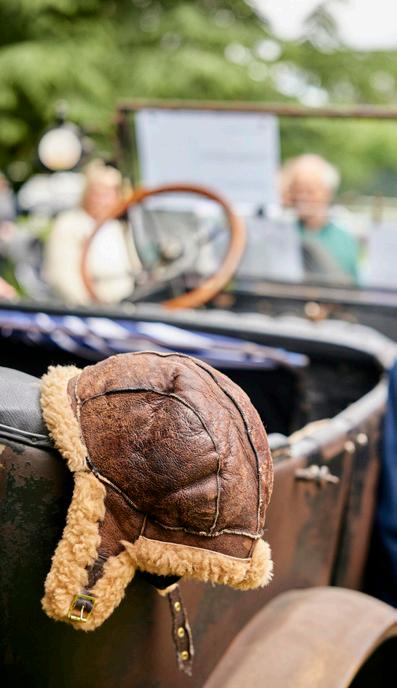


After a week of unseasonably wet and windy weather, the sun shone brightly for the Boat Club Open Afternoon in June.
OPs, current parents and students met by the river for a few hours of fun on the water to catch up with friends. The event started promptly at 2pm with a safety briefing from the Director of Rowing, Tom Wilkinson, and after a quick reminder of the do's and don'ts on the river, it was time to launch the boats. With Noah Lowe, current Captain of Boats, and Rob Hamilton (60-65) and Garth McDonald (59-63) (OPs), members of the 1963 Princess Elizabeth Challenge Cup winning crew, not to mention Charlie Shilito (98-03) and Reuben Reggiani (02-04) (OPs) members of the 2003 winning VIII, there were plenty of experienced rowers available to help the novices, some of whom had never rowed before.
While the rowers rediscovered the delights of a summer's afternoon on the Thames, those who had chosen to remain on dry land occupied the deckchairs and soaked up the sun while reminiscing about their time at the College. When the boats returned they were met by the smell of freshly cooked pizza, which together with a selection of drinks and cakes, helped to refuel tired bodies.
To round off the afternoon, Tom Wilkinson and the Head, Thomas Garnier, spoke about the achievements of the Boat Club and also about the exciting plans for the future of rowing at the College. We hope everyone enjoyed a lovely, relaxed afternoon.

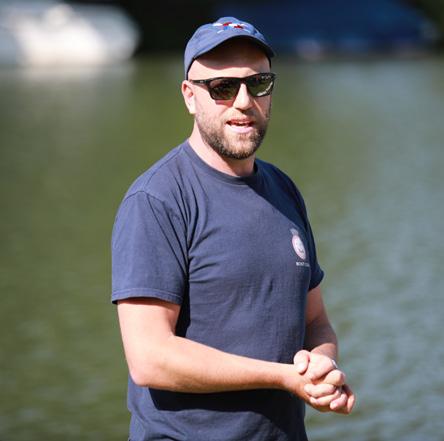









In July, Henley Royal Regatta week got off to a flying start with the 1st VIII qualifying for the heats of the Princess Elizabeth Challenge Cup. On Wednesday, Year 9 visited the Regatta to watch the racing and soak up the atmosphere. The opportunity to watch and be inspired by some of the best crews in the world was one not to be missed.
Thursday, thankfully, turned out to be a glorious sunny day, as we welcomed a large number of OPs to the Pangbourne tent in Lion Meadow to celebrate all things rowing, The number of Paravicini blazers to be seen at the Regatta seems to grow year on year and the Pangbourne tent was the ideal spot to grab a drink
and a light lunch and meet up with friends and fellow rowing enthusiasts. Among the OPs in attendance was Frankie Allen (15-20) who was a gold medal winner representing Great Britain at the Paris 2024 Paralympic Games.

Finals Day began on a high note with OP Philip Garnier (13-18) and his crew from Thames Rowing Club proving victorious in the prestigious Britannia Challenge Cup. Fellow OP Rory Harris (11-16) and his crew from the Leander Club won the Queen Mother Cup. The trophies were presented by His Serene Highness Prince Albert II of Monaco and the winners' medals by Sir Steve Redgrave. We'd like to extend our warmest congratulations to both crews and all the College crews who put so much hard work and dedication into this event.

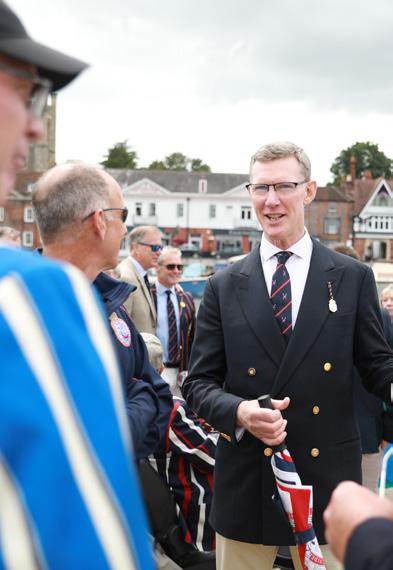


News about and from OPs in 2023/24. Some items have been edited and shortened, with the full news items available to read on the OP website. Please send your news for the next edition of the Magazine to editorial@pangbourne.com
Tony Hayes
I joined the Nautical College Pangbourne in January 1950, first in Port Jackson and later Harbinger, at Bowden Green, leaving in 1953 to join the Merchant Navy. I joined the South American Saint Line for 7 years as an apprentice, cadet and eventually a qualified deck officer with Blue Star Line. I travelled the Atlantic, the Caribbean, went round Cape Horn to Valparaiso, the Falklands, South Georgia and the Antarctic where in theWeddell Sea in 1958, I was collecting USSR equipment and penguins for shipment to Murmansk.
Later, as an established RNR S/Lt to the Royal Navy, I served for 8 years aboard the aircraft carriers, HMS Centaur and HMS Hermes and had a spell at Lossiemouth and Culdrose, as an Air Traffic Control and Operations Officer. Under my RNR hat I trained in midwinter with RAF 41 Jaguar Squadron, in Bardufoss (Norway), Germany & Holland, and also with the Royal Marines for 'winter survival training' in north Norway in minus 20ºC, living in self made igloos, or trenches covered with tree branches covered in packed snow and trying to ski with weapons and heavy backpacks. I then became Head of Naval Photographic Intelligence, retiring with a RD in 2005. However, returning to the staff at the Nautical College Pangbourne, in my time I can clearly recall Charlie Sewell who was effectively
Master at Arms (discipline) and after being caught with cigarettes in the Photo Club, I was sent to Captain Skinner for my punishment. Charlie Sewell was, however, a very good instructor in the 'Seamanship, Signals & Navigation' areas, my best O Levels. I also recall 7am morning runs and cold showers before going from Bowden up to Devitt for breakfast. I took up the bugle and played reveille at 06:30, thus avoiding the run !
The Housemaster, Percy Robinson at Harbinger, was also the principal maths teacher. He had a very hoarse and guttural voice, having been gassed in WW1, and if he thought you were not paying attention, a wooden block blackboard cleaner would arrive at high speed, bouncing off your head! He must have been very good with actual grenades! Later, in my post Pangbourne career, I worked in Civil Air Traffic Control as an airways radar controller at London Centre, then at Eurocontrol (Brussels) to manage the introduction of Aircraft Collision Avoidance Systems across all European states and later the former USSR areas, altering their whole ATC systems to match the ICAO standards. In 2015 I visited Sydney and accidently fell in with an OP / Conway / Worcester gathering which was a big surprise. I was amongst the most ancient and am now approaching 87! Yours aye, Tony Hayes (50-53), College number 115.
The OP Gurkha Curry Lunch
On Friday 25th April OPs attended a

very successful lunch organised by Robin Paine (55 - 58) at the Gurkha Museum, Winchester. Twenty-five OPs, spouses/ partners gathered in the magnificent McDonald room at the Gurkha Museum for what transpired to be a delicious Gurkha lunch in convivial company, Robin Paine writes. Unfortunately, we didn’t quite have sufficient numbers to have our own private event which, despite asking for one long table for our group and planning accordingly, ended up with us having to have two. Even so, judging by the noise and laughter, it was not a major issue. It seemed successful enough to try again next year to have our own private event.
After lunch, Richard Shuttleworth (57-62) presented Doug Henderson, the assistant curator, with two pieces of
memorabilia of HMS Gurkha, the ship’s crest together with an engraved ashtray. Richard served in HMS Gurkha from 1963 to 1964 and commented: "I was in HMS Gurkha as a Midshipman in 1963 -1964 during her 1st Commission. She was a Plymouth ship but we circumnavigated the UK and then sailed through the Med via Gib and Malta on to Aden and Bahrain. We were based in HMS Jufair in Bahrain and went all over the Indian Ocean, including Aden, Mombasa, Madagascar, Seychelles, (then) Bombay and Karachi. My Skipper visited the Gurkhas in Nepal from Bombay. It seemed appropriate that the museum should have these memorabilia."
OP awarded MBE in New Year's Honours
Mike Lubbock (57-61) has been awarded the MBE in the 2024 King’s New Year Honours List 'For services to Global Wildlife Conservation of Water Birds'.
Mike has spent a lifetime since he left the NCP in the world of avian breeding and behaviour and, more specifically, waterfowl conservation. In his time, he has hunted high and low for birds’ eggs
(his collection is now in the American Museum of Natural History in New York). At one point he was Curator at Slimbridge Wildfowl Trust on the Severn estuary and advisor to HM The Queen on duck breeding matters. He has criss-crossed the globe trying to save rare and endangered species, won 17 World’s First Breeding Awards and been inducted into the International Waterfowl Association’s Hall of Fame.
Notably, in 2007 he set up, and has run ever since with his wife Ali, the Sylvan Heights Waterfowl Park and EcoCenter at Scotland Neck in North Carolina in the United States of America. Now 80 and not in great health and thus unable to travel to the UK to receive his award, he still watches birds on the Outer Banks of North Carolina, getting around on a golf cart and tractors.
Based in a farming community close to the winter home of 75,000 Tundra Swans, the Sylvan Heights centre is both a huge breeding and conservation centre as well as a beautiful bird park which is open to the public and has become a mecca for waterfowl lovers throughout North America. In 2014, Mike’s

biography The Waterfowl Man written by Dale True was published in the USA to wide acclaim.
Mike Lubbock’s award is a second MBE conservation award given to an OP in recent years following that given to Michael Keigwin (86-93) in the 2017 New Year’s Honours List for his ‘Services to African Wildlife and Conservation.’
In 1998 Michael set up a project for elephants, crops and people in Ishasha in the southern part of the Queen Elizabeth National Park in Uganda. Working with the Uganda Wildlife Authority, his initiative managed to reduce elephant crop raiding by 90% and drastically limit poaching.
The Turf Club Lunch - 2023
The 2023 Turf Club lunch took place on a day brimming with autumnal sunshine and with a military band playing nearby in honour of His Majesty The King opening Parliament for the first time as Sovereign.
The special lunch hosted by Mark Dumas (64-68), President of the Old Pangbournian Society, was Thomas Garnier’s final lunch as Head of Pangbourne College. Mark thanked him and Alex, his wife, who was also present for this occasion, for their partnership in leading the College since 2005. Among the 40 or so guests were Trevor Kearley (49-51), who has now succeeded Courtney Edenborough as the oldest Old Pangbournian. Trevor attended the College for two years before going on to Dartmouth at 16 years old. Also present was Lucinda Grafton, Head of Development. The OPs enjoyed a delicious three course lunch of soup, ‘bangers and mash’ and Welsh Rarebit

whilst reminiscing about their time at the College. Many tales were told, some not to be retold, and laughter could be heard throughout the Turf Club. In a short speech, Thomas thanked everyone present for their support over many years and highlighted the benefit donations collectively bring to the College, particularly encouraging attendees to consider leaving a legacy to the College. He talked about the impact this funding can continue to offer for transformational bursaries, such as in the case of Tomas Tokovyi (??-19), who has continued to excel in his postgraduate studies and recently became the fourth person globally to ever secure both the Gates Cambridge Scholarship and the Oxford Clarendon Scholarship, amongst the most prestigious scholarships at the two universities.
A long distance reunion!
Jamie Cunningham (70-75) writes "One year shy of half a century since I’ve seen John Lyne (on the left) at Pangbourne College, I was over from New Hampshire (last October 2023) where I live, along with my partner Penni
Kaufman visiting my good friend Jamie Stewart and his wife Su Stewart. Our photo was taken at the Stewarts' home in Yeoford, Devon, just on the NE corner of Dartmoor.
John and I have kept in touch through the years, but he and I had to pack in a lot of catching up in one evening with a nice cook out and wine. We were at Pangbourne between 1970 and 1975. It was great to visit England again. I was last over in 1981 when I taught rock climbing at The National Centre for Mountain Activities, Plas y Brenen, Capel Curig in Northern Wales."

Chris Weston (77-82) appointed Head of Thames Water
Chris Weston, 59, will take over his new role in early January 2024. He was previously head of the mobile power generator group Aggreko for six years until 2021, when it was taken over in a £2.2 billion acquisition by a private equity firm. Before that he worked for 13 years at Centrica, latterly as the director in charge of British Gas, and held a number of senior roles in the Australian and UK telecoms sector.
According to the Thames Water chairman, Sir Adrian Montague, Weston has been appointed for his all-round business competence and achievements. “He has a proven track record working in regulated environments, turning round business performance and improving customer experience and he brings strong operation and strategic expertise.”
Weston once served in the Royal Artillery and from 2017-23 he was a non-executive director of the Royal Navy. Of his latest role, he says: “It will be quite a challenge. But I have no doubt it will be fascinating, and it is important both to society and to the UK. I am very

much looking forward to joining the team at Thames and working to restore confidence in both its finances and operations. Lots to keep me busy.” 1980s
Lord Archer credits OP in his recent action-packed novel
Rory Copinger-Symes CBE (79-83) has experienced many unique situations during his long and distinguished military career, a fact not lost on prolific best-selling author, Lord Jeffrey Archer, as Rory relates below.
"I shan't bore you how it came about but I found myself on the phone with Lord

Archer who set me a task. Essentially he said 'I need you to write me a piece to explain how the Royal Marines would rescue Princess Diana if she were taken hostage on a super yacht.' Jeffrey said he wanted lots of detail ("all the stuff you find boring but us civilians are fascinated by") and the scenario was based in the early 1990s with Princess Diana being taken hostage 'you tell me by whom and where, and then tell me how you would rescue her!' A simple enough task and he gave me 10 weeks to write as much as I could. So having developed a host of fictional characters (closely based on characters I had known during my career!), chosen the super yacht and Mallorca as the venue, I went about building a story. Key was all the detail Jeffrey wanted but I had to ensure it was all information that was available on the internet so as to avoid giving away any secrets. After turning in my draft of about 70 pages, Lord Archer then spent about a month digesting it before he came back and told me to cut it down to 10 pages and just focus on the rescue operation. I duly went away and produced a shorter piece focused on how we might execute such a rescue at sea and returned it to
him. After another longer period Jeffrey then came back to me and we spent several hours together with him telling me how the operation was to happen and me correcting him at any occasion if it was something we wouldn't have said or done. In other words he was ensuring he had absorbed the details of the way in which we operate to ensure he was as authentic as possible. Another longer period passed and then I received his initial draft which I was to go through and amend anything I felt was incorrect. This done I then received a final editor's draft to proofread. Then about a year later, through the post, I received the final hardback version duly signed by Lord Archer and soon after the book was published in late September 2022. So if you fancy a great read, grab a copy - & no, I don’t get any royalties!"
OPs reunite in Australia
John Saunders (89-92) owner of an international events company in London was on vacation in Australia when he decided to meet up with fellow 'Class of 92' members Richard Hamilton and Oliver Peagam after 31 years! Richard Hamilton (87-92) is currently the Co–

Owner / Director of Mitta Agricultural Company in Northeast Victoria near Tallangatta, which has 1000 dairy cows, 1000 beef animals and 800 head of youngstock across 1500 hectares.
Oliver Peagam (87-92) has been based in Australia since 2007 and has worked in Formula 1 and for various car manufacturers in the marketing and PR arena. He has now set up on his own with RAM Trucks, Renault and Maserati as clients and recently co-founded the Vault House Group which is a private members club which has just opened its second venue in Sydney.
OP Shines a light on a forgotten victory
OP Tom Golding-Lee (07-13) has written a chapter for an excellent new book titled Sailors, Ships and Sea Fights which will be of interest to anyone with a love of naval history. The book is published by Helion and Co. and looks at a forgotten victory of the Royal Navy during the American Revolution, the Battle of St Lucia in 1778. Tom has dedicated his chapter in memory of Robin Brodhurst, as Tom says, without whom he would never have become a military historian.

OPs enjoy a day at the races
Georgia Misson (07-12) writes: Myself and Wiggy Bamforth (05-12) were hosted by Charles Guest of Great British Racing for the most recent British Champions day at Ascot Racecourse. Not realising until we arrived that we recognised each other, we enjoyed a fantastic day of racing whilst reminiscing about our time at the College and discussing our current roles within horse racing. A good reminder that the world is small and the OP network useful! If there are any other OPs who are interested in an OP horse racing group, then please do get in contact with georgiamisson@ hotmail.co.uk
A chance encounter
The College received an email from OP Oliver Newcombe, which reinforced the old adage 'It's a small world.' Ollie writes: Myself (12-17) and Luke Hedley

(13-16) had both just completed the Ha Giang Loop, a 400km bike ride through Northern Vietnam.
Luke was sitting behind me on the bus to Hanoi from Ha Giang. It was only when Luke had spotted my old Pangbourne cricket shorts that he mentioned he was an OP!

What are the chances, halfway across the world, that two OPs would be on the same bus, let alone a seat apart!
We then went for a couple of beers in Hanoi the next day to catch up on all things Pangbourne. Luke continued his travels down Vietnam on a motorbike while Ollie travelled on to Thailand, Laos and Cambodia.
Ryne Robson
Many congratulations to Old Pangbournian Ryne Robson (Captain of Boats 21-22) who was selected to represent England at this year’s Home International Rowing Regatta at
Strathclyde on Saturday 27 July 2024. He and his quad took Gold in both the 2,000m and 500m sprint events. He also came second in the Single Scullers’ event.
Overall, England were the Champions of this year’s Regatta.
Andrin Gulich
Olympic success OP Andrin Gulich (15-17) and team mate Roman Roosli clinched Bronze at the Paris Olympics representing Switzerland in the double sculls.
No strangers to success, the pair had taken Gold at the World Championships in 2023, racing in the coxless pairs.


Ani Cook
OP Ani Cook (15-17) and her fiancé, Harry Brightmore, had cause to celebrate in Paris recently when Harry coxed Great Britain's men's eights to Gold at the Paris Olympics. The 30 year-old from Chester came into the Games off the back of coxing the team to successive world titles in 2022 and 2023.
Ani, who is a former Captain of Girls Boats, is now also Head of Psychology at the College as well as a rowing coach, made the journey to France to cheer on the GB rowers.
Harry and his crew won their heat with a time of 5.37.04 and then repeated the feat in the final to bring home the Gold.
"For the first time in a good couple of months, I woke up and my body was like 'we've got to be nervous for something today' and I had to stop and be like 'it's fine, it's all over' and I can just breathe," Harry told BBC Radio Merseyside.
On a rare break in the weather, warm sunny conditions and a beautifully presented Beaconsfield golf course welcomed 18 Old Pangbournians for our annual Summer meeting.
The morning round, traditionally played under Stableford format and competing for the President’s Prize Cup, was duly won this year by Ken Jones with an impressive 40 points after a tense countback against his brother Jeremy.
Then, in its second year, the Terry O’Neil Memorial Trophy was won by Charlie Parry for his patient 20 points on the back nine.
Pip Smitham took the honours for nearest the pin on the par three 7th and Ken Jones made the longest drive on the par five 17th hole.
A fine luncheon of roast beef and Yorkshire pudding, followed by Eton mess and coffee provided welcome rest and warm conversation before the afternoon foursomes.
Played over ten holes, the Simon Broome and Stephen Walker Memorial Foursomes Bowl was won for the second year running by foursomes specialist Peter Lowe and his new playing partner, Richard Parrett.
Sandwiches, cold drinks, prize giving and humour was ably orchestrated (as always) by our Club Secretary Charlie Parry, bringing an end to an enjoyable day.






The Society members who attended our 2024 meeting were:
Charles Llewellyn (56-61)
Hugh Fraser (64-68)
Pip Smitham (64-69)
John Cooke (72-76)
Christopher Reed (75-80)
Richard Sarsfield- Hall (76-83)
Giles Fuchs (78-83)
Richard Parrett (72-80)
George Gale (81-85)
David Lewis (81-85)
Charlie Parry (81-85)
Ken Jones (81-86)
Peter Lowe (81-86)
Jasper Fulford Dobson (81-86)
William Skinner (82-87)
Nick Kemp (04-10)
Jeremy Jones (62-66)
Kris Kemp (04-08)
Our next meeting is the match versus the College on Wednesday 25 September. Please contact the secretary Charlie Parry Charlie@masterremovers.co.uk to book your place.
Tudor Rose organised another delightful East Coast meet up for the OPYC on the Thames barge Thalatta, cruising up and down the Orwell and Stour rivers and dining at the Suffolk Yacht Harbour on Saturday 25 May.
Despite a fair weather forecast we joined the Thalatta in drizzle and following a droll briefing from Cyril the Master, we slipped and unlocked from Ipswich Marina and stemmed the flood tide down towards Harwich. First man up at the wheel was Charlie Allen’s father, William. He had been a Navigating Officer in the RN and I asked him which ships… “Well, the smallest was HM Submarine Cachalot and the biggest was the Ark Royal. Not the newer Ark Royal but the proper one…the big one.” We were in safe hands!
There was lots to see including the UK’s biggest container port at Felixstowe with ships big enough to block the Suez Canal, big red lightships swinging at the Trinity House buoys, the Royal Hospital School at Holbrook and even Grayson Perry’s green tiled house. A delicious lunch preceded an attempt to sail. Whilst it was fun to get the sails out and see how this 90 ft barge could be handled by ‘a man, a boy and a dog’, there wasn’t really enough wind, so we motored back in glorious sunshine to be back in time for dinner at the Old Cromer Lightship which serves as the clubhouse for Suffolk Yacht Marina.
OPs in attendance: Jeremy Owen, Ian Williams, Andy Roy, William Allen (55-59), Charlie Allen (85-90), Miles Gordon-Smith, Tom Bendall, Tudor Rose, James Minter.



by Peter Kewish (84-89)
The Arrow Trophy is an annual regatta between alumni of some 20 private schools competing in 40 foot yachts in the Solent over the first weekend of every October. The management rotates every 3 years between the schools based on participation. Since Pangbourne have entered since 1997, eventually we would have to pay back what we have taken and having skippered the Pangbourne boat for a decade, it fell on me to in 2021 to manage the event for the next 3 years.
It’s not just about the racing, the social scene is huge too. The pubs and restaurants of Cowes High Street are brimming with crews from Thursday evening onwards, Friday night is a Dark and Stormy night with discounted drinks held at one of the local sailing clubs and Saturday culminates in a formal dinner at another. Bumping into old friends from other schools, meeting new people, and keeping up the same rivalry we enjoyed on the sports fields many years ago continues.
There is no way, such an event can be run smoothly whilst skipper a racing yacht, so I handed the latter over to James Minter (83-88), who has done a sterling job of recruiting crew, getting
them to work the boat together nearly as well as they party, and working his way up the fleet to achieve 3rd position by 2024.
Organising such events takes time, effort and energy. There is no way I could have done it without the support from fellow members of the OPYC, who turned up in all weathers to fly the Pangbourne Battle Flag.
My 3 years is now up and I am delighted to be handing a ‘good ship’ over to my successor school Malvern. Whom, I’m sure will be met with similar challenges and stresses that I have but will overcome them to create a fantastic weekend for all those involved.
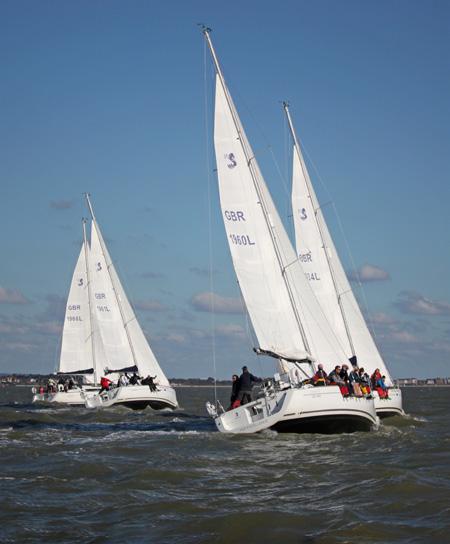
If you are interested in joining or would like to find out more about OPYC please contact alumnirelations@pangbourne.com
The Pangbourne College Alumni Survey was launched in June 2024 with the aim of engaging with Old Pangbournians to better understand their views, attitudes and preferences relating to the College, OP events and communications, The Old Pangbournian Society and fundraising. The survey was designed to help shape the future strategic direction for alumni relations and fundraising at Pangbourne and inform a programme of events, communications and services to keep OPs in touch with each other and strengthen their connection with the College.
We received 372 completed surveys (a 14% response rate which was within the expected range), and 129 respondents provided their contact details and permission for the Development Team to contact them about subjects they selected such as fundraising, supporting careers and providing case studies. The bespoke, online survey was developed and delivered by RSAcademics (leading experts in school stakeholder research) and included a mix of ‘quick fire’ questions and open, free-form questions. The survey was anonymous which, we hope, encouraged objectivity and honesty in responses. Overall, the survey delivered a very encouraging set of results; the written comments were positive overall, and the data compared well with that from other schools (where available). A summary of the output follows.
We are delighted to report that 86% of respondents are proud to have attended Pangbourne College, 74% were happy during their time at the College and 40% feel connected with the College
today. RSAcademics has confirmed that the statistics relating to ‘pride in attending’ and ‘connection today’ compare well against responses received by other schools of a similar profile to Pangbourne.
88% of respondents (326 alumni) wrote comments, which covered a wide range of aspects of College life since the 1950s. Most of the comments were either broadly positive, recalling happy memories and an appreciation of the opportunities experienced, or neutral, recalling time at the College without negative or positive association.
The most mentioned memories related to friends, camaraderie and preparation for life. Other themes evolving from the memories include co-curricular activities, teachers and the military influence. Inevitably, some comments were negative, and we are grateful for the candour of the authors in helping us to better understand life at the College across the decades and the challenges it presented for some.
The graphic opposite summarises the responses about memories from College. The size of each bubble broadly reflects the number of mentions of each type of memory within the 326 comments received.
We asked about the importance of our alumni services. The responses told us that news about fellow alumni, careers support, professional networking and reunions were ranked as the most important services for the College and the OP Society to provide. It is heartening to report that 84% of respondents felt that fostering a sense of community between the College and its alumni is important. Based on this we will endeavour to further strengthen levels of alumni engagement through the ongoing provision of these services.
With regard to communications, the respondents expressed very strong preferences for content from the archives, obituaries, updates from the College and alumni news. These will all continue to be areas of focus for us. There is also strong support for the
Pangbournian Portal and the Annual Magazine and both will continue to be key foundations for ongoing alumni engagement.
With regard to events, there was strong support for year group reunions, reunions for all alumni, as well as dinners and drinks.
We were encouraged by your feedback with regard to fundraising and now have a deeper understanding of alumni views with regard to different causes and overall propensity to support the College. Respondents are, in general, in support of the full range of fundraising causes and tend to favour hardship funding, ‘enriching the academic curriculum through new facilities’ and bursaries as the most important priorities. We have noted that two areas that provide opportunity for greater focus are donor stewardship and raising awareness of legacy giving and its associated taxefficient benefits.
As the survey responses have been analysed by year group it enables us to better align activities to different generations. While some of this analysis may not be surprising, (e.g. careers and networking events are particularly important for leavers from the last 20 years; Pangbourne College history is of most interest to leavers from earlier decades), other segmentation is more revealing (e.g. OPs who left in the 1970s and 1980s use The Pangbournian Portal proportionally more than OPs from other decades; the most recent leavers feel least connected to the College).
More broadly, we have noted that within the 372 respondents, there are three
minority responder groups: 28% left the College after 1990, 21% live outside the UK and 8% are female. We are therefore particularly keen to engage with more recent leavers, our international OPs and our female OPs. We will carefully consider how we can do this but if you fall into one of these groups please feel free to get in touch if you have further thoughts and ideas.

Importance of alumni services
“PangbourneCollegeandTheOldPangbournianSocietyarereviewingtheservicesweprovideforalumniandthewaysOPs interactwiththeCollege.Pleaseindicatehowimportanttheseareorwouldbetoyou.”

Thank you again to all who completed our survey. Your insights, views, memories and opinions have collectively provided vital intelligence to help us deliver services, events and communications that will be of most interest to you.
We are particularly grateful to the 129 OPs who left their contact details so that we can stay in contact about a range of subjects from providing careers support to making a donation.
by Robin Knight
Reviewed by Ewen Southby-Tailyour (55-59)
Any book written or edited by Robin Knight (56-61) will not disappoint and Salt Horse is no exception!
Rear Admiral Claude Lionel Cumberlege’s diaries are crammed full with colourful stories, dozens upon dozens of colourful stories, that Robin has so skilfully edited.
The Admiral led a remarkable and unconventional life both within the Royal and Royal Australian Navies and as a ‘civilian’; so remarkable that it is perhaps surprising that his account has taken so long to reach the public. It was originally written between 1936 and 1938 before gathering dust.
The anecdotes, so vibrantly recounted by the Admiral and so skilfully knitted together by Robin, are too numerous to list but they start with a most descriptive, and surprisingly sympathetic account of Royal Navy officer training in 1889 when he was just twelve. As he was to do throughout his long life (he died aged 86), he made the very most of every situation.
One apposite quote from his training days centres on beagling, after which the rare luxury of a hot bath was mandatory. However, the admiral recalls, provided you returned on board covered with rich, red Devon soil even if you had been nowhere near a hound, a hot bath could be enjoyed. As he declares, ‘It is always good for the wits to outmanoeuvre
taskmasters’. True to his word he was to outmanoeuvre many more taskmasters. It is also fair to add that Claude Cumberlege knew how to enjoy a run ashore, with the ensuing scrapes, from almost his first day in the navy to his last, and they did not end then!
How he came to command nine torpedo boats in Gibraltar is a serious lesson in serendipity! Torpedo Boat TP 99, from which he commanded this small flotilla, was his first command of a further 12 warships without a break from 1905 to 1921 while, in his words, ‘Growing no corns on my backside through sitting on an office stool. From the day that I joined that perfect little vessel until the day, in 1922, that I was invited to quit His Majesty’s Active Service, except for a few weeks on gunnery and torpedo courses, I was continually in command of Her/His Majesty’s ships of war.’
After seven RN commands, including his last, the destroyer HMS Lurcher, then the fastest ship in the navy, he was loaned to the Royal Australian Navy and never looked back. Lurcher had suited his

personality perfectly for he is described in the Australian Dictionary of Biography (ADB) thus: ‘He was handsome, unconventional, dashing and breezy, and his courage, initiative and lack of 'frill' inspired respect and affection. He expressed himself in very direct language and his letters and written reports were always precise and succinct.’
Following Lurcher, he then spent the whole of the First World War commanding increasingly larger RAN ships; four out of these five commands were cruisers, all of which gave him the best and most varied war possible while those characteristics, described so clearly in the ADB, endeared himself very much to the Australian way of life!
This is the story of, indeed, a maverick, but a highly professional, if eccentric, one who was deeply involved with the development of the Royal Navy between 1889 and 1913 and, of more significance, the Royal Australian Navy between 1913 and 1922. From the very beginning a reader cannot fail to appreciate that they are in the company of a genuinely remarkable man whose wonderful humour and sense of the ridiculous, along with his undoubted ability as a leader, helped him rise to flag rank by ‘living off his wits’. He never missed an opportunity to command a warship even if that required, as it so often did, a considerable dose of skulduggery, usually aimed directly at a patient and forgiving Admiralty.
I cannot help offering just two vignettes which will leave the reader ‘wondering’! Sailing to Australia in the Orient Steam Navigation Company’s RMS Orontes, Claude Cumberlege describes the change of life on board once the liner had passed through the Suez canal. ‘The good ship Orontes wandered into Port Said and passed that invisible curtain that seems to
drop behind one with a click as the ship steams into Suez Roads. There is more sitting around late in the delicious heat of the falling wind. One finds oneself in cabin number 158 when one ought to be decently tucked up in cabin number 159….’
The second tale involved three months of paid leave having been in the Mediterranean for five years. ‘The months were uneventful except in one important particular. The ‘important particular’ was a woman a year or so younger than myself called Lenore, the mistress of a city magnate. She said she was the daughter of a king. Lenore seduced me, I, who had been married for nearly seven years and who never, never looked outside my wedding ring. Well, there it was, and there was nothing to be done about it until the cash petered out and my leave with it.’ He was, after all, only human, although, as Robin explains in a lengthy and detailed footnote, there was rather more to this story than the admiral was prepared to admit, even to his diary!
There are so many more quotable quotes in this book that I defy any reader, once started, to not stop until page 174, in one sitting! Robin must have had such fun editing Admiral Claude Cumberleges’s diaries and in doing so has kept alive the memory of an extraordinary man, naval officer, yachtsman, entrepreneur and, always, a true bon vivant
Retirement from the Royal Navy did not herald any lack of pace, if anything, life became more hectic. For some years the admiral and his family (he had a complicated personal life!) cruised the Mediterranean in two fine yachts and later owned a house in Cap d’Antibes. Then, in 1939, he offered his services to the Royal Navy but, with no appointments available, instead joined a
Home Guard platoon in Sussex. Sadly, due to major abdominal operations, this was a short lived episode. With the war’s end he and his second wife returned to Cap d’Antibes where, needing money to return to their pre-war lifestyle, they invested in various unlikely businesses such as bars, discos and properties both on the Riviera and in the ski resorts. Their social life was certainly exotic for it included such persons as Noel Coward, Prince Aly Khan and even the Duke and Duchess of Windsor. In 1960 they moved to Majorca where the admiral died in 1962 aged 86. A life very well lived indeed.
Robin has also chosen a wide range of photographs of the ships and characters that dotted the admiral’s life, doing his subject an enormous, if belated, favour. Additionally, almost every page has at least one footnote, each a new story in itself, for Robin has not just edited the diaries but has also carried out considerable research to add context and depth.
Many OPs will know that the naval service has a signal of congratulations for a job supremely well done. Very sparingly given by a senior officer the much-coveted flag hoist is BRAVO ZULU. So it is BZ to Admiral Claude as well as a BZ to Robin for so assiduously and painstakingly editing the admiral’s words into an eminently readable, thoroughly entertaining and uplifting book. As I said at the beginning, you will not be disappointed.
As an end note to this review, readers will discern that Robin Knight also wrote the biography of Admiral Claude’s son and Old Pangbournian in his book The Extraordinary Life of Mike Cumberlege, SOE.
Reviewed by Robin Knight
by
Anyone who has encountered Ewen Southby-Tailyour (55-59) in his various guises – Royal Marine officer, yachtsman, Balkans monitor, campaigner, author – quickly realises that this is a man with strong convictions and the strength of character required to express them publicly.
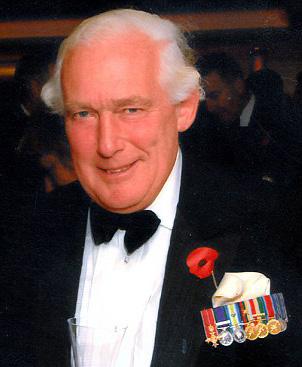
In particular, for decades Ewen has bombarded the editors of newspapers, magazines and journals with his opinions which are many and varied. Now he has collected these missives (and some essays) into book form and self-published in the hope that the resultant 224 pages will be “a book for the Christmas stocking (and) then the downstairs loo.”
The letters range from the frivolous to the seriously consequential. All are penned in a punchy, no-holds-barred style. Along the way all sorts of highlevel targets are identified and skewered with gusto, from the Chief of the Defence Staff to the Secretary of State for Defence, to the Foreign Office and the United Nations. A variety of politicians, journalists and historians ranging from Norman Tebbit and Michael Gove to
Max Hastings and Quentin Rees come under fire and, as the collection indicates, Ewen takes no prisoners.
Such letters are an increasing rarity in the age of transitory text messages, emails and social media, so they are valuable in themselves, not least to future chroniclers of our times. The added ingredient here is Ewen’s individualistic and often iconoclastic take on contemporary and past events. Much of the book relates to “historically thought-provoking” military operations in which Ewen featured such as the Falklands conflict. Here is a typical sample:
“With respect to my erstwhile colleague Robert Fox’s article on the Falklands, he is talking nonsense. The battle for Goose Green was not a ‘decisive hinge’ in the British expedition to take back the Falklands. It was a false objective forced upon the commander of 3 Commando Brigade in order to give the army and politicians, safe from shot and shell back at home, an early victory.”
Ewen is almost as trenchant on yachting matters. One of his achievements has been to set up the biannual Jester Challenge – a single-handed transatlantic experience for small craft and intrepid sailors or, as he puts it, “a modern experiment in old-fashioned self-reliance, self-sufficiency and personal responsibility.” On one occasion the Falmouth
Coastguard had the temerity to question the sense of the challenge in “incredibly rough seas.” A Southby- Tailyour letter soon after to Yachting Monthly was scathing: “Size is not necessarily a factor in seaworthiness…Much as I respect the Coastguard service, it does not help when they make uneducated, nannying comments without checking the truth.”
Southby-Tailyour has also been a prominent campaigner for a variety of causes. Perhaps most notably, in 2013-15 he took to the streets of Birmingham and London in support of Sgt Alexander Blackman, the Royal Marine convicted and jailed for the murder of a wounded Taliban fighter. The book is also full of letters designed to appeal to a reader’s sense of the ridiculous.
This is a book likely to entertain and exasperate in equal measure. Ewen Southby-Tailyour has many and wideranging views. He also has the virtue of being able to see the absurd for what it is which makes this an entertaining as well as a thought-provoking read. Here is a last example:
“I received recently a letter about my book HMS Fearless in which the reader complained of the smell of the pages. Perhaps all books should have the aroma of their subject matter in which case I shall arrange for the reprint to smell of burnt aviation fuel and frying chips!”

Phillip Plato, Chair of the OP Society and founding member of the OP Car and Motorcycle Club was contacted earlier in the year by Anthony Fenwick-Wilson (53-57) who at the age of 85 was retiring from the world of motor racing.
Anthony writes:
"The will is still very willing but at nearly 85, old Father Time has decreed that my motor racing days are now over. I suppose I can’t really complain though. Over the past nine years, ‘Rosita’, my 1935 straight-eight Railton, has proudly carried the Pangbourne flag round most of the country’s major circuits, with a moderate collection of tin pots, and not forgetting a few agricultural excursions into the tracks’ countryside.
I also have a classic Bentley, a 1953 ‘R’ Type called 'Burgundy Bess'. Vintage racing is a thriving sport, with some meetings attracting over 150 cars, from Edwardian aero-engined behemoths, to 1950s Formula 1 Coopers.
I had intended to celebrate my 85th with a few circuits of the wall-of-death on a 1932 ‘Indian’ motorcycle, but I would have had to go round at 40 m.p.h. to enable the centrifugal force to keep the bike from falling off the wall. The snag being that at that level of G-force, my rather over abused heart would
have possibly stopped – Ah well, short of reincarnation, it looks like a more sedentary and gentle life beckons."
However, Anthony can rest assured that the mantle has been passed on to our current generation of Pangbournians, and in particular, Leo Robinson, a current Year 10 pupil at the College. Leo has recently Joined the JHR Developments team in the F4 British Championship 2024. Leo has a multitude of national and international Karting titles to his name. In 2023 he moved into car racing, becoming the youngest ever race winner in the Ginetta Junior. Mid season he switched to the Danish F4
Championship, scoring 10 podiums in 10 starts and finished as the best points scorer in the second half of the season, finishing fourth in the Championship.
Leo will be making his F4 British Championship debut in April and is proud to race under the flag of his maternal nation, Algeria. He is grateful for the continued support of the FASM (Federation Algerienne des Sport Mécaniques).
If you have an interest in all things motorsport then why not join the OP Car & Motorcycle Club. Full details can be found on the Pangbournian Portal.


Notes: The OP Society agreed in 2018 to gradually redistribute funds in its bank account in the form of grants and donations to small OP projects and to Pangbourne College. With that in mind, a deficit in the balance sheet is likely in the years ahead.
President Mark Dumas (64-68)
Vice President Merrick Rayner (68-73)
Honorary Vice Presidents Robin Knight (56-61)
Robin Paine (55-58)
Richard Shuttleworth (57-62)
Ian Williams (61-63)
Chairman Rory Copinger-Symes (79-83)
Secretary Chris Stott (71-78)
Treasurer Tarka Duhalde (95-98)
Elected Members Theodore Isaacs (78-85)
Georgia Misson (07-12)
Gary Rimay-Muranyi (82-87)
Henry Byrom (22-24)
Phillip Plato (73-77)
Notes: Decade Representatives encourage fellow OPs to attend events, plan decade-specific events and act as a link to the OP Society Committee. If you are interested in representing the 1940s, 1950s or 2020s, please email alumnirelations@pangbourne.com
UK - South
UK - South West
Argentina
Australia
Canada
Mike Askwith (59-64)
Edward Bence (66-70)
Charles Pettit (Buenos Aires)
Paddy Evelegh (Perth)
Roger Pike (Sydney)
Geoff Rae (Brisbane)
Alex Heaton (Melbourne)
James Mackenzie (Vancouver)
Cyprus Louis Carrel
Malaysia Alex Tilley
New Zealand
South Africa
Graham Jex
Shaun Maynard (Johannesburg)
Geoff Popple (Cape Town)
Uganda Andrew Nzeyi
United States
Charles Bown (Chicago)
Nick Gillette (California)
Gyles Thornely (Colorado)
1940s Vacant
1950s Robin Paine (55-58)
1960s David Nicholson (64-68)
1970s Phillip Plato (73-78)
1980s William Skinner (82-87)
1990s Claire Morphy (90-92)
2000s Paul Lawrence (04-08)
2010s Larry Howard (05-11)
2020s Nick Vousden (14-21)
Head of Development Lucinda Grafton lucinda.grafton@pangbourne.com
Development Office Lucinda Grafton lucinda.grafton@pangbourne.com
Pangbournian
Magazine & News Matt Allen
Community Relations Officer Sue Carpenter sue.carpenter@pangbourne.com
Magazine Content Sue Carpenter sue.carpenter@pangbourne.com
Yacht Club Peter Kewish (84-89)
Golf Society Charlie Parry (81-85)
City / London Group Robin Batt (61-64)
Over 60’s Group Mark Dumas (64-68)
Military Group (MOPs) D. P. Holloway (94-99)
OP Rugby Club Sam Hewick (06-08)
OP Nautics Georgia Misson (07-12)
Classic Car & Motorcycle Phillip Plato (73-77)
Construction & Property Network Phillip Plato (73-77)
Notes: OP Overseas Representatives act as a point of contact for OPs visiting their area. Occasionally they organise events. If you live abroad and would like to take on this role, please email alumnirelations@pangbourne.com In addition, the OP Society is seeking to establish regional UK groups. If you would like to act as a representative, please contact alumnirelations@pangbourne.com
The following is a summary of obituaries published in 2024, written and collated by Robin Knight. Fuller accounts may be read on the Pangbournian Portal.

John Colin Evans (47-49) died on 11 May 2023 aged 90.
John arrived at the Nautical College in January 1947 from Harrow County School. The Lent Term that year is probably the coldest term ever recorded at the College. On leaving the College he spent three terms teaching at St. John’s College, Nassau in the Bahamas, before joining the Royal Canadian Navy in June 1951 on a short service appointment, where he was selected for flight training. On leaving the service John enjoyed a long career in civil aviation, starting out as the personal pilot of Habib Bourguiba, Tunisia’s first president.
John eventually retired to the U.K. where he kept fit by walking, gardening, travelling, and in the words of his widow, “remaining intellectually curious, an interesting and stimulating
companion, a loyal friend and a loving husband.”
Allan Wentworth Stewart-FitzRoy (48-53) died at home on 14 June 2024 following a fall. He was 89. He left a wife Susan, three daughters, seven grandchildren and two greatgrandchildren. Allan arrived at Pangbourne in the Winter Term 1948 with the objective of entering BRNC Dartmouth four or five years later.
Allan flourished at the NCP and was Chief Cadet Captain of the College in Winter Term 1952.

Gaining entry to BRNC Dartmouth by the Special Entry route in October 1952, he left the NCP at the end of Lent Term 1953. By Founders’ Day 1953 he was already at Dartmouth. Given two days’ leave to return to the NCP, the Duke of Edinburgh presented him with the first Queen’s Gold Medal of the Elizabethan era.
In retirement Allan played golf, but his main passion was spending time on the water in Chichester Harbour in his boat Sapphire. A member of Emsworth

Sailing Club since the 1970s, he became a fixture in the club to the day he died. “He was particularly adept at going out in his little boat with lots of rope on board so that he could rescue others who got into difficulty,” Louise recalls. “He really was a much-loved character in that environment.”

Ian Calvert Wood (50-53) died peacefully in Melbourne, Australia on 7 January 2024. He was 87 and is survived by his two sons Martin and Julian.
At the Nautical College, Ian was in Macquarie Division and Form MN and won his colours in the 1953 1st X1
cricket team as a bowler, once taking 8-46 in the match against the OPs. He also was awarded the RLSS Bronze Medallion twice for his life-saving skills. In later life he often spoke fondly of his time at Pangbourne.
Joining Blue Star Shipping Lines, he went on to have a distinguished career at sea. In 1968 he married Nicole Marie Laflamme in Montreal, Canada. The couple moved to Australia in 1969. Ian retired in 2011 aged 75.

Philip Peter Belgeonne (51-56) was born in Brussels, of Belgian parents on 29 January 1938. He died peacefully on 21 April 2024. He is survived by five children, 18 grandchildren and six greatgrandchildren!
At Pangbourne he became Chief Cadet Captain of the College, a role of which he was very proud. In 1957 Phillip passed into the Royal Navy and spent two years and a term at the Britannia Royal Naval College, Dartmouth. Philip left the Navy in 1968, first joining the Abu Dhabi Defence Force for three years to command its helicopter squadron. After Abu Dhabi he moved into civil aviation, gaining his fixed and rotary wing commercial licences. He had 11 years in Nigeria as Managing Director of a Shreiner Airways subsidiary, Aero Contractors of Nigeria, before returning
to the UK to take Executive Sales Director roles for corporate aircraft with Eagle Beachcraft and British Aerospace. He retired in 1999, became active in the British Legion and was a keen church bell ringer.

Michael Wellby (53-57) died on 18 September 2023 as the OP Society was informed by his daughter Kate Wooding. He was 83 and left a widow Frances, a daughter and a son.
At the NCP Michael was in Macquarie Division and became a Cadet Captain in Winter Term 1956. A member of the boxing team for three years, he captained it in 1956 and 1957. Aged 13, he was the only cadet who could climb the full height of the ropes hanging in the gym just using his arms. Reaching Form VIc, he gained A Levels in History, Physics and Maths, an unusual combination for the time.
Michael Matthews (54-59) died on 19 May 2024 aged 83. He was a retired naval Captain who served in the Royal Navy from 1959-1995. He left a widow Delphine and two children, Nicolette and Mark. Having sat a scholarship exam to the Nautical College Pangbourne as a late would-be entrant, and been awarded a Clan Line Scholarship, he entered the NCP in September 1954. He later

went on to win a Naval scholarship to Dartmouth. Mike retired from the RN in 1995 at the age of 55 after 36 years’ service.
Nick Edwards (55-58), for many years the OP representative in New Zealand, died on 20 August 2023, aged 81. He had not been well for some time. He is survived by his wife Yoko, their son, John Paul, and their daughter, Mieko.

Robin Paine (55-58) writes: “Nick joined the NCP in the Summer Term of 1955 and became a member of Harbinger Division. After O Levels in 1958, he left the NCP to join the British India Steam Navigation Company.
Nick left BISC and joined the China Navigation Company. Soon after he joined CNC he married Yoko, who was working in the company’s office. He was to remain with CNC for 32 years. In 1997, aged 55, Nick retired to Auckland, New Zealand, where he had made his home several years previously.
Michael Ernest Winter (55-59) died peacefully on 9 March 2024 following a long illness. He was 82 and left a wife Rosie, two children and five grandchildren. Mike came from a South Coast family and from a young age wanted to join the Royal Navy.
Unfortunately, his father died when he was eight years old and a pupil at Portsmouth Grammar School, which put his future in doubt. Sponsored by the Freemasons, however, he arrived at the Nautical College in Lent Term 1955 when he was almost 14 years old. At the College he rose to become a Cadet Captain in Harbinger Division.
From Pangbourne he entered BRNC Dartmouth in September 1959 and
decided to specialise as a Weapons Engineer in the submarine branch. On retiring from the RN in 1994, Mike worked for the Security Service in London for a time.
Michael Ralph Lubbock MBE (57-61) died at his home in Scotland Neck, North Carolina,USA on September 7, 2024 at the age of 80. He is survived by his wife Ali and his son Brent.
He had been suffering from poor health in recent years and was unable to travel to the UK in 2024 to receive an MBE award from King Charles III. Mike arrived at The Nautical College from Kestrels, a small prep school in Devon in 1957. He was in Hesperus Division and became a valued member of both the 1st XI cricket teams in 1959 and 1960 (in which he bowled skilfully flighted left arm slow turners) and the cross-country running team in 1960 and 1961, representing Berkshire in the 1961 English Schools championship.


According to Ali, he had fond memories of Pangbourne and kept his 1st XI Colours cap close by him to the end of his days.
Philip W. Midwinter (61-65) died on 26 December 2023 He was aged 75 and, with his wife Alison, had two children Jeremy and Pippa. At the Nautical College Philip was in Harbinger Division and won the Maitland Cup in 1965. Along with at least 18 other OPs in the 1965-68 period, he joined the P&O shipping line after the NCP.
At some point in the early 1970s he left the sea and moved ashore. The 1993 issue of The Pangbournian recorded that in 1991 he had purchased a guest house called Low Jock Scar and six acres near Kendal in Cumbria The next that is heard from Philip was a letter to the OP Society in 2003. “We’ve been up here for 12 years now and our country guesthouse business is going very well and we survived the (2001) foot-andmouth crisis”. Eventually the Midwinters sold up and moved south to the Crawley
area. Philip became a volunteer at Crawley Open House for the homeless. Contributions on the website Much Loved after his death described him as “a special man,” stating that “he was always wanting to help others. He is missed by many.”

Tim Peers (75-80) died at home in Hambleden, Buckinghamshire surrounded by his family on July 18th 2024 aged 62 as reported to the College by his sister Muffin Hurst. The funeral was held at St Mary the Virgin Church, Hambleden on August 13th .
Tim came from a family well known in the rock music industry. He entered the College in September 1975 from Cothill School in Abingdon. At Pangbourne he became a Cadet Leader in Port Jackson Division and was a member of the Upper VI form. He excelled at Hockey and was Captain of the 1st XI in 1980 as well as representing the school at Tennis,Squash and Cricket. Richard Norris, the master-in-charge of Hockey at the time, described him in The Log as “a tireless, if slightly over-excited, captain... He worked harder than any and was a good host to all our guests.”

David Herbert (44-24) passed away at home on 7 January 2024 aged 79. He was a Governor of Pangbourne College from 2003-2016. His wife Bethan died in 2000. He left a son Simon, a daughter Karen and four grandchildren.
After a long career in banking David became involved in financial consultancy work. As a consequence, he was asked by Michael Allsop, then Chairman of the Board of Governors of Pangbourne College, to do some work in the early 2000s. By the end of this time David had become very involved in the day-to-day

operations of the College. He became a Governor of the College and later took over the important role of Chair of the Finance Committee. He very much enjoyed his involvement with the College. David was also a keen golfer and passionate Welsh rugby fan.
We would like to sincerely apologise for an error in our last edition of the magazine. The photograph accompanying the obituary notice for Robert Edward Mason (52-55) was incorrect and was in fact his brother Ralph Mason (55-59). We would like to thank Mr Mason for bringing this to our attention and supplying us with a photograph of his brother Robert.


On 22 June, a concert marked a special moment for Pangbourne Choral Society and its evolution into an independent choir reaching out into the wider community, delivering a consistently high standard of performance across a substantial repertoire, spanning all the major choral classics and modern songs.
Great achievements for a non-auditioned community choir, many of whom start out unable to read music.
The evening’s programme sought to celebrate a broad repertoire, supported by three past music directors, including PCS founder Ralph Allwood, Bob Barsby, and Jonathan Brown, who
between them developed PCS from its College roots into a well-established choral ensemble, boasting many successes, and attracting numerous star soloists. The 107-strong choir included Pangbourne College Head Thomas Garnier in his final term and – when they were not conducting – both Ralph Allwood and Jonathan Brown.

It is hard to summarise a programme so rich in variety and choral excellence. Ralph Allwood conducted Handel’s Zadok the Priest and Haydn’s The Heavens are Telling from The Creation, recalling some of the first pieces ever performed by PCS.
Jonathan Brown conducted his favourite Wie Lieblich from Brahms' German Requiem and Mendelssohn’s On the Wings of Song, which epitomises this concert.
‘On Wings of Song we send you the best our hearts can give’ could well be the motto of PCS in this homage to the fellowship of community singing.
Sara Benbow, in her first year with PCS, introduced a range of celebratory pieces from Howells’ Jubilate to Bob Chilcott’s Shenandoah, and the American anthem How Can I Keep from Singing, yet again
evoking that intense feeling of musical togetherness.
But perhaps the most poignant work was The Call, written for the Narnia movie Prince Caspian. On the 80th anniversary of D-Day, this was dedicated to those Pangbourne students who gave their lives fighting for their country. The clue to how this fitted into the programme lies in the final lines:
I’ll come back when you call me, No need to say goodbye.
And that said it all: great singing - very controlled and committed - and a great team effort by this choir, all underpinned by a strong sense of union which called back music directors and many past members in a wonderful, deeply moving demonstration of the power of singing to promote lasting friendship and a deep sense of belonging. And what better way to end the evening than a roof-lifting performance of Parry’s I was glad, with a further group of past members coming up to enjoy a magical finale.
Apart from Ralph Allwood, there was one current PCS member who was there from the very beginning: Ian Busby, who stood up at the end and encouraged the audience to Come and Sing. Be sure that this choir will do all it can to pass on today’s legacy so that PCS will march on gloriously to its centenary in 2074!
What an enjoyable evening of fine choral music in splendid surroundings at Pangbourne College.







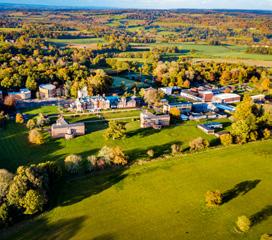
You can register for upcoming events, check important information, and see what’s new at community.pangbourne.com/events





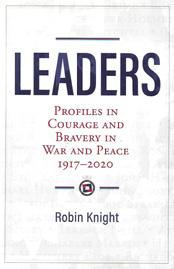





Wishing all our 2024 leavers the very best of luck

We look forward to seeing you back at Pangbourne as OPs